First published April 2019 | Words and photos by Vietnam Coracle | 24 comments
This post was last updated 6 years ago. Please check the comments section for possible updates, or read more on my Updates & Accuracy page.
INTRODUCTION | GUIDE | MAP | RELATED POSTS
A fascinating drop of land in the East Sea, Phu Quy is yet another of Vietnam’s previously ‘unknown’ islands that’s recently opened its doors to domestic and foreign travellers. A flat, green island rising gently to two volcanic peaks, Phu Quy is very isolated – far out in the ocean, 120km east of Phan Thiet on the mainland. Like other such islands in Vietnam, Phu Quy is on the cusp of a tourism boom: its name is on the lips of most young Vietnamese backpackers, and developers are scouting the island for suitable locations to build. There’s very little tourist development yet, but infrastructure – roads, ports, ferries – is all in place. As the island is still controlled by the military, until recently all foreign travellers had to obtain a permit to visit Phu Quy. However, as of September 2020, this is no longer required. There are daily fast boats from the mainland, good, cheap guest houses, beautiful bays, beaches and island vistas, inexpensive seafood, hospitable people, dozens of local temples, empty coast roads, and an exhilarating sense of isolation. Now is the time to visit.
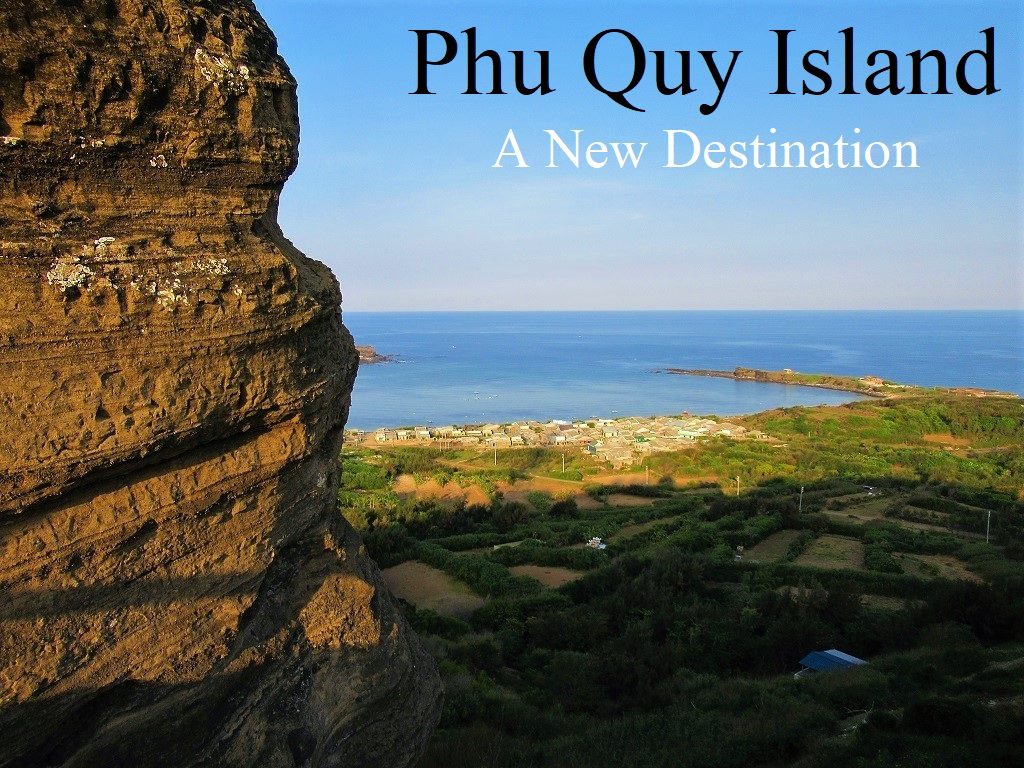
Phu Quy Island is a new & exciting destination for travellers: now is the tme to visit
[Back Top]
GUIDE: PHU QUY ISLAND
Below is my full guide to Phu Quy Island. I’ve divided this guide into several categories, and then sub-sections within each category. As of September 2020, foreign travellers no longer need a permit to visit the island. My favourite time of year to visit Phu Quy is from December to April, when the weather is generally dry, bright, and sunny, rainfall is light, and seas are calm. I’d also advise visiting on a weekday, because weekends and public holidays can get quite busy. I could happily spend a week on Phu Quy Island, but two nights is sufficient for those who haven’t the luxury of more time.

Click on a category below for more details:
CONTENTS:
MAP:
Phu Quy Island, Binh Thuan Province
View in a LARGER MAP
Location & Background:
Below I’ve written a description of the location and topography of Phu Quy Island and a little bit of history and background, followed by some information about the current state of the natural environment.

Phu Quy Island is still very quiet, calm, undeveloped & off the beaten path
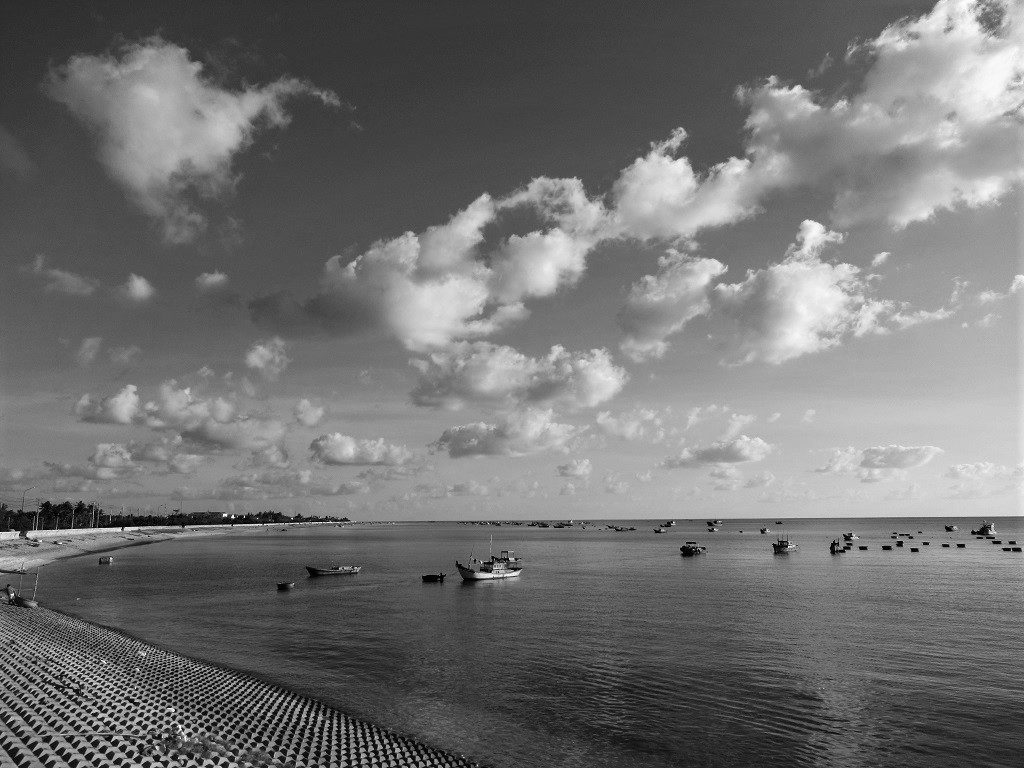
About 120km east of Phan Thiet, Phu Quy Island is way out there, all on its own in the East Sea. Đảo Phú Qúy, which means ‘Island of Precious Riches’ or ‘Rich and Precious Isle’ in Vietnamese, has only recently opened to tourism. The main island is but a drop in the ocean, with only a few other outlying islets, most of which are tiny outcrops, with the exception of Hon Tranh to the south of the main island. The topography and shape of Phu Quy resembles a naan bread: ovaloid, mostly flat, but rising here and there in almost undetectable undulations. There are two high points on the island: the lighthouse, in the northwest, and Cao Cat Mountain, in the northeast. The coastline consists of a series of long, open bays, broken only at the northern and southern tips of the island, where volcanic bluffs rise dramatically, forming striking escarpments. Inland, the island is green, agricultural, and forested. Fishing is obviously the main industry, but much of the land is farmed: portioned off into rectangular lots for growing fruit trees, such as banana, coconut, mango, and jackfruit. But the main crop on the island is pandanus tectorius, a type of screwpine which yields an exotic-looking, pineapple-like fruit used to make the island’s special brew. Approaching the coast, the land becomes more arid and sandy, but in the south, there are large grassy meadows along the cliffs, resembling a temperate coastline, such as the U.K, rather than a tropical one.
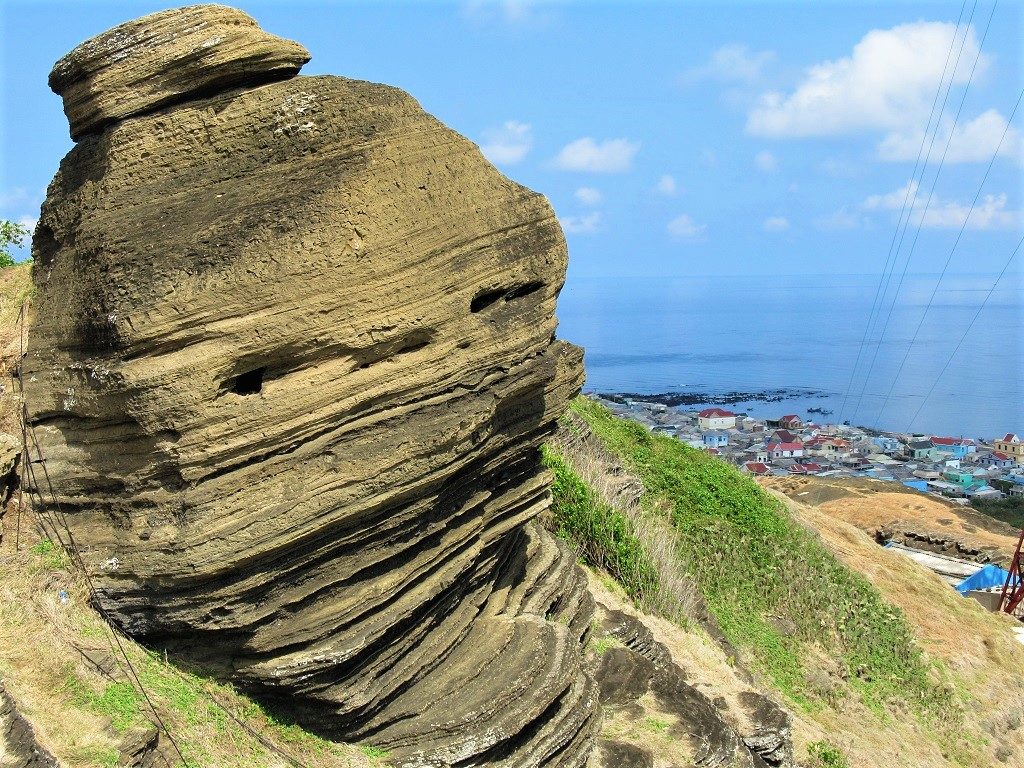
Phu Quy is remarkably flat except for two high drifts of volcanic rock, including fascination formations
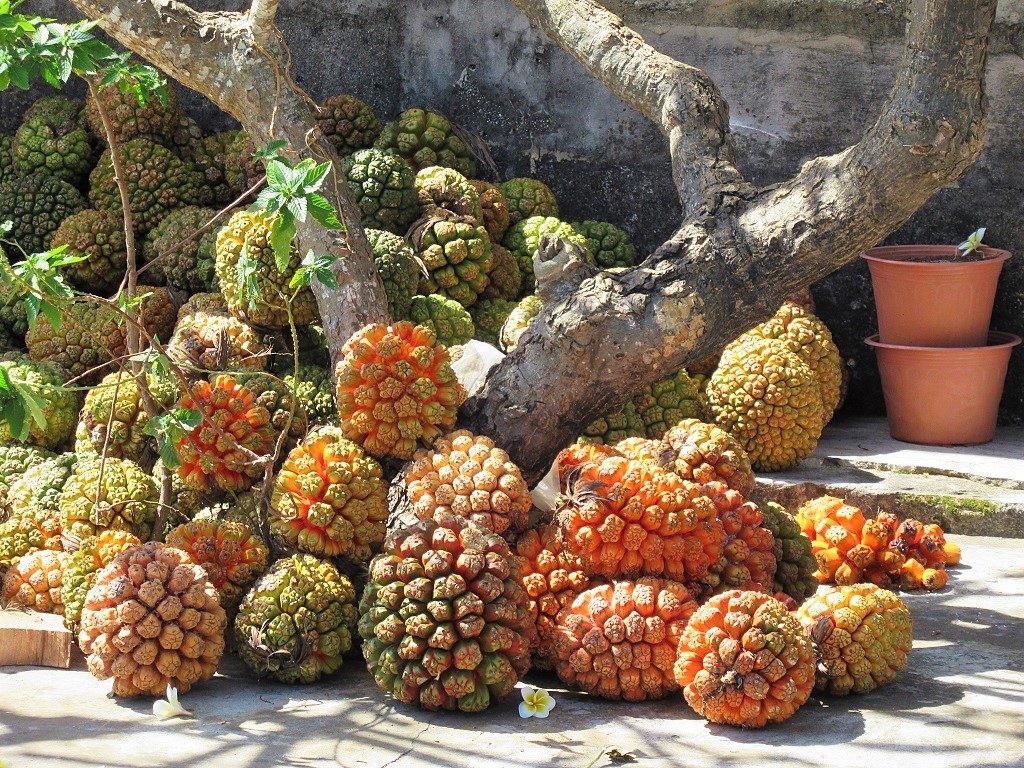
Phu Quy is surprisingly agricultural: the screwpine (pictured) grows everywhere on the island
Phu Quy appears to be a very pious place – the number of temples and shrines for such a small community is remarkable. Like many of the larger islands in Vietnam, Phu Quy has its own myths and legends. One goes that a beautiful Cham princess was exiled from the mainland by the Cham king for not obeying his commands. However, I’ve found it difficult to find any in-dept history about the island.* But there have probably been people living and fishing here for at least one or two millennia, as the island was in the ancient shipping lanes between India, Southeast Asia, and China (in fact, it’s still one of the busiest shipping lanes in the world today: giant tankers are a constant feature on the horizon). As well as a place of banishment (like so many of Vietnam’s islands), Phu Quy has also been a place of escape. Over the centuries, people have fled to the island to avoid persecution, prosecution, or oppression on the mainland. Ming officials from China, fleeing the rise of the Qing dynasty, also landed and settled on Phu Quy, before crossing over to the mainland. The colonial French, too, must have had a presence on the island. But, despite some very French-looking and -feeling compounds, I couldn’t find anything out about it – except that the French knew the island as Poulo-Cérci-de-Mer. The people of Phu Quy are famous for their open and friendly attitude. As a foreigner on the island, you’ll attract a lot of attention. Being so isolated, Phu Quy has developed its own culture, and the local accent is, to my ear, extremely idiosyncratic. It was noticeable, too, how young the mothers appeared to be on the island; or perhaps I’m just getting older.
*Please note: Historical information in this article is based on my reading of various sources & conversations with people: I am not an historian.
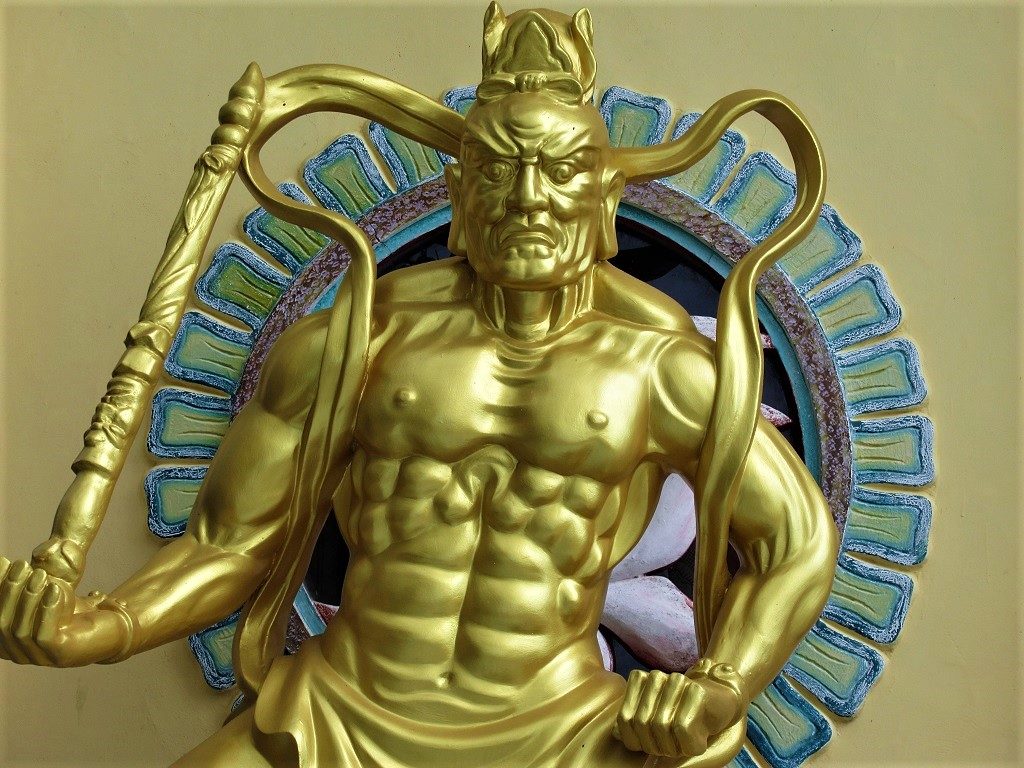
For a small island, Phu Quy has an extremely wide variety of religious buildings, temples & shrines
Phu Quy Island is a district within the province of Binh Thuan. As it’s technically a sea border area, there’s a significant military and official presence here. The island is divided into three xã (‘communes’), which are essentially the three main settlements on Phu Quy. These are: Tam Thanh, in the southwest of the island, the biggest and liveliest of the three, where the main fishing and commercial port is located, and most of the island’s accommodation and food options; Ngu Phung, in the west of the island, a quiet, very attractive little community with a small fishing fleet, under the watchful eye of Phu Quy lighthouse; and Long Hai, in the northeast, where a large, bustling, rugged and fairly rustic community live sprawled beneath the tortured rock formations of Cao Cat Mountain. The three communes account for most of Phu Quy’s 20,000 inhabitants, quite a large population compared to other islands in Vietnam. Infrastructure is good – paved roads criss-cross the island, harbours are protected by large breakers, exposed bays have been shored up with substantial embankments, and electricity and internet are everywhere. However, Phu Quy feels much smaller, quieter, slower, and less developed than most other Vietnamese islands of comparable size. For me, Phu Quy is like an island version of the mainland coastal province of Phu Yen: with all the the slow, rural charm, attractive fishing villages, rustic beach scenes, and picturesque seascapes of that province compacted into one tiny island. It’s a charming place to spend a few days.
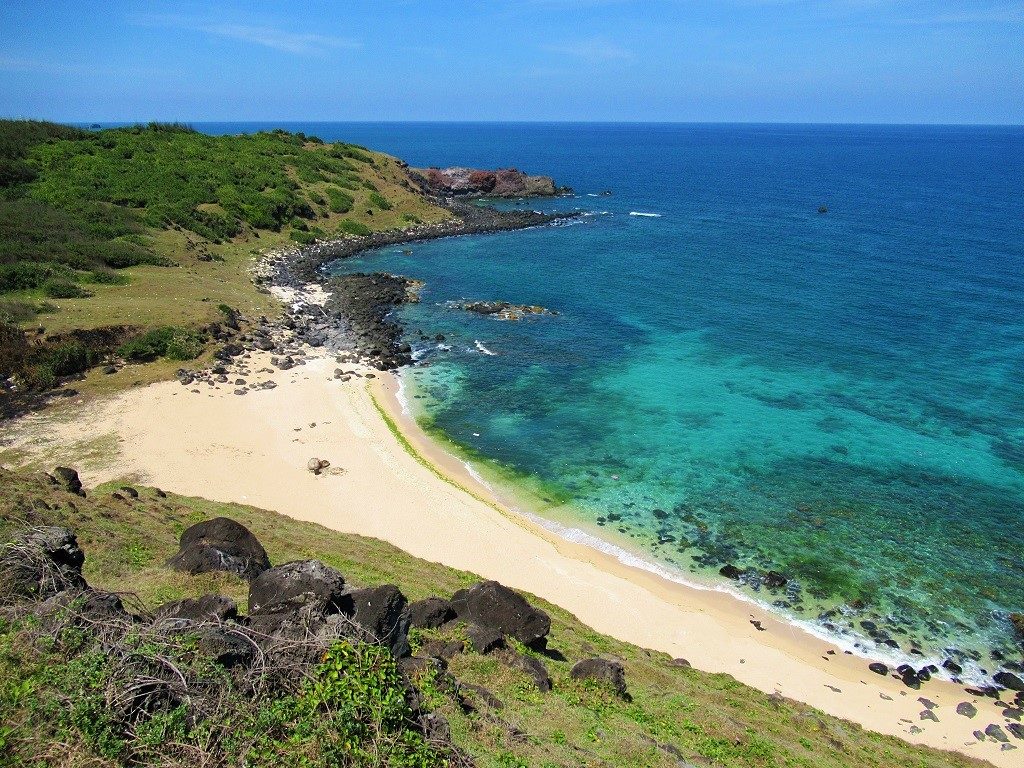
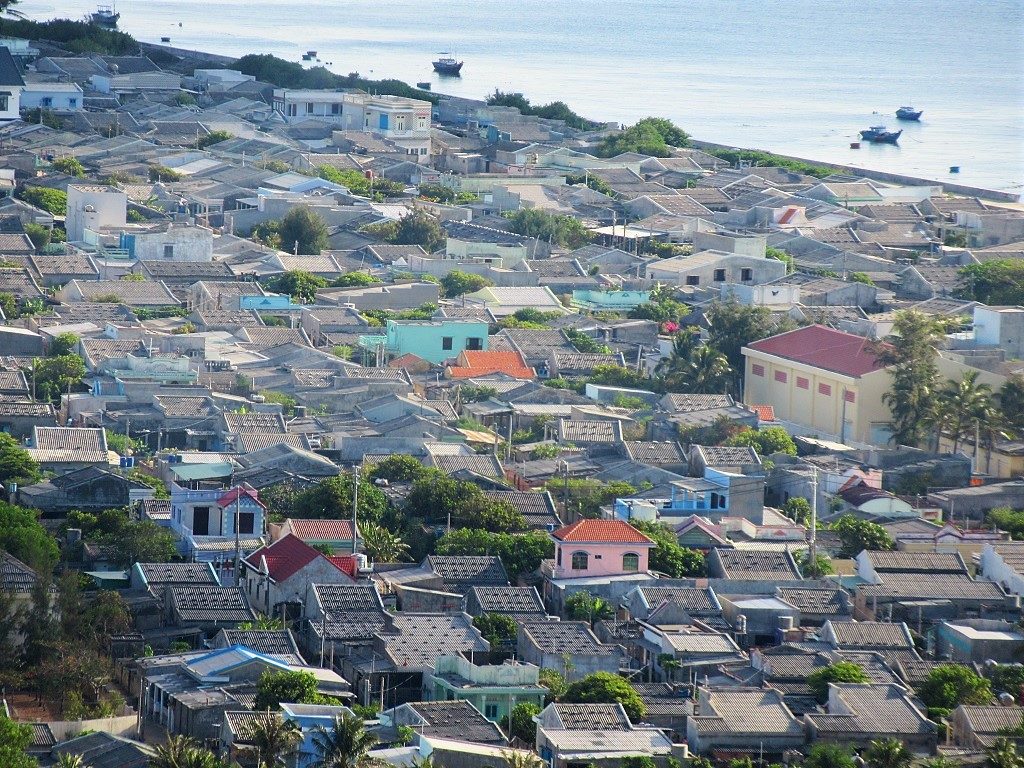
Phu Quy Island is divided into three ‘communes’ or villages, each of which has its own character
[Back]
Environment & Pollution:
Although Phu Quy is relatively clean and undeveloped, it is by no means pristine. Like many places in Vietnam, but particularly the islands, Phu Quy is facing some serious environmental problems. Plastic pollution – on the land and in the sea – is the most obvious and visible of these. Most of the beaches and bays, and forests and fields, on Phu Quy Island are tainted by plastic. Whether in the form of fishing-related detritus or household waste, Phu Quy is choking on plastic. But this is not unusual. If you’ve travelled extensively or lived in Vietnam, you’ll know that there are very few places left that are not blighted by plastic waste. So far, the water quality is still very good – some of the clearest water I’ve experienced in Vietnam – with the exception of the main harbour where the ferries dock and a large fishing fleet deposits all its waste directly into the sea. Even the coral and marine life, including colourful tropical fish and pretty sea flora, are still quite impressive. But on the beaches, whether sandy or rocky, there is always the presence of litter. Much of this is flotsam and jetsam, washed up from the wider ocean, but a great deal of it, especially around the fishing hamlets, in particular Long Hai, is simply household trash discarded by the local population. Indeed, one section is essentially a ‘plastic beach‘.

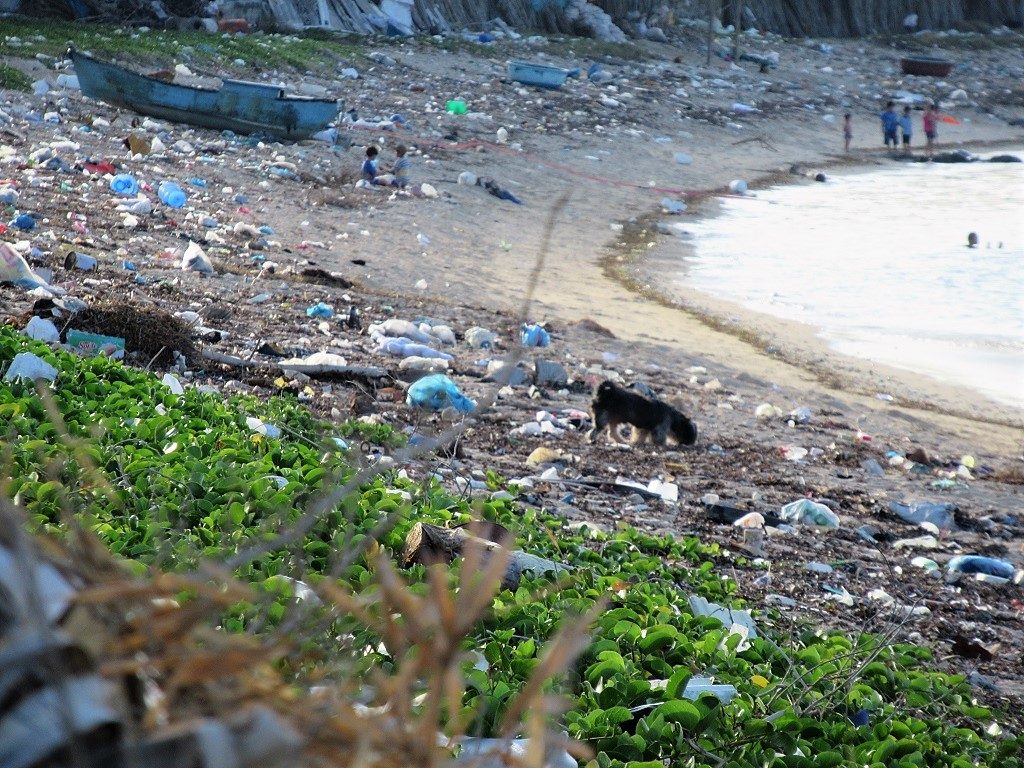
As with most other coastal regions of Vietnam, Phu Quy has a serious trash problem, especially plastic
There is a daily trash collection service on the island and a significant recycling area, which collects plastic bottles and tin cans, packages them up, and sends them on a ship back to the mainland. Three huge wind turbines in the north of the island suggest a move towards renewable energy for Phu Quy. There are also lots of government signs urging the population not to throw waste into the sea and on the land, and warning of the dire consequences this practice has for people’s health and the health of the ocean which provides much of the population with their living. But, so far, they appear to have had little impact. What’s particularly disturbing to me is that soon a whole generation will have grown up with ‘plastic beaches’ as the norm: they won’t even view plastic-strewn beaches as ‘polluted’ – for them, this is simply what a beach is. I think this is clear in the completely unselfconscious way that people (of all generations) throw their trash in the sea and on the land. I think, and I hope, that it will get better, but I also think it’s possible that things will get worse before they get better. Phu Quy is set to become a trendy backpacker destination for Vietnamese youth. And, sadly, based on the appalling mess left behind in other popular backpacking hotspots across the nation (Dalat, Ha Giang, Nam Du, Phu Yen and many more), it seems like this will be a catalyst for even more irresponsibly discarded trash. None of us are blameless, of course. Just by visiting Phu Quy, I also create my own trash, even it I do throw it in the bins, not the sea. You can reduce the impact you have on the island by taking reusable items for daily use, such as a thermos, a straw, a bag etc. For more about what to use and where to buy these items, please read this.
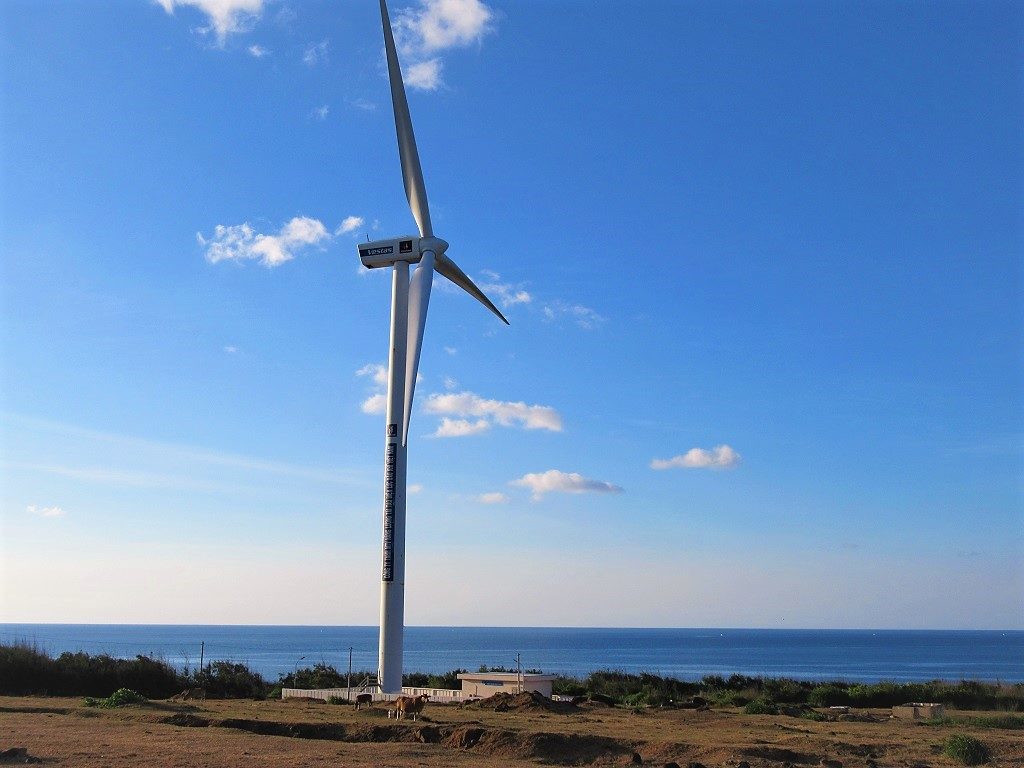
Phu Quy Island has three large wind turbines, which could indicate plans for green energy in the future

Phu Quy has a trash collection: some garbage is separated, bagged & sent to the mainland to be recycled
Beaches & Things to Do & See:
There are plenty of things to see and do on Phu Quy Island. The three main villages each have their own character, with temples, shrines, old houses, and fishing fleets; the island is ringed by a coast road with great sea views and access to lots of beaches and bays for swimming; several excellent short hikes lead to viewing platforms with stunning vistas, hilltop shrines, lighthouses, and fascinating rock formations; a couple of islets and reefs, reached by hired boat, offer good snorkeling and sandy beaches; and the inland network of small lanes leads through tropical fruit orchards. The best way to see, explore, and get around the island is by rented motorbike or bicycle, but walking is also good, and taxis can be arranged through your accommodation (see Getting Around for details):
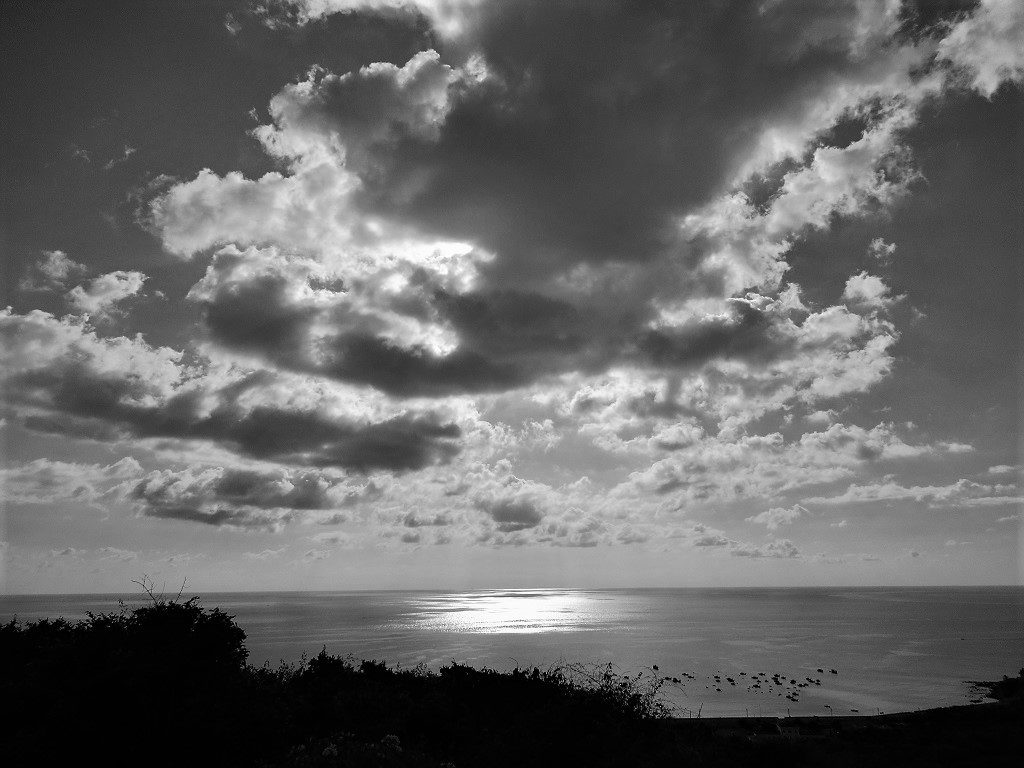
There’s plenty to see & do on Phu Quy Island for at least a couple of days
The sea around Phu Quy Island is excellent for swimming. The water quality is among the best and clearest I’ve swum in anywhere in Vietnam. There’s even some decent coral, beautiful marine flora, and colourful tropical fish. Much of the west coast of the island is either protected by long, concrete embankments or very rocky. However, swimming is still very good off the rocks, especially in the northwest (this was my favourite place to swim). The south and east coasts have plenty of wide, sandy beaches, including one or two excellent ones, as well as some dramatic rocky capes. Sadly, however, most of the long, sandy beaches in the south and east are covered in household trash from the villages, and flotsam and jetsam washed up from the ocean. It’s still easy to find a good, empty, clear place to swim on the island, but don’t expect pristine conditions everywhere you go. Below I’ve listed all of Phu Quy’s beaches in order of my personal preference.
- The Northwest
- Bai Nho Beach & Ganh Hang Cliff
- Ngu Phung Beach & Marina
- Vinh Trieu Duong Beach
- Dong Hai Beach
- Bai Da Cape
- Hon Tranh Islet
- Other Beaches

Although much of Phu Quy Island’s coastline is rocky, the water quality is some of the best in Vietnam
The Northwest [MAP]: Under the watchful eye of the hilltop lighthouse and the humming wind turbines, the northwestern corner of Phu Quy is rugged and captivating. As the coast road lifts around a rocky cape, there are sandy paths leading through casuarina trees to exposed bays of pebbles, dead coral, and black volcanic rock. When I was here, the sea was calm and still, and access to the water was fairly easy through the rocks. Once in the water (with my goggles on), I could gaze at brightly coloured fish that swam between yellow and silver sea bushes, and starfish hiding in deep, narrow, underwater canyons. The water is clear and cool; the swimming good. The stoney beach is exposed, so it’s best to swim here in the mornings or late afternoons, when the sunsets are fantastic. There’s a disused, bricked-up military bunker here, too. The litter is mild on this beach because it’s away for the main villages, but the casuarina forests are strewn with picnic trash.

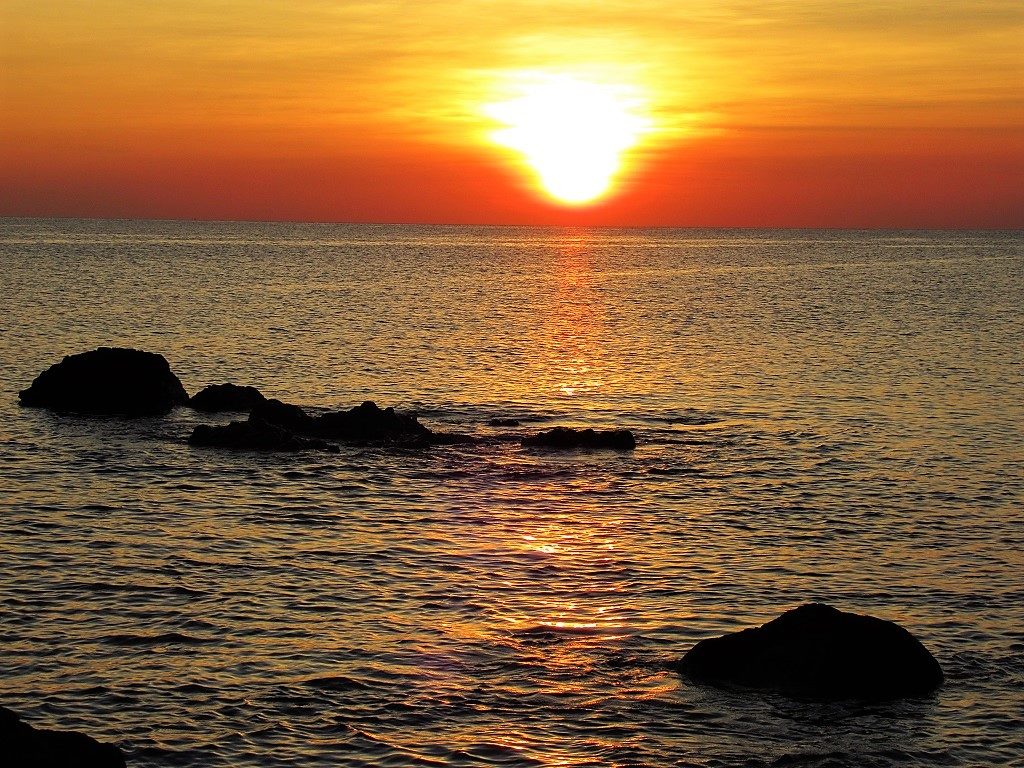
I enjoyed swimming off the pebbly beach in the quiet northwest of Phu Quy Island
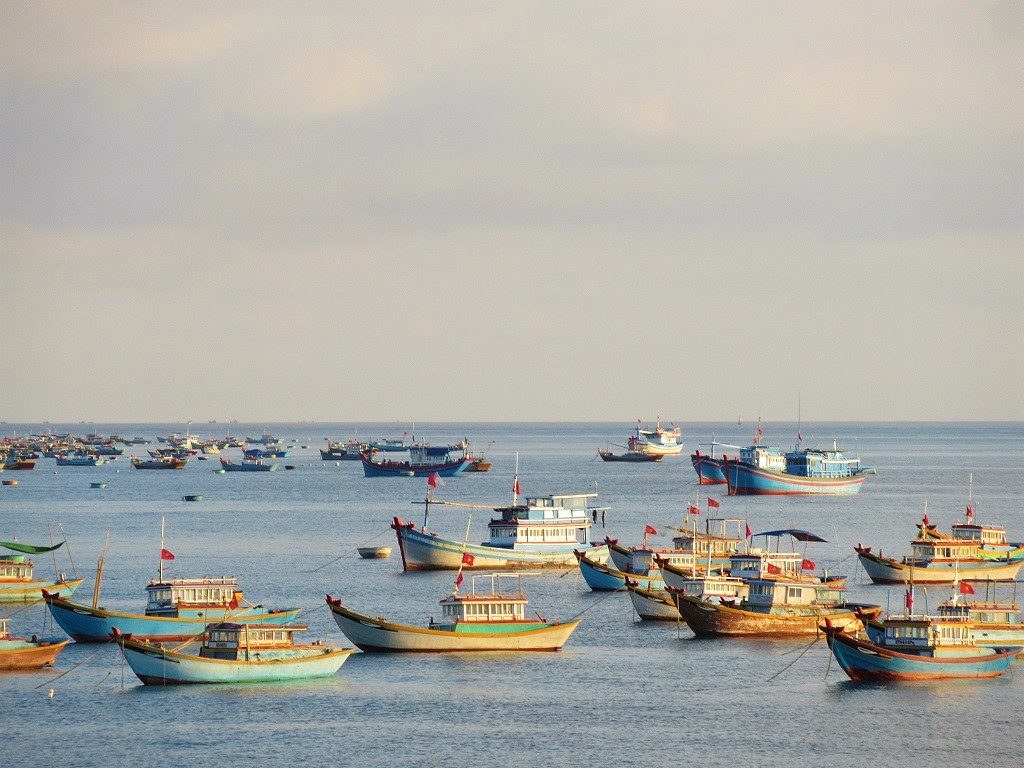
The northwest coast is calm & swimmable (at least during the first half of the year)
[Back]
Bai Nho Beach & Gành Hang Cliff [MAP]: Accessed via a steep, grassy pathway from the road, Bai Nho Beach is a slice of white sand and black rocks in the shadow of the Phu Quy Flagpole. At the southwestern tip of the island, the coast here is weather-beaten and barren: the exposed bluffs are treeless, covered in a heather-like brush. The water is clear and bright-blue where the white sand slides under the surf, but out in the bay it becomes bruised where large submerged rocks lurk beneath the swell. The sunshine brings out the vibrant tropical colours of this coastal scene; but when overcast, the coastline takes on a bleak, Hebridean quality. I found it a compelling spot: not only for swimming in the lovely water, but also for hiking along the rugged cliffs that stretch either side of the beach. Great volcanic escarpments, with swollen ruptures and gaping fissures, meet the sea where an old military bunker keeps a look out. Litter on Bai Nho Beach is in the form of a crust of flotsam and jetsam consisting of polystyrene and fishing equipment washed up from the wider ocean.

Bai Nho is a strikingly beautiful beach accessed via a steep path just below Phu Quy Flagpole

The rugged & attractive coastal scenery continues north & south of Bai Nho Beach to Ganh Hang Cliff
[Back]
Ngu Phung Beach & Marina [MAP]: The road between Tam Thanh and Ngu Phung villages is a delightful, shady, quiet stretch of tarmac, passing by a walled marina and then onto a tree-lined boulevard, where a small park opens onto a small white sand beach. Although there’s litter in the park, the sand and sea here are still very attractive. Water quality is clear, the colour is bright blue, and the fine white sand is made up of old coral. It’s a small, working beach with a little boat yard at one end and a war-era Martyrs’ Cemetery at the other. It’s a very peaceful spot in the middle of a hot, lazy island day for a quick dip in the velvety ocean.

Ngu Phung commune has a little patch of good beach with white sand from eroded coral
[Back]
Vinh Trieu Duong Beach [MAP]: At the southern tip of the island, Vinh Trieu Duong should be one of the best beaches on the island. In fact, it probably was the best beach a few years ago, and maybe it will be again. But, for now, this wide, curving spread of white sand and bright blue, shallow water, is nowhere near as beautiful as it should be, thanks to: picnic trash. A favourite spot for islanders and visitors alike, the remains of hundreds of al fresco lunches and dinners lie strewn across the wide sands and the lovely shady stand of casuarina trees behind it. Vinh Trieu Duong is still a very attractive spot for a swim and a quiet drink under the trees, but it’s no longer pristine. I assume the beach will be cleaned up before long, and it looks like prime land for a resort. Oh well, at least then it will be looked after with more care and attention. (The harbour wall is currently being extended to the east of the bay, which might be a bit of an eyesore, but it will protect the beach from rough seas.)

Vinh Trieu Duong Beach is very attractive, but spoiled somewhat by picnic trash left on the sand
[Back]
Dong Hai Beach [MAP]: What I suppose is technically the island’s fourth village, Dong Hai is a collection of alleyways and fishing homes on the northeast coast. As you wind through the alleys, there are some remarkable old houses with attractive courtyards, white-washed facades that have faded in the rain and sun to pale pastel tones, and fishing nets, floats, hooks and other equipment hanging from the porches like lanterns. It’s a charming little hamlet and it fronts a pleasant strip of sandy beach backed by a grassy verge. As the community here is much smaller than the three main villages on the island, the level of household and fishing trash on the sand is much lighter. It’s well worth coming here to explore the alleys and architecture, if not to swim and snorkel in the bay. For me, the scene is redolent of Greek fishing communities on the Cycladic islands. Word must have gotten out about this spot, because when I was here (March 2019) a film crew were shooting day and night in a house on the beach.
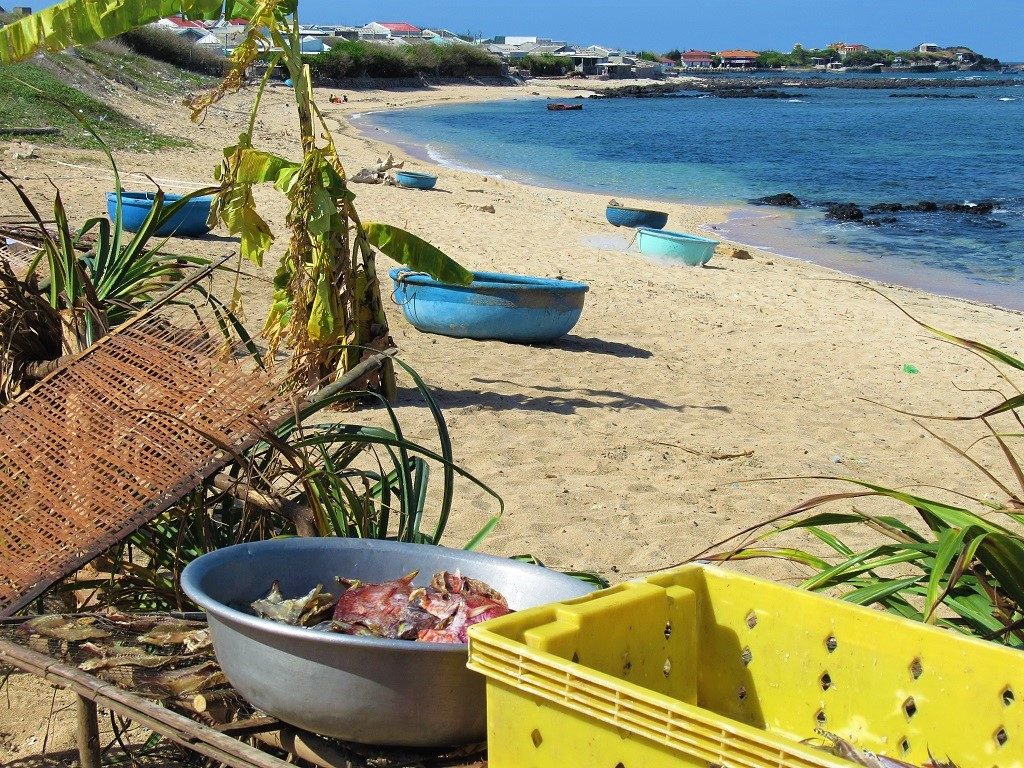
Dong Hai Beach is a beautiful spot backed by a grassy verge & an attractive hamlet
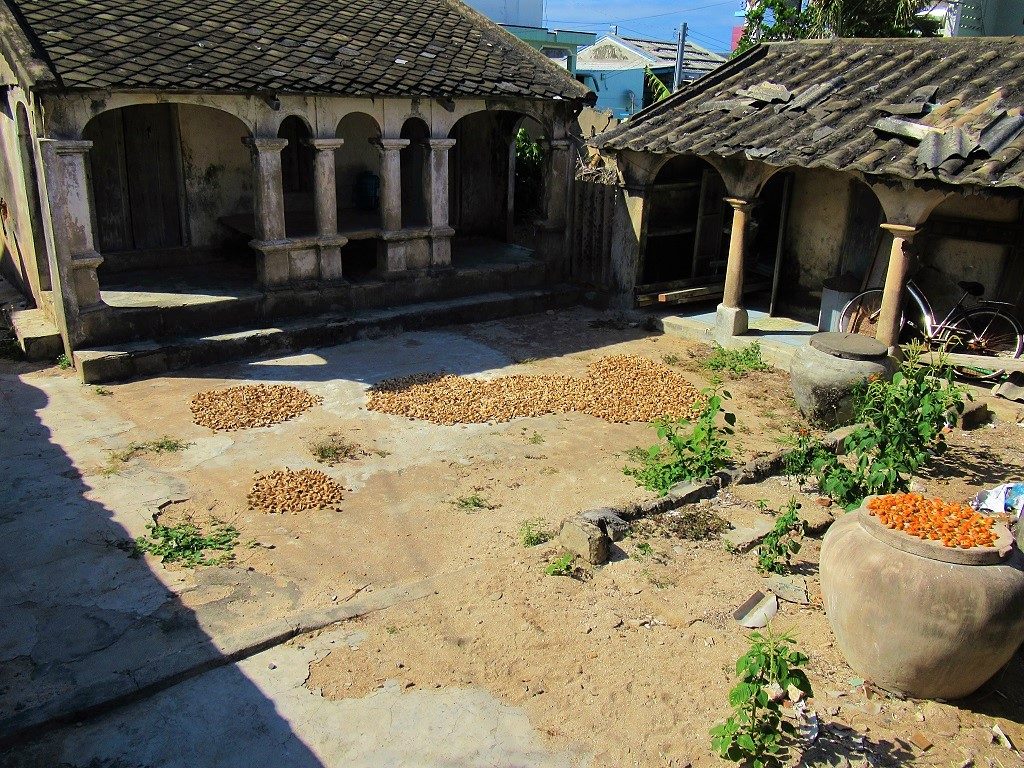
Dong Hai hamlet has some lovely old houses & courtyards near the beach
[Back]
Bai Da Cape [MAP]: Between Trieu Duong Bay and the Phu Quy Flagpole, a series of rocky cliffs jut out into the ocean at the island’s southeastern-most point. The cliffs form a dramatic seascape, with the waves churning the water and the views stretching far out to sea. The cliffs are carpeted in grass and very pleasant for hiking, although they are treeless and very exposed to sun, wind and rain. There are lots of signs of military activity here, including bunkers, trenches, and gun placements. The sea is clear and good for swimming on a calm day, but perilous when rough.
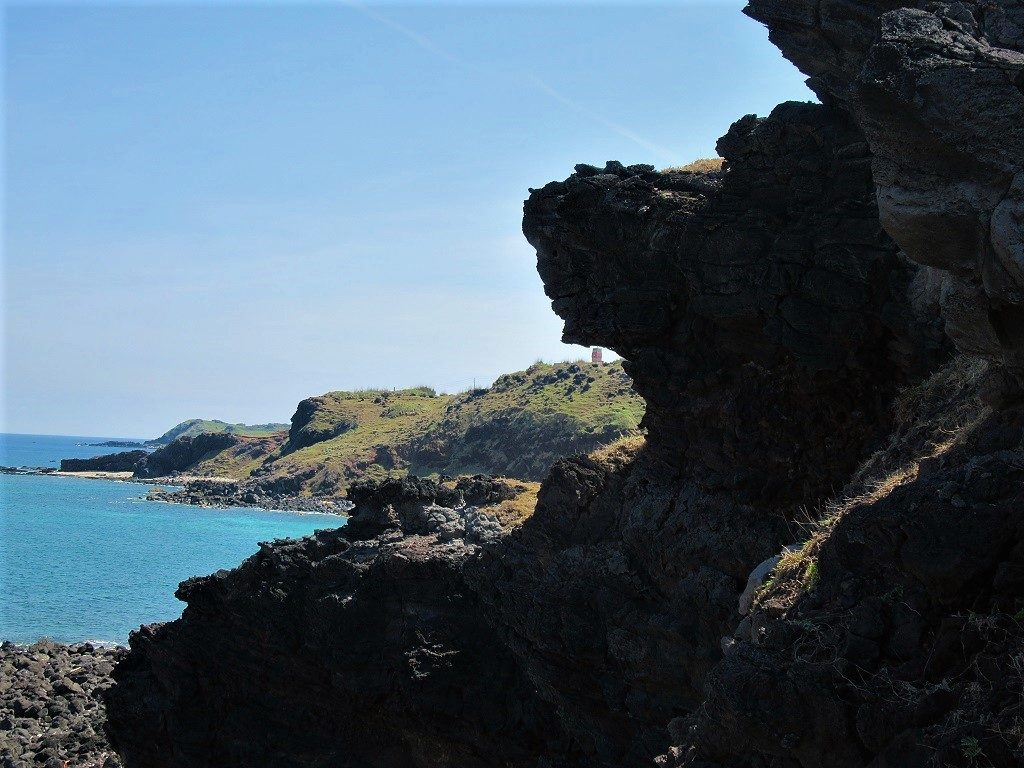
Bai Da Cape is rugged & rough with a desolate seascape that’s almost Hebridean
[Back]
Hon Tranh Islet [MAP]: Just off the southern tip of Phu Quy and easily visible (almost swimmable) from the port, Hon Tranh is a small, fish-shaped islet. With rocky, volcanic cliffs at the northern and southern ends, and an excellent white sand beach with crystal clear waters on both the western and eastern sides, Hon Tranh is definitely worth an excursions for a few hours. It should be easy to arrange a boat through your accommodation. Prices should be around 250,000vnd per person. But it might be significantly higher if you’re going alone or as a pair. A short ride takes you across the water from the mainland to the islet. The swimming and snorkeling are very good.
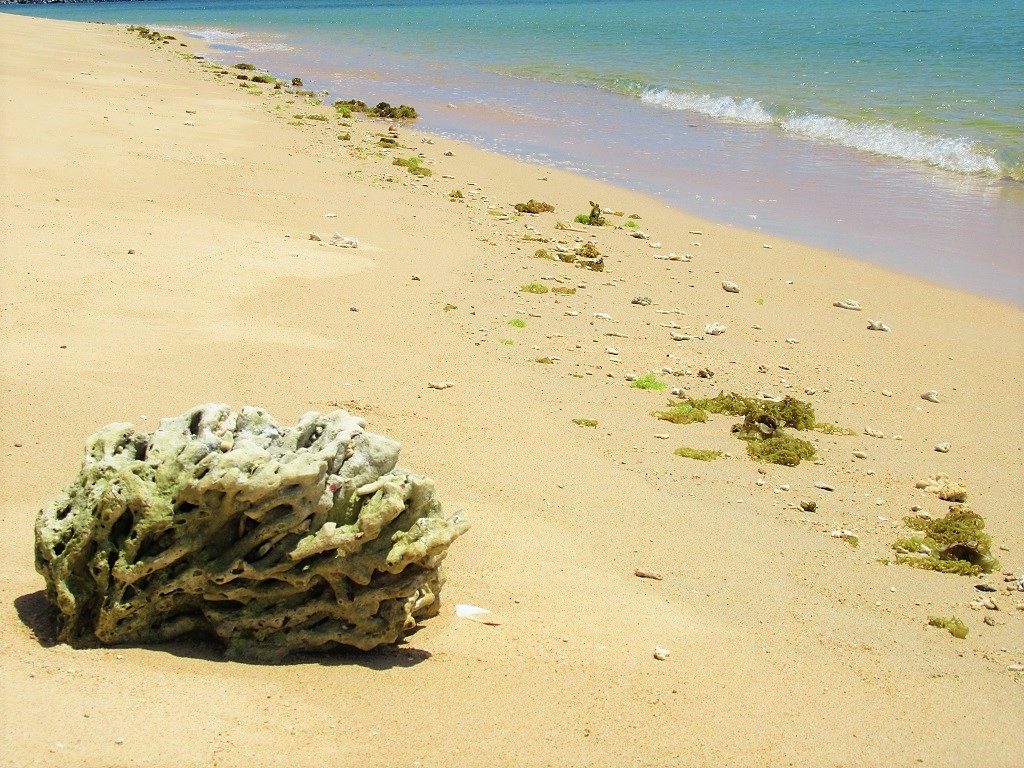
With a good, long & deserted beach, Hon Tranh Islet is just off the main island
[Back]
Other Beaches & Islets: The long, new embankment that stretches most of the way from the port, through Tam Thanh commune and on to Ngu Phung commune, is great for strolling along in the mornings and late afternoons. Temple-hopping between all the seaside shrines is good, too. But, although the sea is very pretty to look at and relatively clean, it’s not ideal for swimming because access is via a steep concrete ramp from the embankment. But it’s definitely worth exploring. Bai Phu is a series of arcing bays – some sandy, some rocky – on the east coast. Lovely to look at from afar, and famous for its floating seafood restaurants, unfortunately when you get up close it’s rather ruined by litter and fishing debris, either discarded or washed up on the surf. Again, it’s good for wandering around and hiking, but the swimming isn’t great. In the northeast of the island, the village of Long Hai sprawls beneath the slopes of Cao Cat Mountain and along the sandy beaches surrounding it. However, because Long Hai is an active fishing village and proper waste disposal (coupled with the general practice of throwing everything in the sea) has only recently been implemented, the beaches, although quite scenically located, are awfully polluted by plastic and general trash. It’s a sad, almost apocalyptic sight, but there are signs that it may get better: several recycling plants and government initiatives aim at cleaning the beaches here. It’s still possible to enjoy (and swim) on one section of the northeast beaches: the sandy bay spreading north from Mộ Thầy Temple, whose clifftop position provides a good vista of the beach.
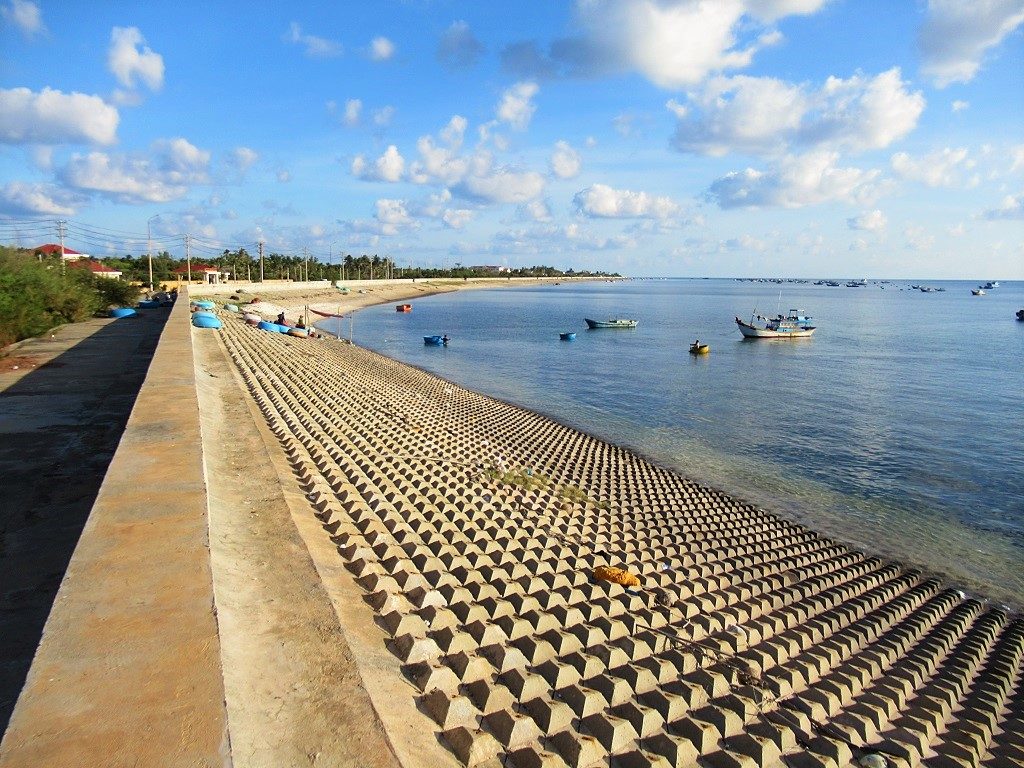
The embankment between Tam Thanh & Ngu Phung communes is scenic & great for a stroll

Bai Phu Beach looks attractive from afar, but up close it is blighted by litter

The beaches around Long Hai commune, in the north of the island, are full of household & fishing trash
[Back]
Villages & Communes:
Phu Quy Island is divided into three xã (‘communes’ or villages). These are Tam Thanh in the southwest, Ngu Phung on the central-west coast, and Long Hai in the north. Dong Hai, in the northeast, is a little hamlet that’s grown into what is essentially the island’s fourth village. In reality, Tam Thanh and Ngu Phung blend into one another, as do Long Hai and Dong Hai. But still each commune has its own character: its own temples, market, and local government edifices, and its own fishing fleet and harbour. Exploring the three (of four) communes on foot or on two wheels is very pleasant and interesting, and a great way to get under the skin of this remote island. Below, I’ve written a brief description of each village:

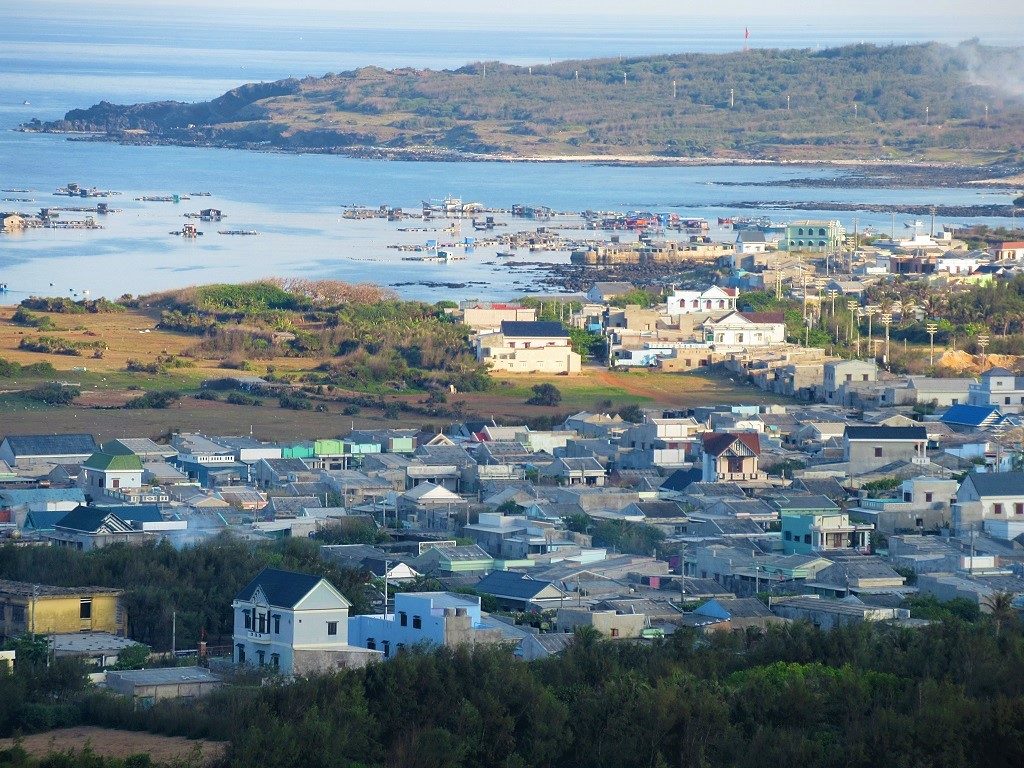
The island has three communes, each of which has its own market, places of worship & fishing fleet
Tam Thanh Commune [MAP]: Spreading west from Phu Quy harbour along the southeast coast, Tam Thanh is the focal point for most things on the island: commerce, fishing, ferries, food, accommodation, places of worship, and new development. Around the harbour there are several temples (see below), and the back streets either side of the port are pleasantly quiet, cool, shady and laid-back. Apart from the port, the main place of commerce and activity is on Vo Van Kiet Street (particularly around the intersection with Tran Hung Dao) and the grid of streets around the new park just to the north. This is where most of the island’s food and accommodation options are. There’s no shortage of general stores for water, snacks, electrical supplies etc. It’s at its liveliest in the mornings and late afternoons/evenings. The streets are lined with a combination of new townhouses (in the classic 21th century Vietnamese style: narrow, 2-3 storey boxes) and older dwellings bearing the hallmarks of Vietnamese Modernist architecture: angular and squat with little Art Deco flourishes (I find them very attractive). The latter date from the ’60s to ’90s (see below).

Tam Thanh commune is the focal point for commerce, fishing, food & accommodation on the island
[Back]
Ngu Phung Commune [MAP]: Although it’s difficult to determine where exactly Tam Thanh ends and Ngu Phung begins, the latter has a very different character. Whereas Tam Thanh is all commerce, business and development, Ngu Phung is sleepier and older with a ‘stuck-in-time’ feel about it. For me, the transition between these two communes on the west coast happens when 27 Thang 4 Street glances the ocean at Lang Co My Khe Temple and proceeds along a pleasant, casuarina-lined harbourfront, then on through a French-feeling boulevard and into the narrow, sun-and-shade-filled back-streets of Ngu Phung village. I can’t quite put my finger on it, but I loved Ngu Phung commune: The streets lined with umbrella trees and frangipani flowers; the decades-old Modernist homes with swept front yards leading to open wooden doors and front rooms filled with ancestor altars; the little lanes leading to the embankment where shrines and temples wax and wane in clouds of incense; the food and drink stalls hidden around corners where school children gather for snacks; the fading edifices of government buildings; fish drying on wooden trestles; a small military airport where the tarmac is used for raking crops; the fishing fleet at the north of the bay, idling on the calm sea in the late evening sun; the fishermen’s shacks selling fresh seafood; and the green patchwork of land rising to Phu Quy Lighthouse with views across the entire island.
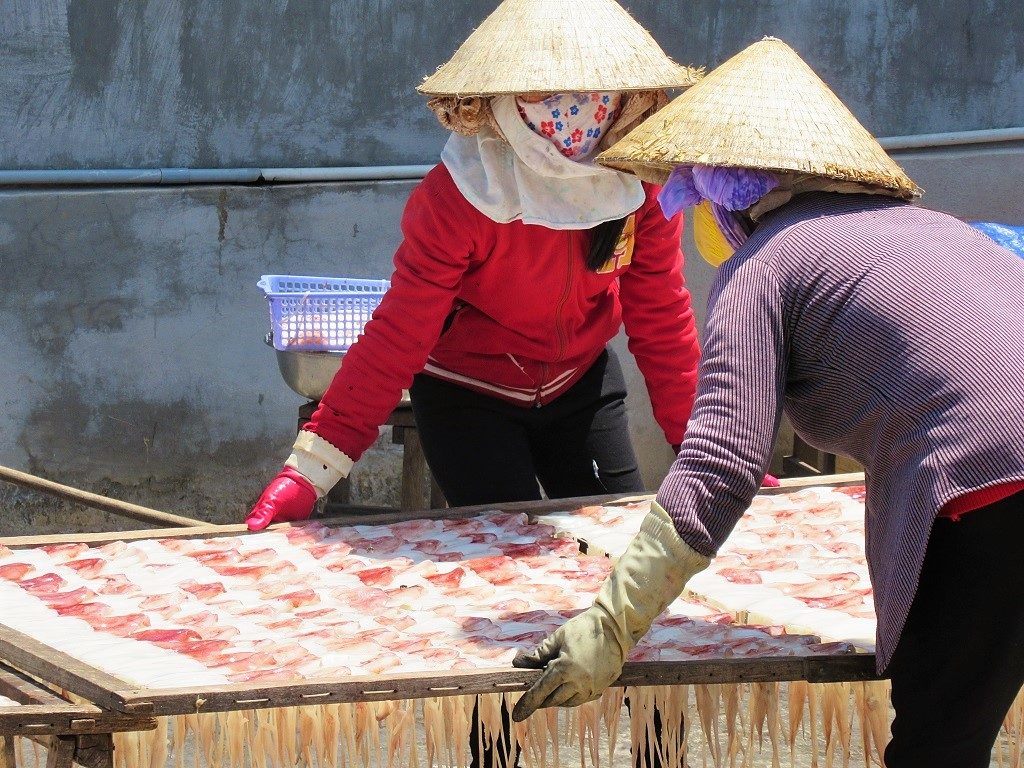
Ngu Phung is a quiet, very attractive & appealing commune with a friendly & slow atmosphere
[Back]
Long Hai Commune [MAP]: At the northeastern tip of Phu Quy, Long Hai is possibly the liveliest of the communes on the island. A tightly packed network of narrow lanes and single-storey, box-like homes spread around the base of Cao Cat Mountain, Long Hai has an active market with street food and a general buzz about it. Long Hai is also the most rustic, rugged, and, sadly, the most littered of the island’s villages. The beaches here are covered in trash, although the roads are clean and people’s housing looks OK, if cramped. It certainly feels as though Long Hai is the poorest of the communes on Phu Quy. But the people are very welcoming and excited to see foreign visitors, and several homes are starting to invite tourists in as part of a growing trend in homestays. When I visited, I felt Long Hai hadn’t the charm or the laid-back quality of Ngu Phung or Tam Thanh, but it does have lots of local life and opportunities to sit, eat, drink and talk with people. The views over Long Hai from the pagoda atop Cao Cat Mountain are superb (see below).
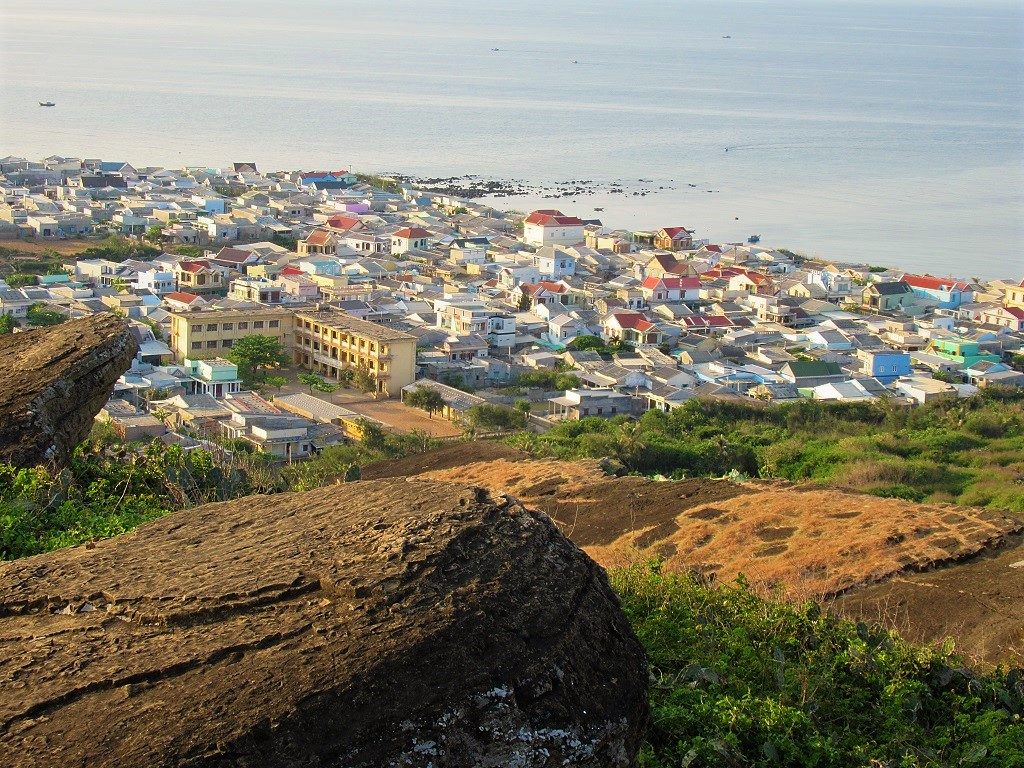
Long Hai sprawls beneath Cao Cat Mountain: it’s probably the liveliest but poorest of the communes
[Back]
Dong Hai Hamlet [MAP]: Phu Quy’s unofficial ‘fourth village’, Dong Hai is on the northeast coast, just south of Long Hai. A pretty and appealing little place with some interesting architecture and an attractive coast, see Dong Hai Beach for details.
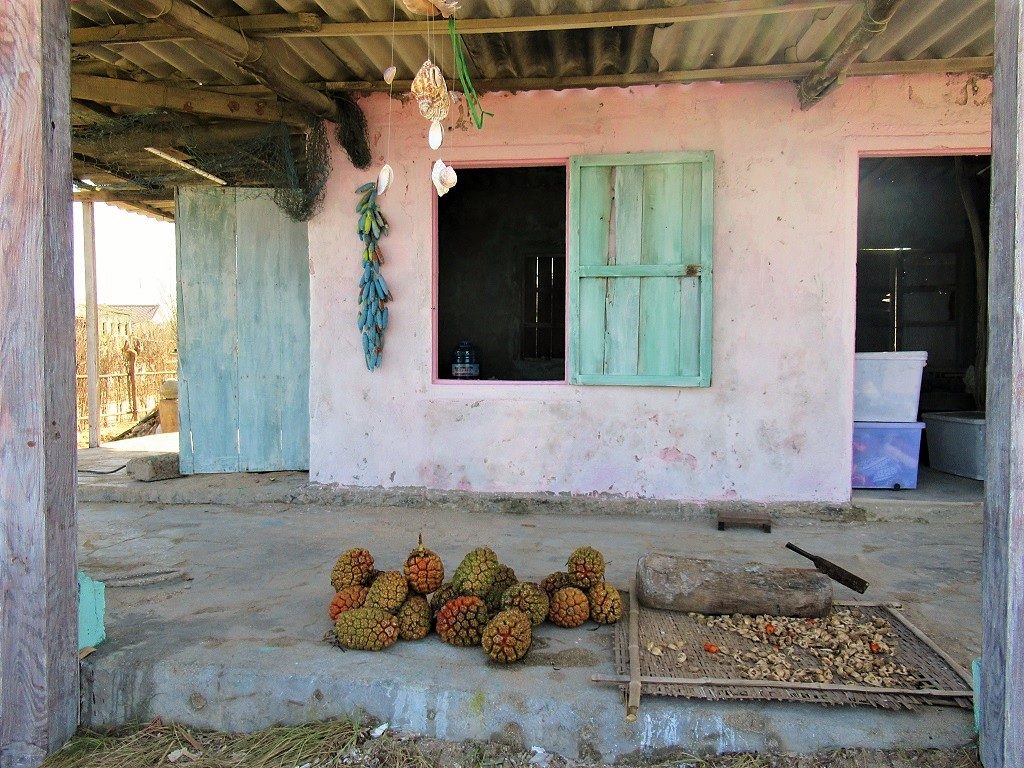
Dong Hai is the unofficial fourth hamlet on the island: an interesting little place with some cute houses
[Back]
Temples, Pagodas & Architecture:
For such a small island, Phu Quy has a remarkable number of temples, shrines and other places of worship. Each of the three communes boasts an array of religious buildings: from mountaintop monasteries to communal village temples. Most are very well-kept, with quiet, leafy grounds and colourful adornments. They’re all active places of worship, including Buddhist sanctuaries, Catholic churches, ancestor shrines, and Cao Dao temples. I’ve listed some of the more interesting, attractive, and striking below, but there are many more. Also, riding around Phu Quy, I found the architecture of people’s homes and government buildings to be intriguing. Most are what I think is correctly termed Vietnamese Modernist-style, spanning half a century, from the 1960s through to the early 2000s. Angular and modern, but with touches of French colonial architecture and Soviet Brutalism, these buildings are well-preserved, but it looks are though many are just about to be torn down. There are even a few very old-looking homes with mini-courtyards and tiled roofs supported by columns.

- Van An Thanh Whale Temple
- Chua Linh Quang Pagoda
- Thanh That Cao Dai Temple
- Dai Mon Mo Thay Temple
- Chua Linh Son Pagoda
- Modernist Architecture

Dozens of temples, shrines, pagodas & other places of worship are scattered about Phu Quy Island
Van An Thanh Whale Temple [MAP]: Often referred to as Lăng Nam Hải or the ‘Whale Temple’, this attractive complex of gates, temples, altars and courtyards is just behind Phu Quy Port. Accessed from the north or the south, Van An Thanh is most notable for it enormous whale skeleton, which is housed in an exhibition room to the side of the main temple (look for the wooden doors with the words ‘Nhà Trưng Bày Cốt Ông Nam Hải‘ above it). Whale worship is a long and active tradition in Vietnam, stretching back centuries. Whales are considered gods or spirits of the ocean that can protect sailors and fishermen from harm while out at sea. There are two words for ‘whale’ in Vietnamese which reflect the mammal’s size and importance: Cá voi (elephant fish) and Ông Nam Hải (grandfather of the sea). Inside the ‘whale temple’, the scale of the skeleton is breathtaking. I’m used to seeing whales in the ocean (in TV documentaries), where there’s very little sense of scale. But here, in this exhibition room, one really gets a sense of just how colossal these animals are, and it’s no wonder they were (and are) considered sacred. I found it quite moving, not least because the experience felt very similar to gazing at dinosaur skeletons in natural history museums, when one feels overwhelmed that an animal of such size once existed on the same planet where one is living today. There’s an unsettling pathos that, perhaps, my children or grandchildren might stand in front of a whale skeleton like this one and be thinking the same thing: imagine a world where mammals like this lived in our oceans.
The main whale on display died in 1963. But there are other smaller skeletons around it of whales and dolphins, some of which date back 150 years. It’s a nice idea to light some incense at the altar beneath the whale’s jaw. Note: although the temple complex is always open, the ‘whale room’ is almost always closed. There are two phone numbers (0908 846 774 or 0163 4700 427) on a blue plaque at the bottom of the temple gate at the south entrance, which you must call in order for the ‘whale keeper’ to come open the doors for you. No English is spoken so it might be a good idea to ask the staff at your hotel to call and arrange a time for you. It’s well worth it. Entrance is free, but donations are appreciated.

Van An Thanh ‘Whale Temple’ houses a large skeleton of a whale & many other smaller ones, too
[Back]
Chua Linh Quang Pagoda [MAP] is one of the most recognizable temples on the island. On Vo Van Kiet Street in the centre of Tam Thanh commune, this temple boasts an impressive, highly decorated, multi-level tower. Although it appears to be a fairly recent structure, apparently the original temple dates back about 250 years. Easily visible from just about anywhere one the island, Chua Linh Quang is one of the tallest structures on Phu Quy. With colourful and ornate dragons, tiles, pillars, reliefs and statues, it’s a real riot and a lot of fun. A few blocks south of here, on the seafront embankment, is Mieu Thanh Hoang Shrine [MAP]. I love the peace and quiet of this little temple: the crispy, rust-red leaves of the umbrella trees falling on the hot stone courtyard; the sound of the gentle sea lapping the harbourfront; and the way the entrance gates frame the placid ocean, as if it were the terminal of an ancient and exotic Southeast Asian trading port.
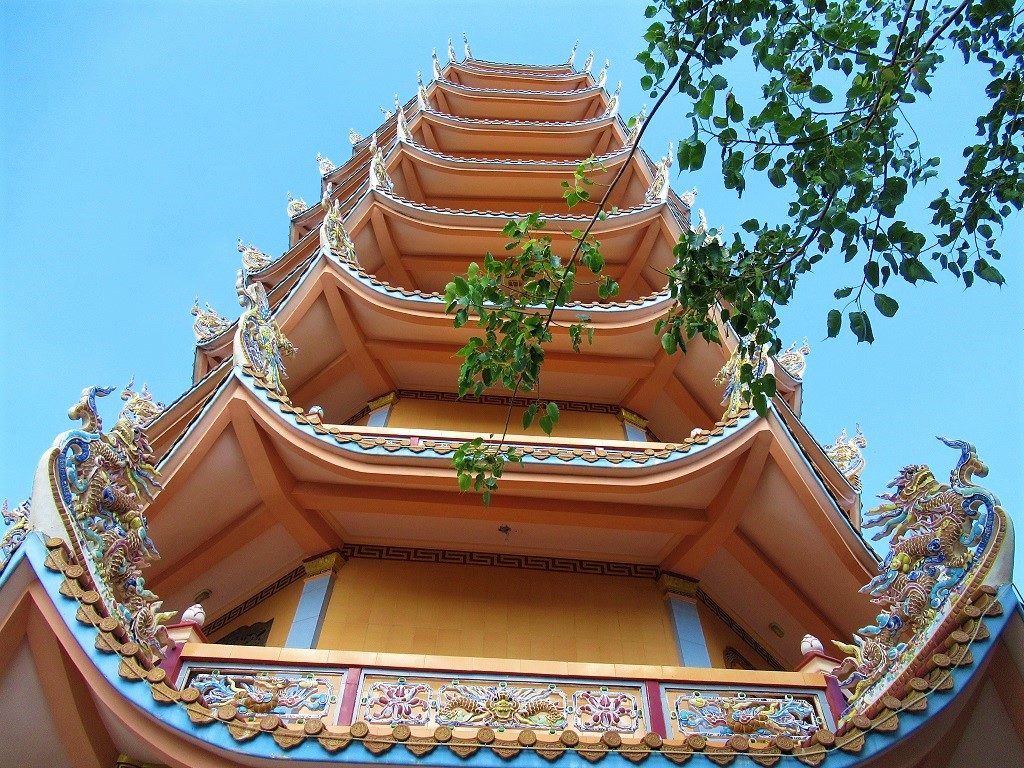
Chua Linh Quang is an ornate pagoda & one of the tallest structures on Phu Quy Island

Mieu Thanh Hoang Shrine sits right by the ocean; its stone courtyard is a quiet, reflective place
[Back]
There are several interesting places of worship in and around Ngu Phung commune. Thanh That [MAP] is Phu Quy Island’s Cao Dai temple, the century-old, home-grown religion, worshiping the religious and creative icons of world history, including Muhammad, Buddha, Shakespeare and Victor Hugo. Caodaist temples are famous for being colourful and decorative, and this one’s no exception. There’s a Catholic church [MAP] is the back-streets, and Chua Linh Buu [MAP] is an ornate and attractive Buddhist temple set among trees at the foot of the hill beneath the Phu Quy Lighthouse.

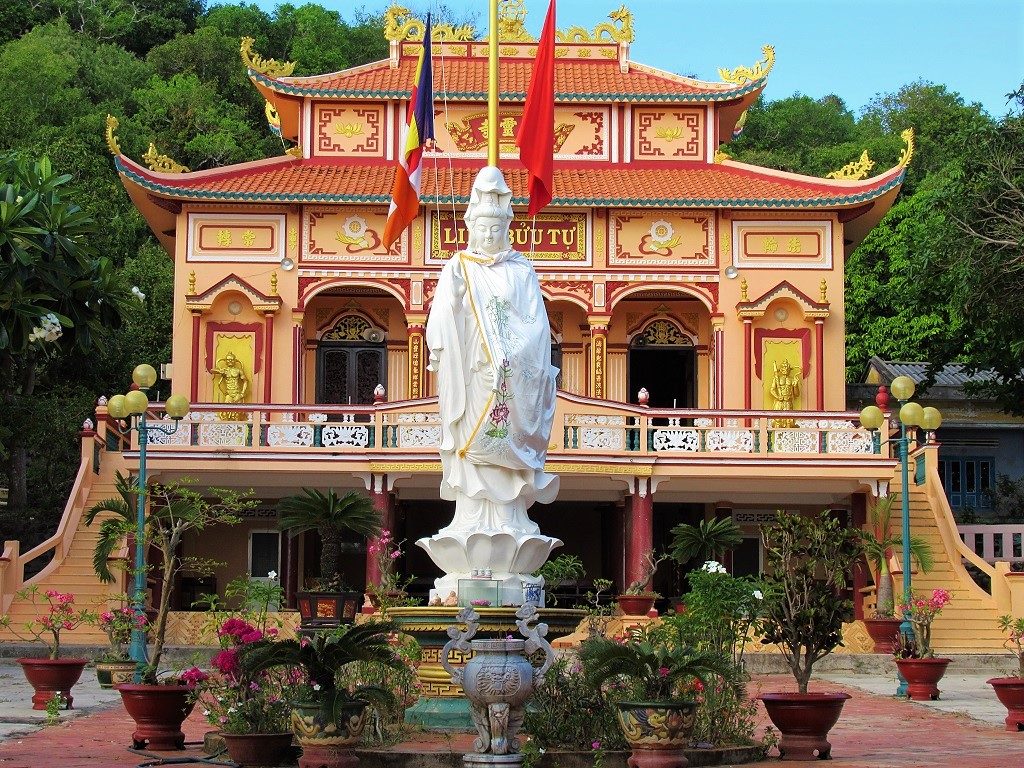
Chua Linh Buu is a Buddhist temple set among trees beneath the Phu Quy Lighthouse
[Back]
Perched on a mesmerizing volcanic rock cape in the northeast of the island, Đại Môn Mộ Thầy [MAP] is an interesting temple in a scenic position. I couldn’t find out much about it, but the name means something like ‘The Master’s Tomb’, which is mysterious enough to fuel your imagination. But more than the temple, it’s the location that’s the main attraction. Continue walking along the peninsular to the very tip and look back at a beautiful double bay. The rock formations here are fascinating and the sea has carved out little overhangs – like petrified waves – where locals gather for picnics. (Unfortunately, there’s a lot of trash around.) Another intriguing sight here are the fish farms clinging to the rocky coast. A series of rectangular stone walls, the fish farms look as though they’re ancient ramparts protecting the island from attack by sea.

Dai Mon Mo Thay temple is set on a volcanic headland surrounded by walled fish farms (pictured)
[Back]
You couldn’t find a more stunning position for a temple than Chua Linh Son Pagoda [MAP]. Accessed via a steep staircase, the main temple is a monastery just below the peak of Cao Cat Mountain, the highest point on the island. The stairs are guarded by golden dragons, which are a sight to behold when set against the pink shower of bougainvillea. At the top, Buddhist monks go about their ablutions in the prayer rooms and elaborately decorated altars. There are benches on which to sit and gaze out over the island. But save your photos for the shrine at the peak, reached via a curling set of stairs, leading around incredible volcanic rock formations with swirling fissures. From here the views are something else. Try to get here around 4pm to watch the sunset. I spent hours sitting on the rocks at the peak: reading, writing, contemplating, strumming my guitar, soaking in the views.

Chua Linh Son is dramatically situated near the top of Cao Cat Mountain, with fine views
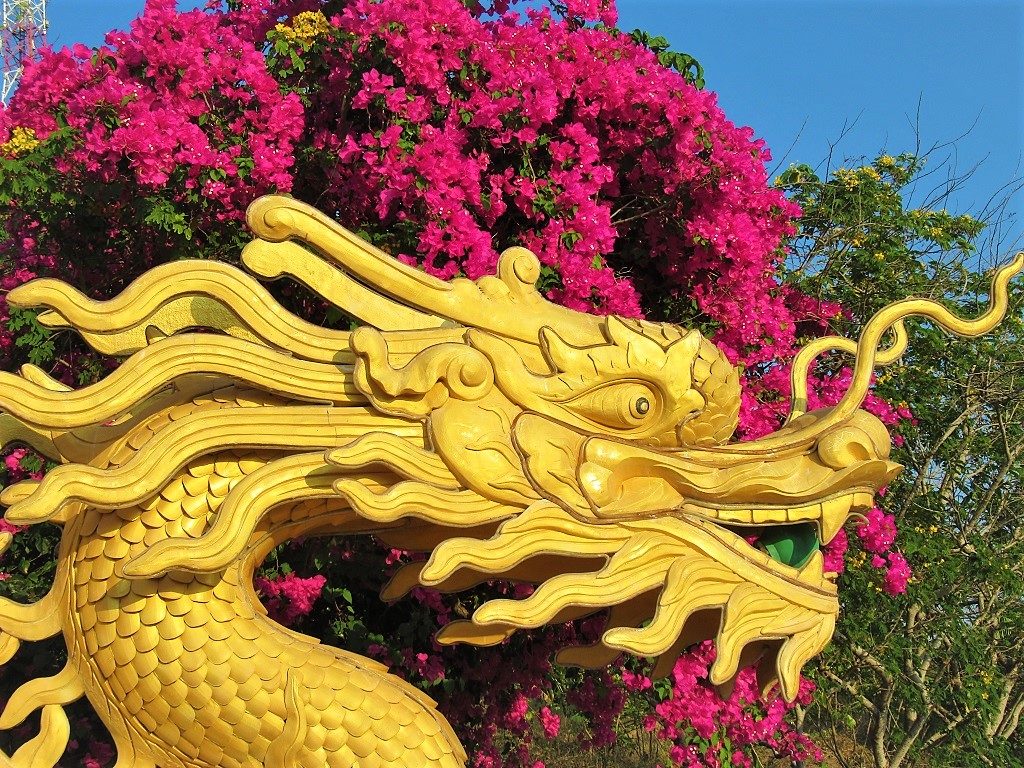
The steps leading up to Chua Linh Son are guarded by golden dragons & bougainvillea
[Back]
Modernist Architecture: All around the island, but particularly along the streets of Tam Thanh and Ngu Phung communes, there are excellent examples of Vietnamese Modernist architecture. This takes the form of residents’ homes and of local government buildings. In the past, I always felt as though this architectural style was too cold, stylized, and geometric to be sympathetic. But now I find myself drawn to it: partly because, as time goes by, these houses and civic buildings have become a part of history, imbued with nostalgia; but also partly because, thanks to various people drawing attention to the style in recent years, I’ve opened up to the line, decorative motifs, space, light and air of these buildings. I really can’t claim to know anything much about Vietnamese Modernist architecture, but you’ll see what I mean as you ride around Phu Quy Island. Some of the homes and government buildings are very well kept, whereas others are fading, soon to become rubble. Many of the houses have dates on them: ranging from as early as the 1960s to as late as the early 2000s. If this sparks your interest, check out Mel Schenck’s blog about Vietnamese Modernist buildings.
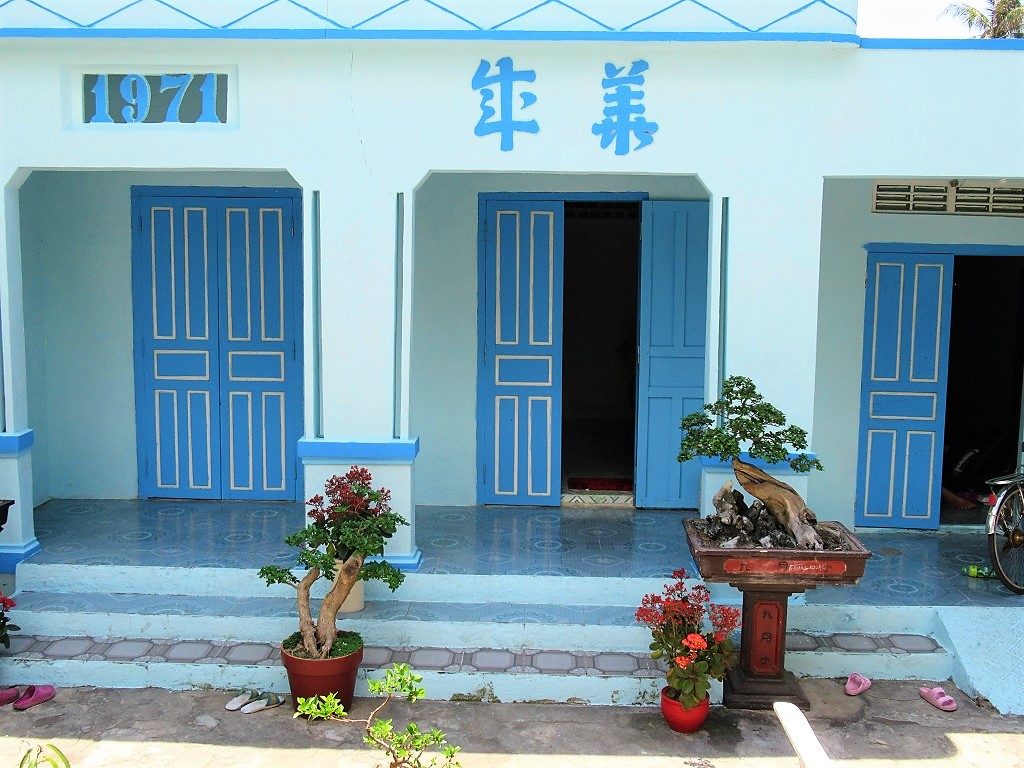
Phu Quy has dozens of older homes in the Vietnamese Modernist style, dating from the 1960s onwards
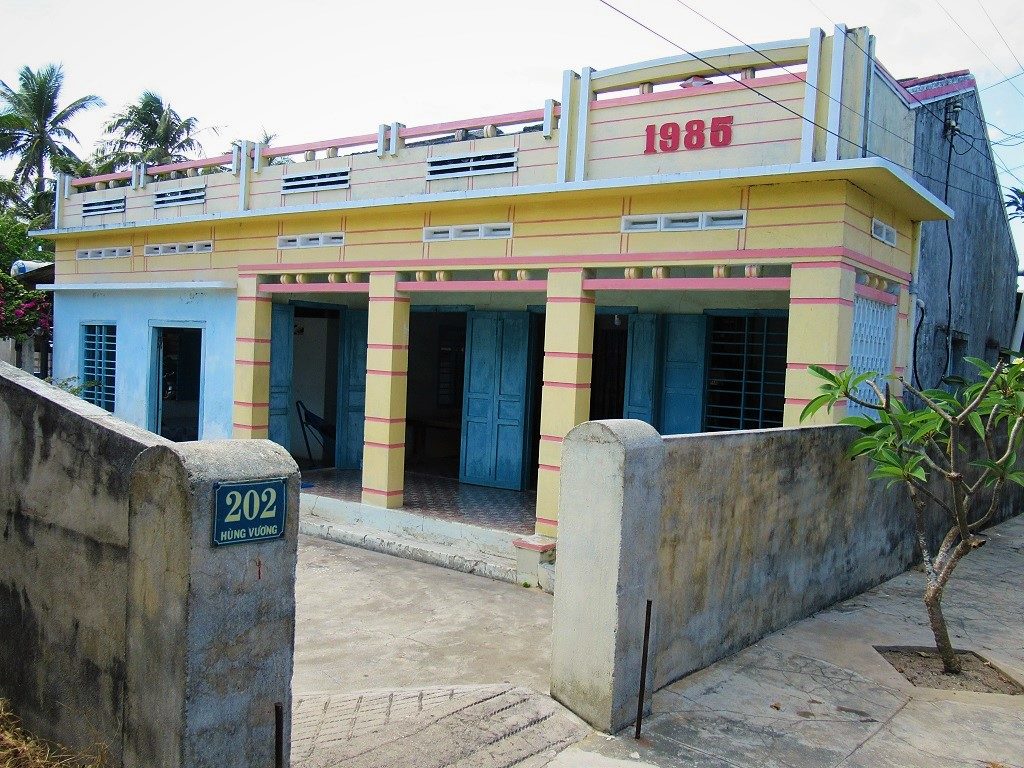
Some of the Modernist buildings are well-kept; others are crumbling & in disrepair
[Back]
Hiking & Viewing Points:
There are four spectacular viewing points on Phu Quy, all of which correspond to high points in the topography of the island or where volcanic cliffs meet the sea. Two of these are hills in the north of the island, where the land swells and rises several hundred feet. The other two are dramatic cliffs and capes. Hiking on Phu Quy is good because the land is flat, the scenery pleasant, and the roads and lanes are quiet.
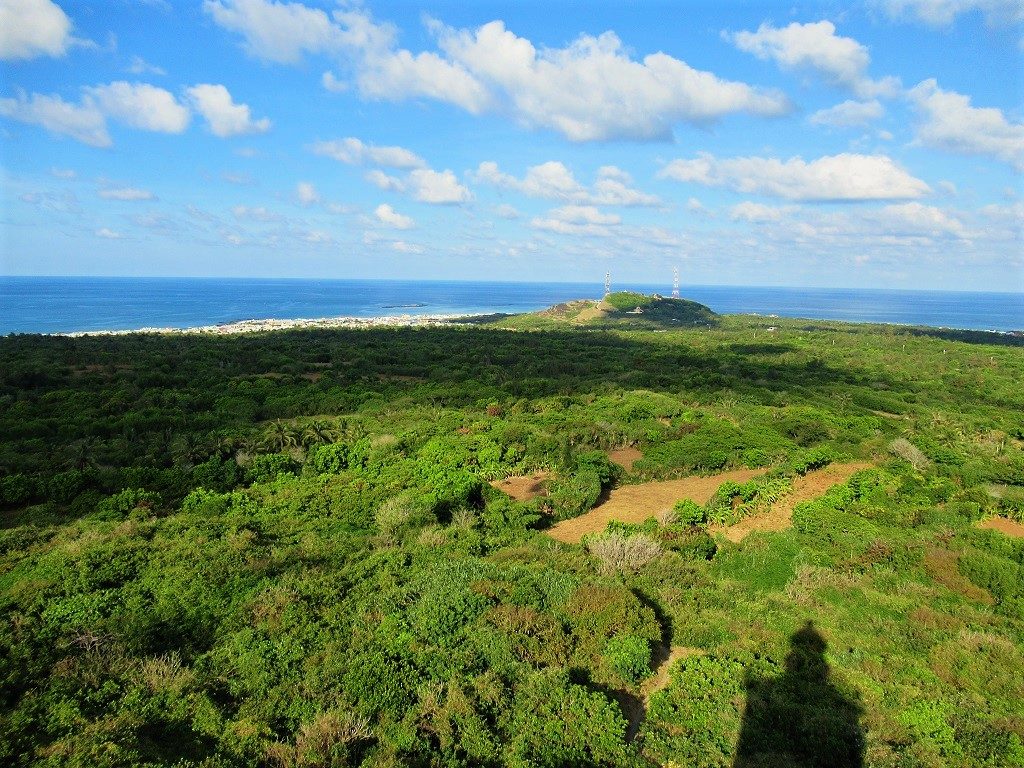
Although Phu Quy is mostly flat, there are a few high points where the views over the island are fantastic
Hiking: Because Phu Quy is criss-crossed with quiet paved lanes and pathways through the brush, and because the terrain is mostly very gentle, it’s entirely possible (and enjoyable) to walk everywhere on the island. The distances are relatively short: the island is only about 8km long and 5km wide. Of course, what takes 5-10 minutes on a motorbike, will take 15-30 minutes on foot. But for hikers Phu Quy really is a great destination. You could walk to any of the places mentioned in this guide. In particular, the four viewing points listed below are well-worth hiking to.
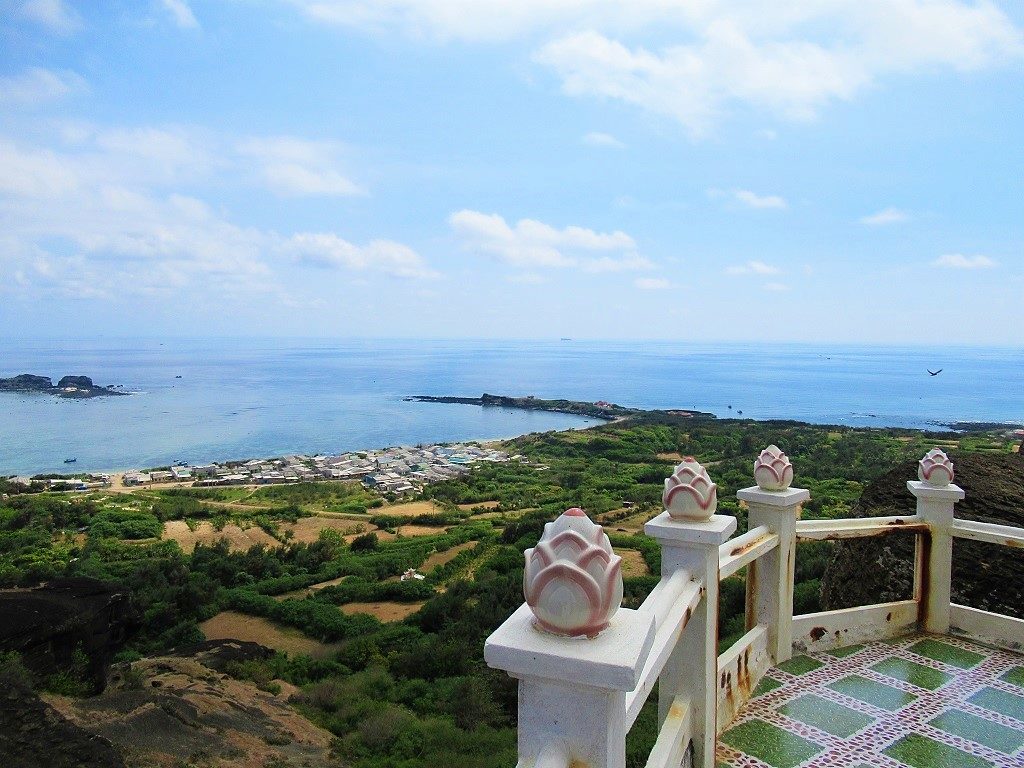
Hiking can be a rewarding way to explore Phu Quy Island: there are pathways up to the high points
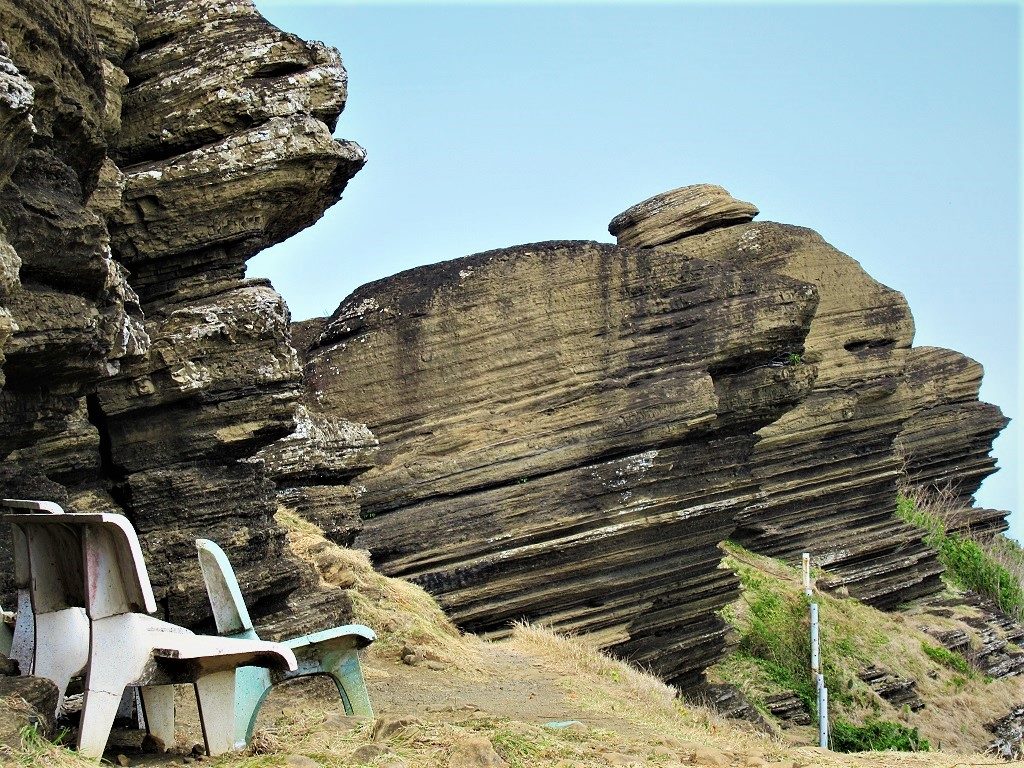
On foot, you can hike the inland hills & fields, and coastal cliffs & headlands
[Back]
Phu Quy Lighthouse [MAP]: In the north of the island, the two high points are the Phu Quy Lighthouse, in the northwest, and Cao Cat Mountain, in the northeast. These are both accessed via steep but relatively short stairways. To get to the lighthouse (Hải Đăng Phú Qúy), continue along the road to the left passed Linh Buu Pagoda (ignoring the No Trespassing sign). When the road ends, turn to your right and walk up the steps. After a bit of a climb, bear right at a fork in the path (bearing left will take you to a Ho Chi Minh monument, which doesn’t afford as good views as the lighthouse). The lighthouse is a handsome and sturdy structure. Behind it is a military installation, which is off limits. However, you are allowed to ascend the stairwell up to the top of the lighthouse for stupendous views across the entire island. There are also benches at the foot of the lighthouse, so bring a thermos of coffee and a snack to enjoy while looking at the views. Try to arrive between 4-5pm for the best light. When you’re up here, you get a sense of how green Phu Quy is, and how isolated it is: just a speck in the ocean. It’s a thrilling sensation.

Phu Quy Lighthouse sits atop a green hill affording views over the entire island

Climb the spiral stairs to the top of the lighthouse and enjoy the enormous views
[Back]
Cao Cat Mountain [MAP]: The highest point on the island, Cao Cat Mountain is the site of a Buddhist monastery, another military installation, and an extraordinary escarpment of stratified rock. To get there, take the road as far as the shrine (you can continue beyond the shrine around the mountain, but ultimately the road stops at a military site), then walk up the stairs behind the shrine until you reach the monastery. From here, there are stairs leading behind the monastery to the gigantic rocks at the top of the mountain. The views are incredible, and the rock formations – swirling and curvaceous – look martian. Bring a drink and some snacks, get here around 5pm, and watch the sun set over the island, bathing everything in a soft light, while listening to the chimes of the gong from the monastery: it feels like Phu Quy Island is all yours (if you can ignore the enormous communication towers either side of the peak).
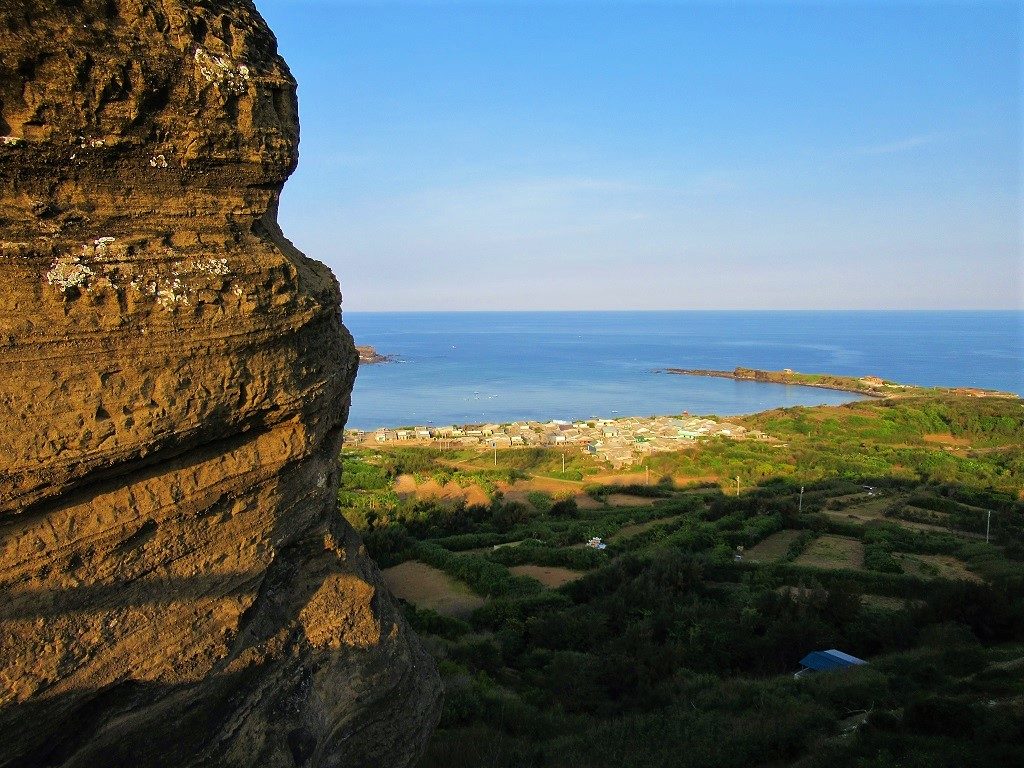
Cao Cat Mountain is reached via several staircases: at the top the views are excellent

There are pagodas, shrines & fascinating rock formations at the top of Cao Cat Mountain
[Back]
Phu Quy Flagpole [MAP]: Easily accessed via the coast road, the island’s flagpole (cột cờ Phú Qúy) is a good vantage point. From here, cliffs spread north to Bai Nho Beach and Ganh Hang Cape, and south to Bai Da Beach. Hiking in either direction is great and the scenery is terrific: barren, stark; almost Hebridien.

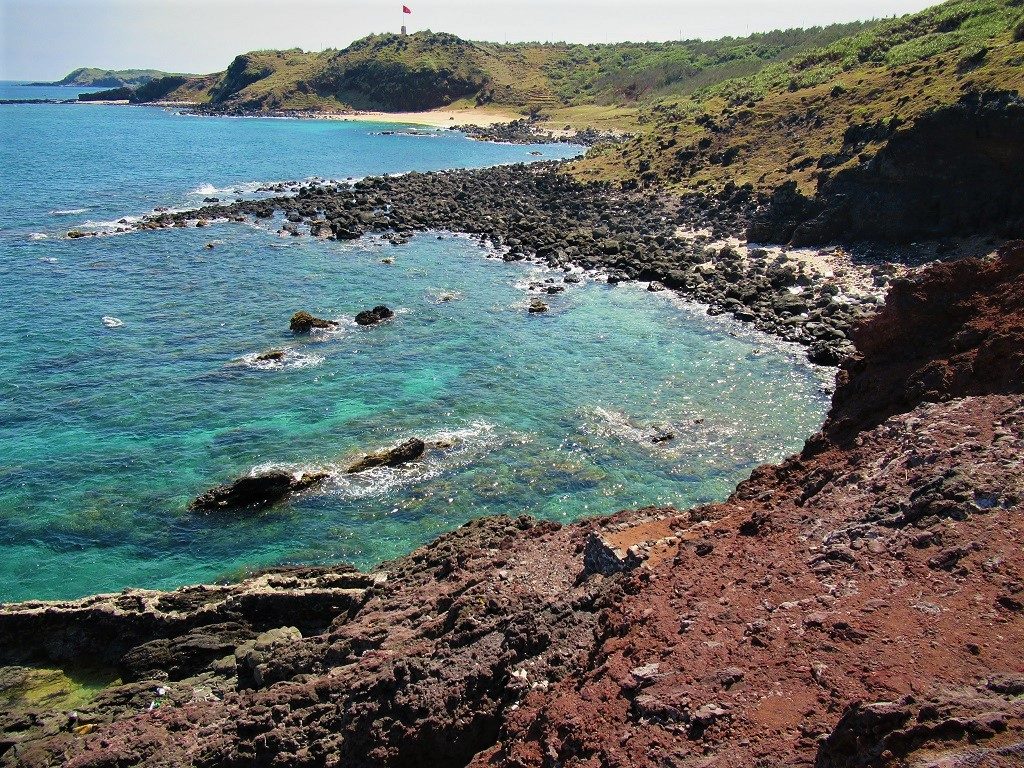
Phu Quy Flagpole (in the distance) is a scenic stretch of volcanic cliffs & headlands with coastal views
[Back]
Mo Thay Temple Cliffs [MAP]: The volcanic cliffs stretching beyond Mo Thay Temple have great views back across a double bay with Cao Cat Mountain behind. (See Mo Thay Temple for details.)
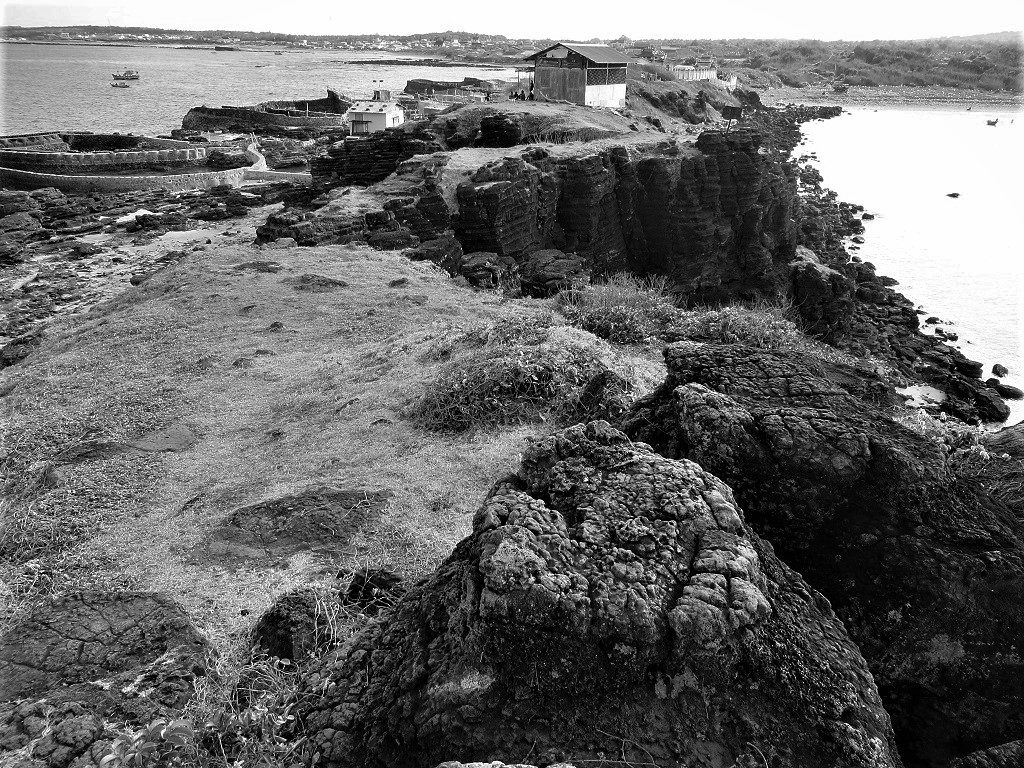
The strange rock formations along the cliffs at Mo Thay Temple offer good views & walking
Accommodation:
*Please support Vietnam Coracle: If you use any of the relevant links below to book your accommodation, I make a small commission (at no extra cost to you). All my earnings go straight back into this website. Thank you.
Because some travellers will need to spend a night in Phan Thiet, on the mainland, before catching the ferry to the island the next morning, I’ve included accommodation options for both Phan Thiet and Phu Quy below:

Both Phan Thiet (where the boats to the island depart from) and Phu Quy have a decent range of hotels
Phan Thiet Hotels: A very likable city on the banks of the Ca Ty River as it flows into the East Sea, Phan Thiet has some good accommodation for a night before taking the ferry to Phu Quy Island. The resort town of Mui Ne is also nearby (just 10km up the coast from Phan Thiet) where there are hundreds of hotels to choose from. However, I much prefer Phan Thiet, so I’ve only listed Phan Thiet hotels below, starting from budget up to mid-range. (For Mui Ne hotels you can search here):
• Mini-hotels near the port [MAP]: Conveniently located on Le Loi Street, just east of Phan Thiet port, a string of good-value mini-hotels and guest houses line the road. All have decent, clean, bright and plain rooms for $10-$20. Try Minh Duc Guesthouse for the cheapest rooms, or Hoa Binh 2 for no-frills charm, or for a few more bucks check-in to Hotel Minh Hang, or Hoang Kim or Nhat Linh. In short, there’s lots of choice on Le Loi Street [MAP]
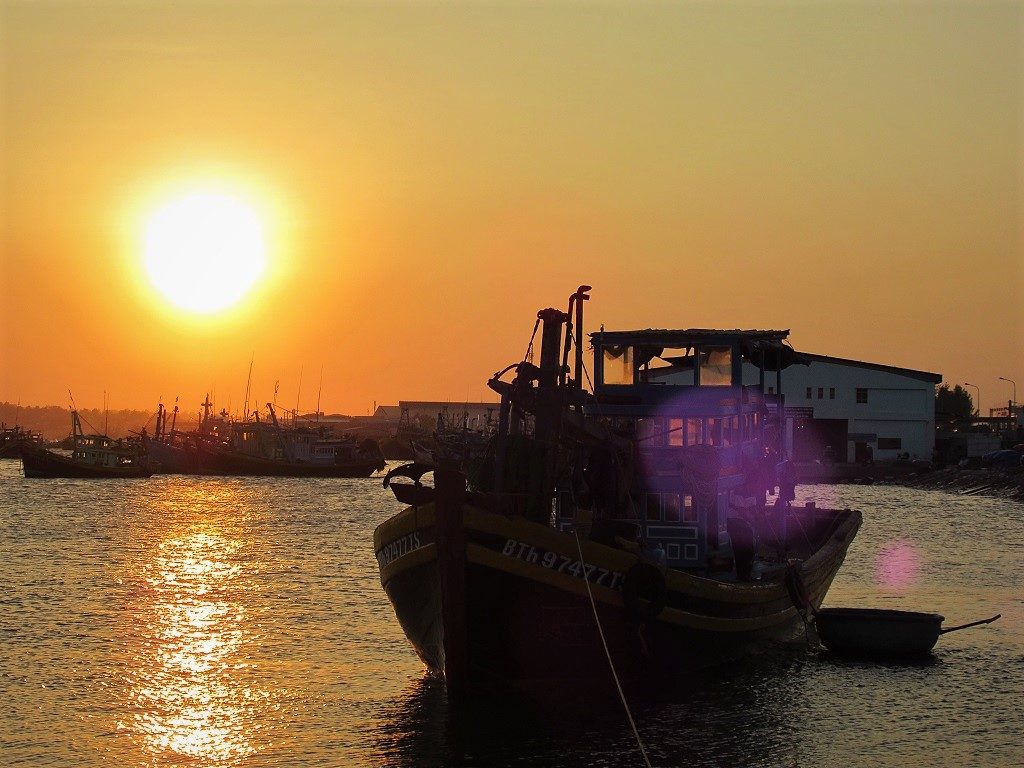
There are lots of good value mini-hotels along Le Loi Street, conveniently located near Phan Thiet port
• Moon Hotel [MAP]; $10-$15: [BOOK HERE] An excellent new budget option, Moon Hotel stands all on its own in a newly developed part of town. The rooms are bright and clean (some even have balconies with sea views) and the area is quiet. It’s a 5-minute taxi ride from the port. [BOOK HERE]
• Doi Duong Hotel & TTC Premium Hotel [MAP]; $25-$40: These two mid-range hotels are pretty good value considering they both have swimming pools, ocean views, and easy access to Phan Thiet’s municipal beach and park. I prefer Doi Duong [BOOK HERE] because it has balconies, but the breakfast isn’t great. TTC Premium [BOOK HERE] has large but soulless rooms without balconies, however its breakfast is much better.

• Ocean Dunes Resort [MAP]; $35-$60: [BOOK HERE] With excellent facilities (including two pools, large, green gardens, and children’s play area), the Ocean Dunes is very good mid-range accommodation. Rooms have big balconies with either sea or mountain views, direct access to the new beachfront promenade, and a good breakfast. (Read my full review here.) Average rates are $35-$60 a night [BOOK HERE]
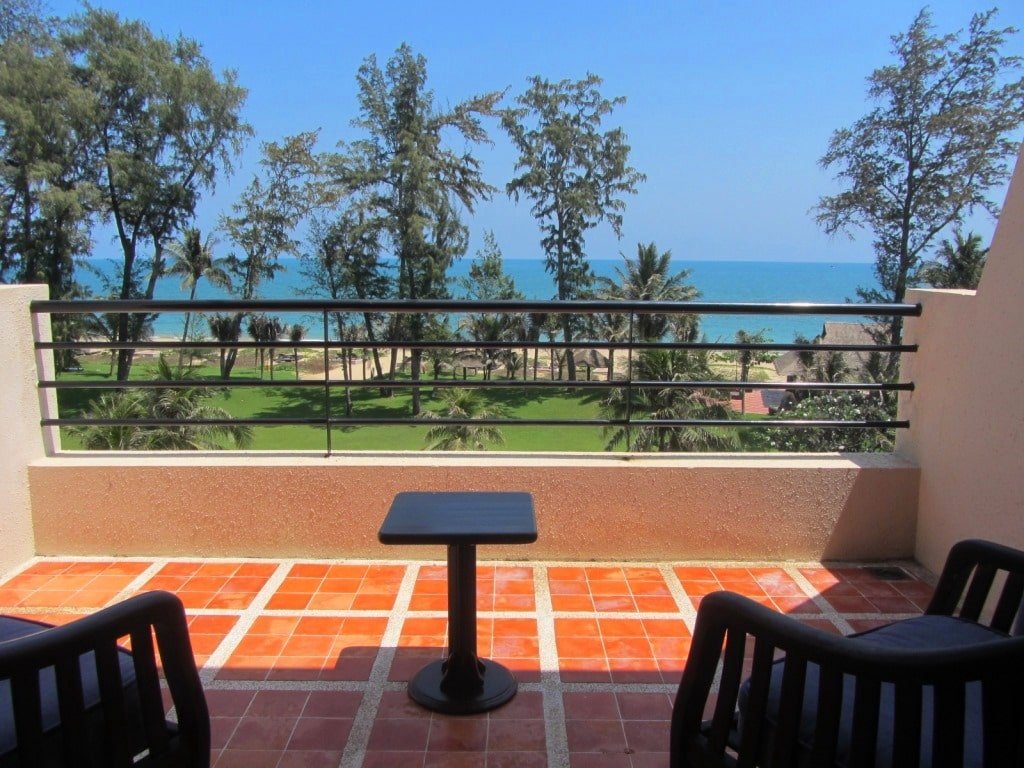
The Ocean Dunes Resort is good value for money, considering the sea views & facilities
[Back]
Phu Quy Island Hotels: There are currently about a couple of dozen mini-hotels, guest houses, and homestays on Phu Quy Island. Most are clustered around the main port area and Tam Thanh commune which surrounds it. However, there are several other notable accommodations further afield, in the other two communes of Ngu Phung and Long Hai. Almost all accommodation follows the same pricing: singles/doubles = 200,000/250,000vnd | quads (two double beds) = 400,000vnd. The general standard is good, with clean, bright, spacious, and fairly new rooms. Camping is very tempting, if you have your own gear, because the coastal meadows and casuarina forests are perfect for a campsite. But, because there are so few foreign visitors, it would be wise to ask permission before you camp. There aren’t any beach resorts or big hotels yet. However, Phu Quy’s accommodation scene is set to change within the next year or two. The following places to stay are in order of my own personal preference:

Phu Quy Island has some good mini-hotels & guest houses and prices are reasonable
• Sao Bien Guest House [MAP]; Tel: 090 464 0108 | 250,000-450,000vnd: This excellent guest house is on the beautiful, casuarina-shaded stretch of road linking Tam Thanh and Ngu Phung communes. Just across from a placid, walled marina where a small fishing fleet lies at anchor, Sao Bien is a spotless, bright, brand new, modern structure. Managed by a friendly family, the rooms are plain but comfortable, with firm beds, tiled floors, air-con, hot water, TV, and windows. A couple of the rooms have sea views, and there’s a great rooftop terrace from which to watch the sunset. The area is quiet, cool, and slow. There’s excellent seafood next door at Quán Phú Qúy 2 and the shady grounds of Cherry Cafe on the other side. It’s the perfect place to base yourself for a few days on the island.
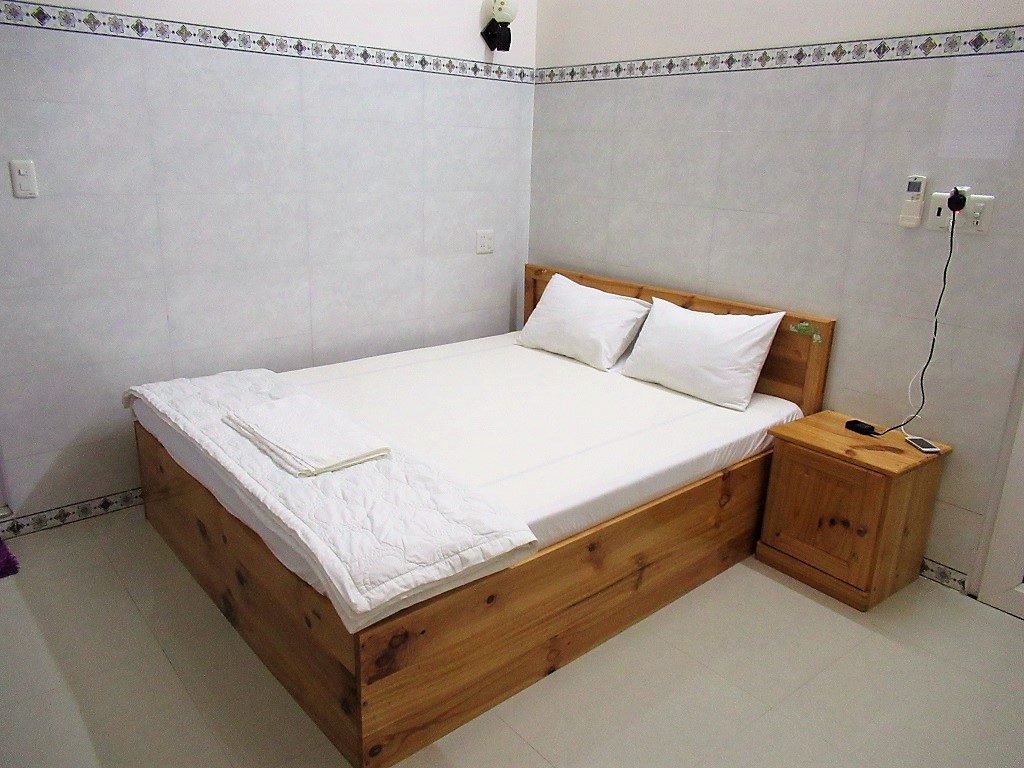
Sao Bien is an excellent, clean, comfortable, inexpensive guest house in a lovely, quiet location
• Bao Tran Mini Hotel [MAP]; Tel: 094 619 1123 | 250,000-400,000vnd: A classic mini-hotel on the grid of streets surrounding a new park, Bao Tran has nice, clean rooms with windows and small balconies at the front overlooking the square. It’s run by a handsome local family who make you feel at home. It’s not on the coast (although you can see the sea from some of the rooms) but it is walking distance from all of the best food and drink options in Tam Thanh commune. A pleasant place for a night or two.

• Tam Thanh Mini-Hotels [MAP]: Along Vo Van Kiet Street near where it intersects with Tran Hung Dao, and the grid of streets just to the north, surrounding a new park, is probably the greatest concentration of hotels and guest houses on the island. There are lots to choose from and they all have similar prices (250,000-450,000vnd) and similar quality rooms (clean, comfortable, air-con, hot water, TV, windows). In particular, check out Khach San Phu Quy (tel: 091 647 3245) and Hung Phat Hotel (tel: 093 300 9927), who are neighbours on the high street and among the largest hotels on the island; and Hien Duoc Hotel (tel: 090 291 9678) and Khach San Mini Hai Ha (tel: 091 6264 101), also on the high-street. These are all solid places to spend several nights.
• Truong Huy Hotel [MAP]; Tel: 094 341 4488 | 250,000-400,000vnd: Just a couple of minutes east of Phu Quy Port, Truong Huy is a good hotel with lots of rooms, some with nice big windows looking over the lane and trees. The rooms are big and clean but sparse. It’s a quiet location and walking distance from Trieu Duong Bay and the harbourfront, which is very convenient if you’re catching an early morning boat back to Phan Thiet.
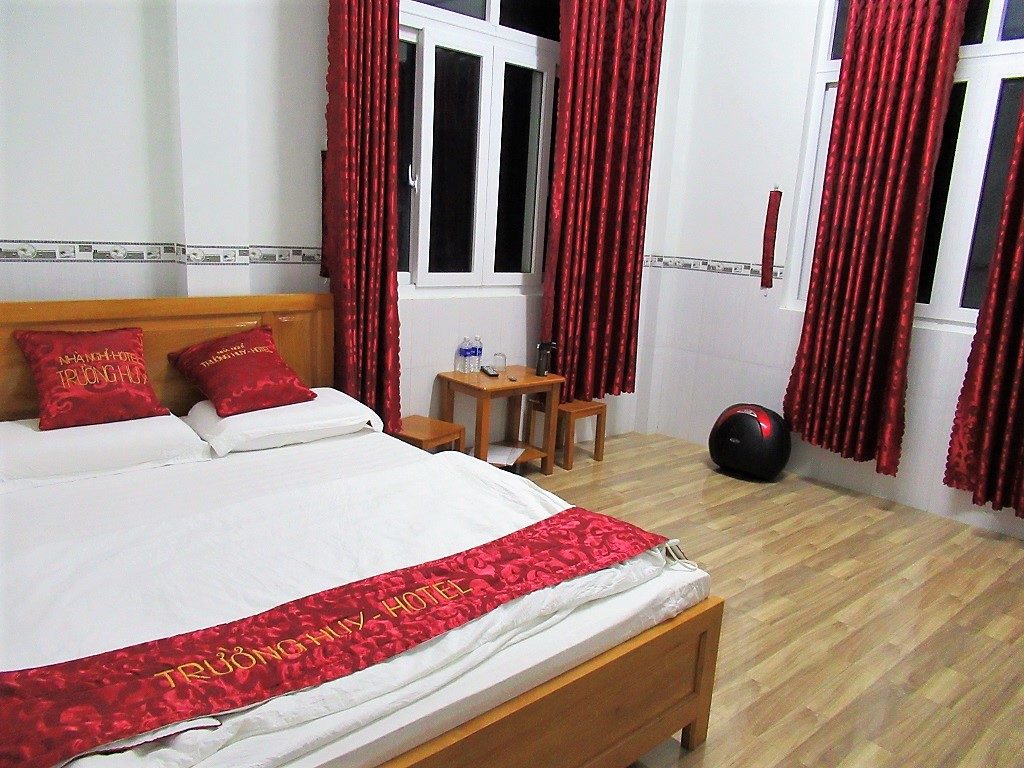
Truong Huy is a good value mini-hotel with large but sparse rooms & a central but quiet location
• Long Vi Hotel [MAP]; Tel: 091 768 0344 | 150,000-400,000vnd: In the northeast of the island, Long Vi consists of a couple of simple structures decorated with brightly coloured murals. Inside, the rooms – most of which have sea views – are basic but clean and the walls are adorned with floral patterns. There’s a kind of hippy-cutesy vibe to the place. It’s popular with Vietnamese backpackers, as is the attached seafood restaurant. The position is quiet and scenic: on a bay, walking distance from a clifftop temple, and in the shadow of Cao Cat Mountain.
• Hoang Phu Hotel [MAP]; Tel: 091 970 9550 | 250,000-450,000vnd: A three storey building down the narrow backstreets near the embankment in Tam Thanh commune, Hoang Phu Hotel has good, clean rooms and sea views. It’s a pleasant and quiet position, perfect for strolling up and down the new seafront promenade and exploring the village on foot. It’s popular with visiting groups from the mainland, so it fills up quickly.
• Homestays: Around the island there are a handful of homestays. However, I found it difficult to find information about them, and the hosts seemed unsure about accommodating foreign guests. But it’s worth looking into, especially if you speak some Vietnamese or are travelling with Vietnamese companions, because Phu Quy locals are famous for their hospitality and sense of fun. I’d also expect homestay-style accommodation to grow over the next year or two. For a start, you can try asking at Thien Su Cafe, in Long Hai, where the owner’s family have a room or two for guests, if available.

Long Vi Hotel is by the sea with a few bright rooms and a kind of hippy-cutesy vibe
Food & Drink:
Phu Quy is, naturally, famous for its seafood. Sea cucumbers and crabs are among the island’s specialities. There are dozens of informal seafood eateries and restaurants across the island. Because of its relatively large population (for an island), Phu Quy also has a decent range of street food available in its three main villages (or communes). Noodle soups, savoury snacks, and other tasty treats are sold from streetside vendors. Fruit juices and smoothies are available from kiosks, and there are lots of local cafes. Phu Quy even has its own brew: rượu dứa – a local liquor made from the fruit of a kind of screwpine, called pandanus tectorius. Although there are places to eat and drink all around the island, the largest concentration of dining and drinking options is in Tam Thanh, spreading west from the main port.
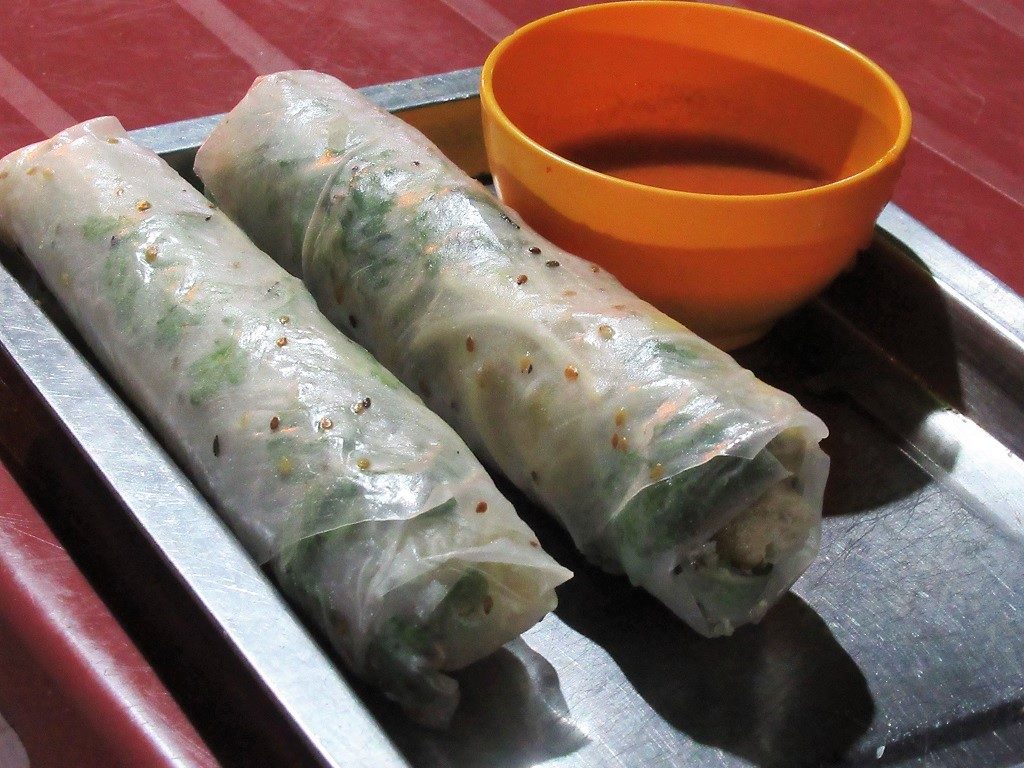
Phu Quy has enough dining options to keep you going, including excellent seafood & street food
There are informal local seafood restaurants dotted all around the island. Look for signs saying quán hải sản. However, if you’re not familiar with ordering in Vietnamese, a good place to start is the ‘foreigner friendly’ restaurant at Long Vĩ (where some English is spoken), or the big restaurants just off Tran Hung Dao Street in Tam Thanh commune, such as Cột Buồm, Quán Hải Thắm 2, or Quán Lộc Phát, which have big menus with pictures and prices. A popular option for seafood are the floating restaurants just offshore at Bai Phu Bay. Sometimes doubling as fish farms, the food here is extremely fresh. Prices are reasonable and there are at least half a dozen floating restaurants clustered together in the bay. A small boat ferries you over. It’s worth noting, however, that the beach is strewn with trash and if you’re unlucky (or lucky, depending on how you view it), there may be a seafood-karaoke party on the same floating restaurant as you, in which case it’s a very loud dining experience (and there’s no escape). If this doesn’t appeal to you, there are dozens of good, local seafood joints around the island to choose from. I barely scratched the surface when I was there, but I particularly liked Quán Phú Qúy 2 and Hải Sản Ánh Huyền, both near Ngu Phung commune. The former is a restaurant with an open-air terrace upstairs, with reasonable prices, good seafood, and a relaxed atmosphere. The latter is a local fishermen’s haunt, housed in a concrete shack with blue wooden shutters by the embankment, where the fish come straight off the boats from the fishing fleet moored in the bay.

Phu Quy is famous for is fresh, delicious & inexpensive seafood straight from the ocean
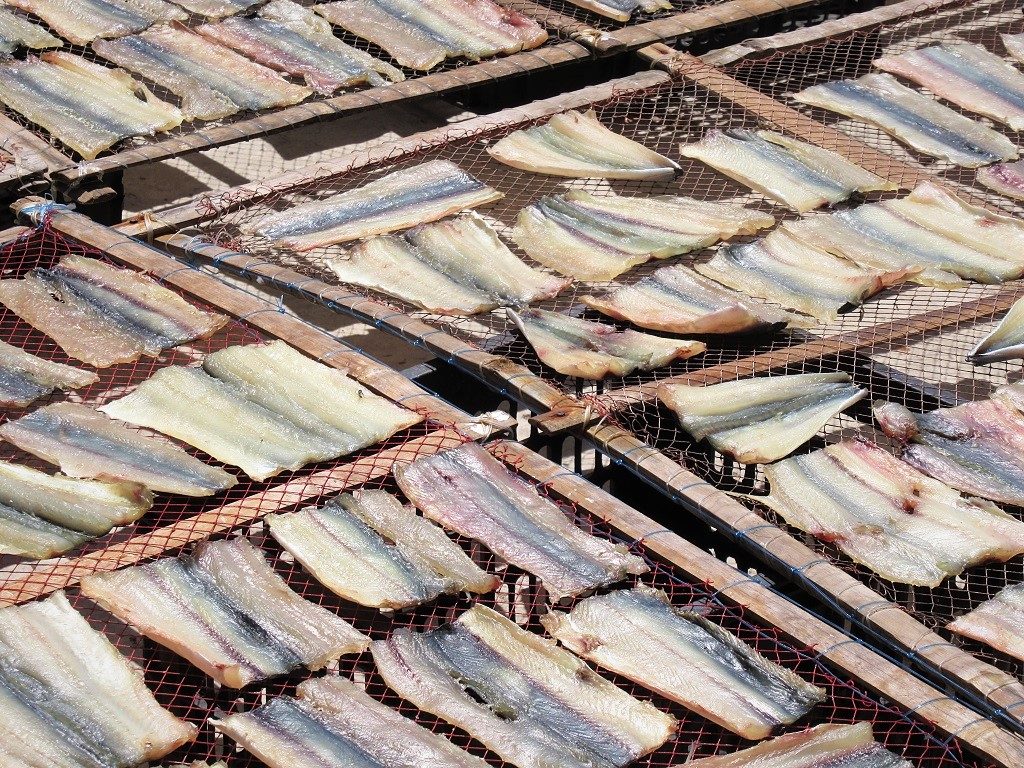
Seafood is everywhere on Phu Quy: from the fishing boats to fish drying in the sun to local fish restaurants
[Back]
Street Food:
Although street food on Phu Quy is nowhere near as varied and ubiquitous as in any town on the mainland, for an island it has quite a decent selection. In the mornings and late afternoons through to the evenings, you’ll find street food vendors along the busiest streets of all three of Phu Quy’s villages: Long Hai, Ngu Phung and Tam Thanh. However, the two liveliest spots are Vo Van Kiet Street near the intersection with Tran Hung Dao Street, in Tam Thanh, and the area around Long Hai Market. Below are some of the places that I enjoyed eating at, but obviously there’s a lot more to choose from, and I’d expect the street food scene to rapidly expand over the next year or two, as more people from the mainland visit and settle here.

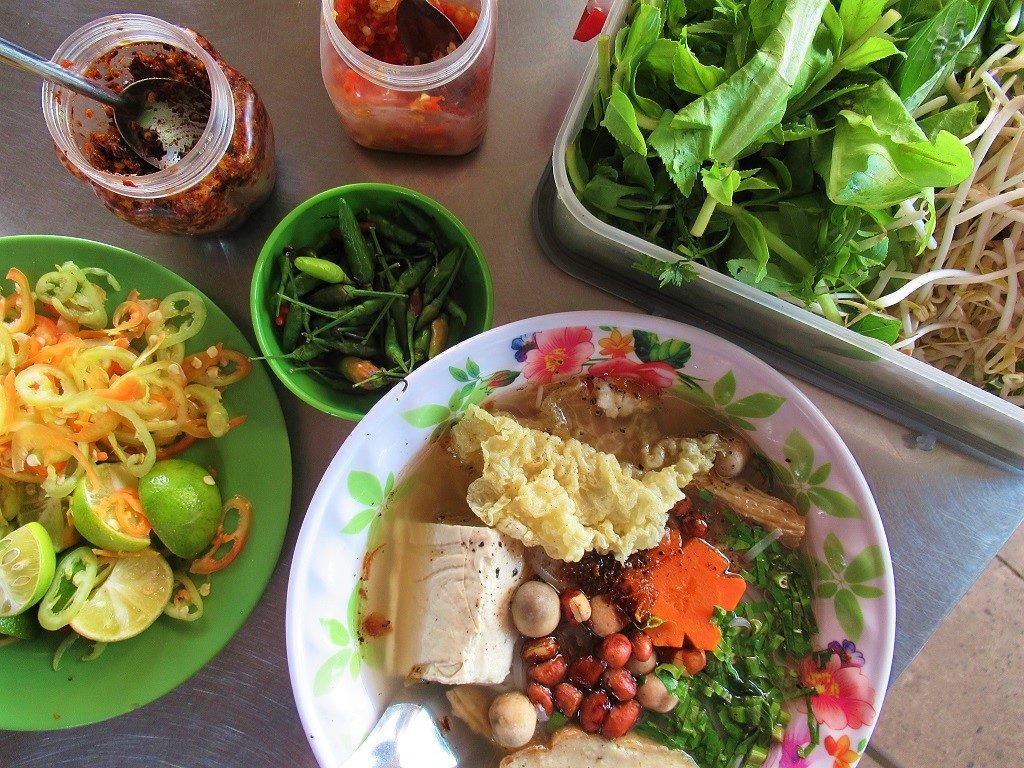
For an island, Phu Quy has a decent range of street food options in its three ‘communes’ or villages
Tam Thanh Commune: As the liveliest of the villages on the island, Tam Thanh has the best choice of street food. Go up and down Vo Van Kiet Street a couple of times and you’ll get a good idea of what’s available, particularly around the intersection with Tran Hung Dao. There are a couple of good bánh xèo (savoury pancakes with pork and shrimp) either side of Hien Duoc Hotel. Quán Thuận Phát has a great selection of classic Vietnamese noodle soups, such as bún bò Huế (Hue-style beef noodles), mì quảng (central-style thick noodles), and hủ tiếu (southern-style vermicelli noodles). A couple of bún đậu mắm tôm (tofu with pork, herbs and pungent dipping sauce) offer decent versions of this Hanoi dish – try Quán Nhím Biển. Mỹ Duyên bakery has fresh baguettes and cakes. Quán Hót Sài Gòn is another decent all-rounder for soups and noodles. Kebab Torki serves up doner-style kebabs. Finally, Quán Hai Hảo does a decent bowl of beef phở.
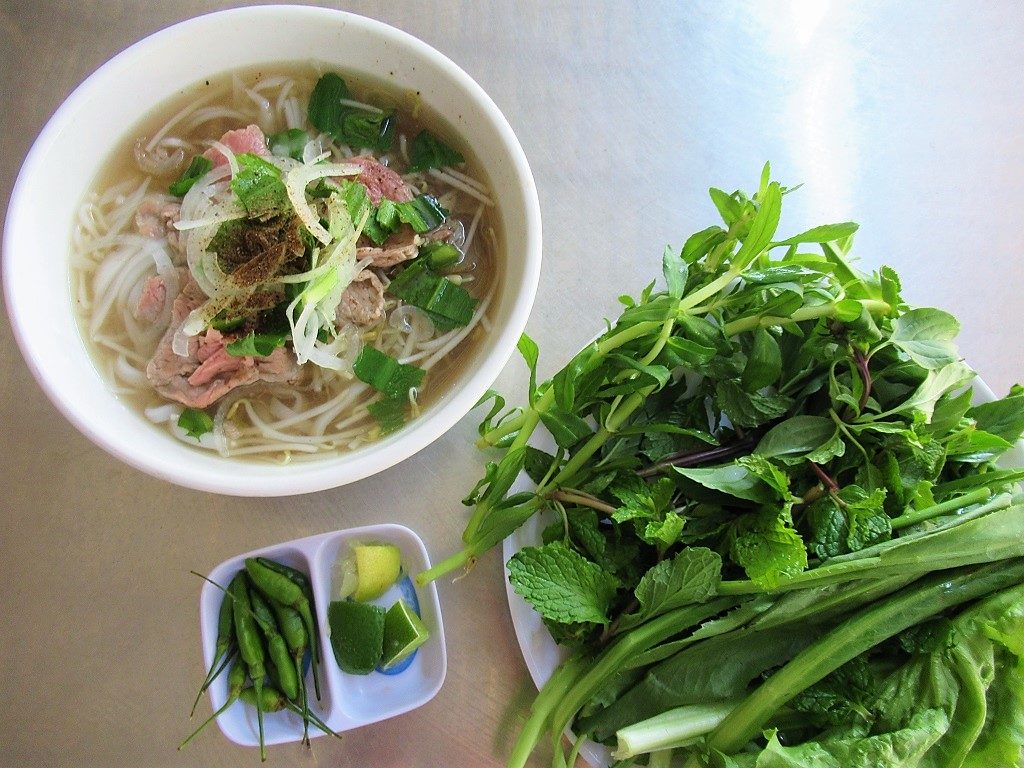
Tam Thanh has the greatest concentration & variety of street food anywhere on the island
[Back]
Ngu Phung Commune: The quietest of the three communes, Ngu Phung doesn’t have much in the way of street food. But look around and you’ll find little streetside stalls selling noodle soups, fruits, and chè (sweet dessert drinks, often with coconut milk, fruit, and jelly). One nice spot in the early evenings is on 27 Thang 4 Street, by a little park outside the entrance to Lang Co My Khe temple, where several vendors cluster [MAP].

Ngu Phung commune’s street food options are limited & often hidden down back streets
[Back]
Long Hai Commune: The area around Chợ Long Hải (Long Hai Market) is a bustling little intersection where street food vendors serve food and drink, especially during the mornings and early evenings. Among the many dishes you’ll find here are: bánh xèo (savoury pancakes filled with shrimp and pork – the ones here are very unusual because the pancake batter is made with carrot, giving the bánh xèo an orange hue), chả cuốn (fresh spring rolls filled with herbs, fish cake and pork, a provincial speciality), mì quảng (a popular noodle soup from the central provinces), cháo (hot, wholesome rice porridge), and bánh flan (the Vietnamese take on creme caramel). There are signs for all these dishes (and more) at the food vendors on the roadside. Everything costs between 10,000vnd-30,000vnd per dish.
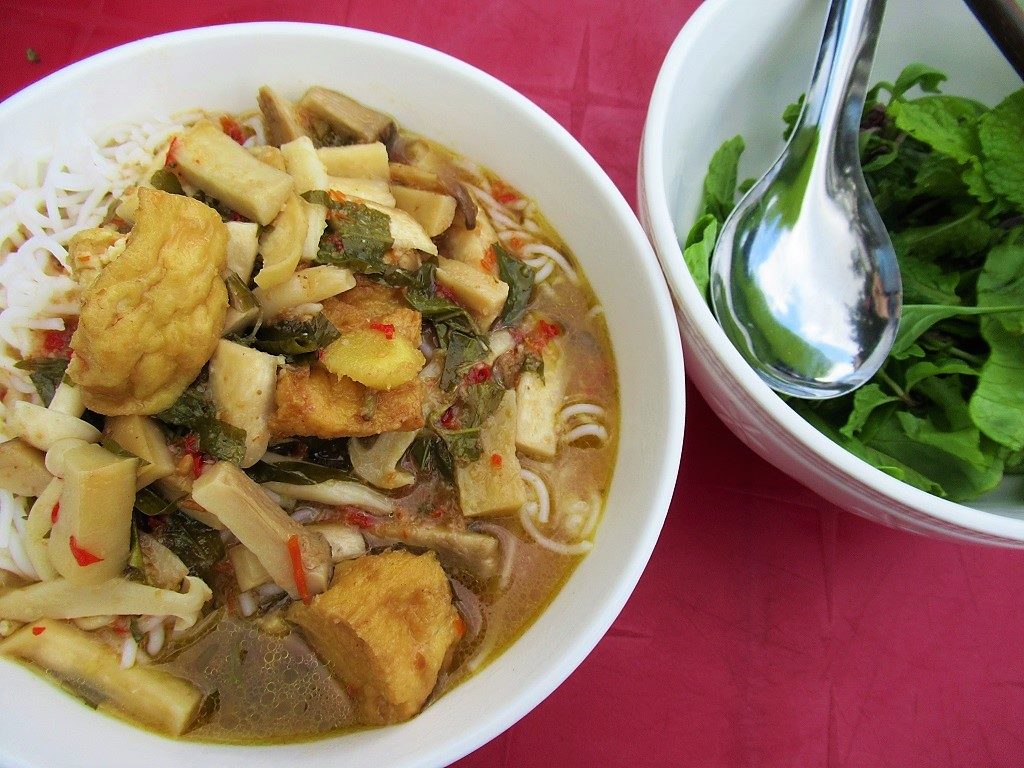
Long Hai has some good street food, particularly around the market in the mornings and evenings
[Back]
Drinks:
Phu Quy has its fair share of local cafes, milk tea and smoothie stalls, and beer joints around the island. But there aren’t really any bars as such. However, the island does have its own local liquor, and it’s still possible to get an espresso in the mornings and a cocktail in the evenings:

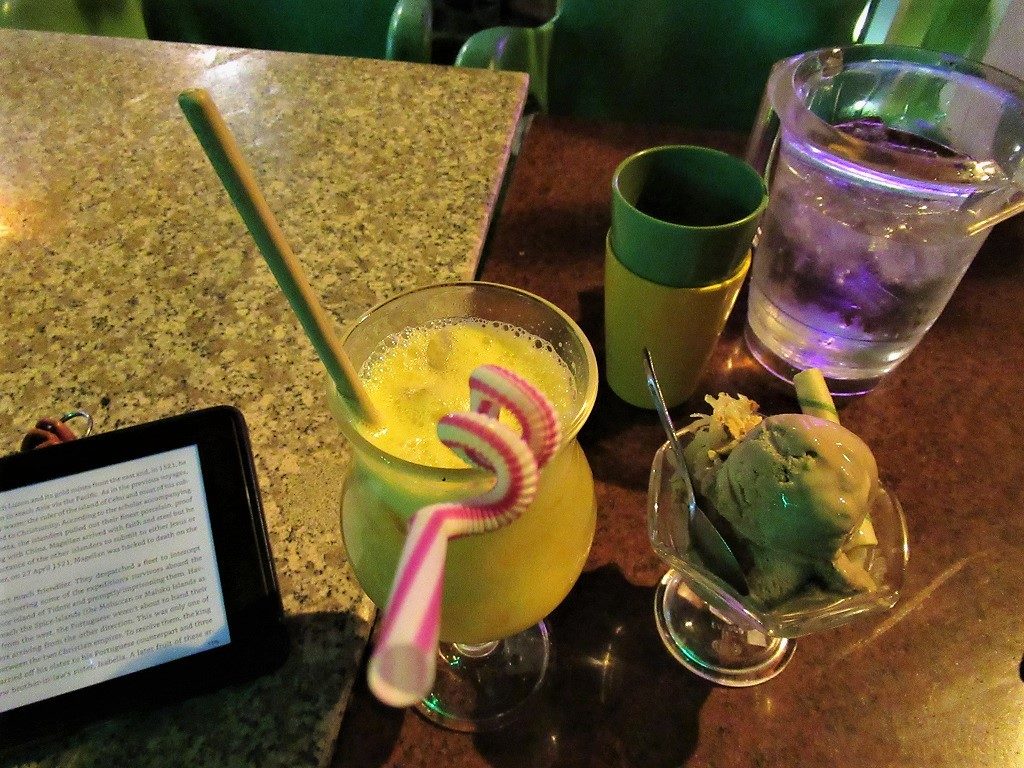
On Phu Quy you can find smoothies, juices & beer, as well as the island’s own local liquor
Alcohol: The usual Vietnamese brands of beer are available everywhere, as well as regional brands, like Tiger. But Phu Quy also has its very own island brew: rượu dứa. This is a very potent, amber-coloured liquor made from the fermented fruit of the pandanus tectorius plant, which grows all over the island. The plant has long, sharp leaves and exposed, claw-like roots; the fruit, which you can see sold on the streets, is like a round, orange, pineapple. You can pick up home-brewed rượu dứa from many of the local stores around the island for as little as 10,000vnd for a 500ml bottle, or from some of the cafes, restaurants and hotels. Another good place for a tipple is Song Cafe, on the backstreets behind the main drag in Tam Thanh commune. As well as good coffee, smoothies, and juices, Song Cafe offers a short, but enticing list of cocktails, including daiquiris and margaritas.
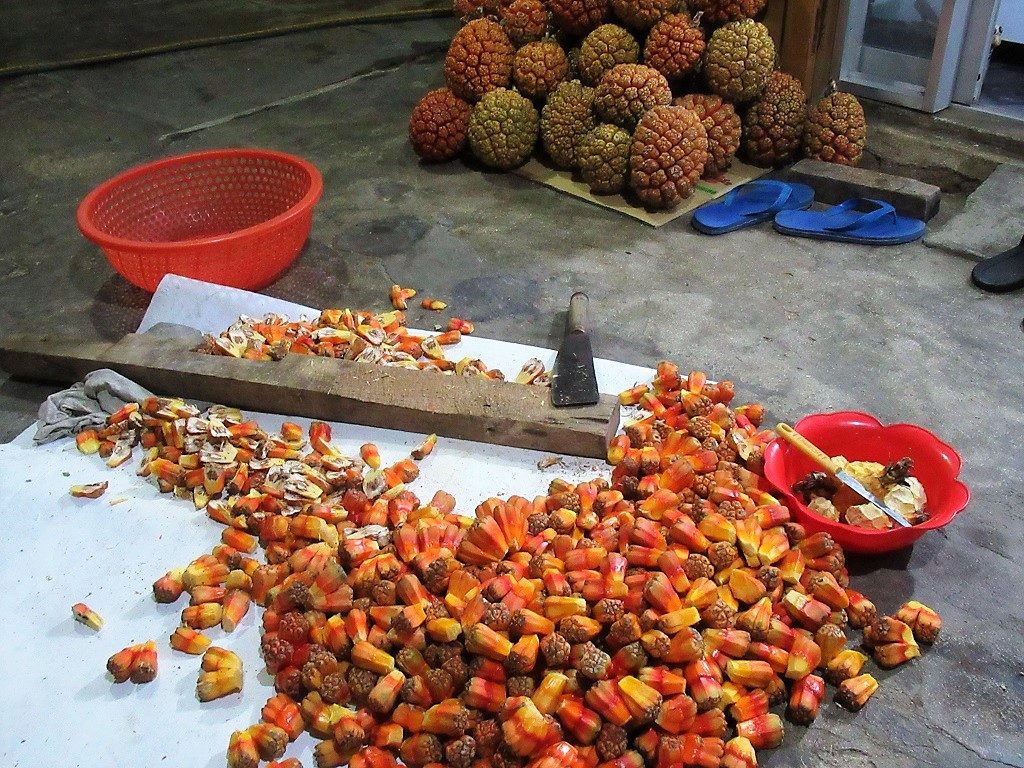
The fruit of the screwpine is used to make rượu dứa – a strong liquor with a slightly bitter taste

Various local liquors (rượu) displayed in a shop on Phu Quy, including screwpine, ginseng & snake
[Back]
Coffee & Juice: There are plenty of cafes in all three of the island’s villages. While the cafes are often very attractive, shady places to be, the standard of coffee isn’t great. But I expect the cafe scene to change dramatically in the next year or so, as more and more young Vietnamese visit and open coffee shops on the island. For now, the best coffee I found was at Song Cafe, where they offer a choice of robusta or arabica beans. Cherry Cafe is also good with a quiet location, and Passion Cafe is central and fine. Several juice and smoothie vendors can be found in the villages. In particular, there’s a good one on Vo Van Kiet Street, near the intersection with Tran Hung Dao. You’ll find orange, mango, passion fruit, avocado, coconuts and much more. Lucky Cafe serves a range of drinks and is popular with Phu Quy’s young crowd in the evenings. And the trend in trà sữa (sweet milk tea) has made it to the island: there are several trà sữa stalls along the roadsides. If you’re in the mood for some live music and billiards, head over to Thien Su Cafe, in Long Hai, where there are a couple of pool tables and occasional jam sessions – you’ll probably be invited to join in, too.

Song Cafe has good coffee, a nice atmosphere & even some cocktails, which makes it unique on the island
Getting There & Around:
*Please support Vietnam Coracle: If you use the links & search boxes below to book your transportation to Phu Quy Island, I make a small commission. All my earnings go straight back into this website. Thank you.
*IMPORTANT: As of September 2020, foreign travellers no longer need a permit to visit Phu Quy Island. However, I have left the details of the process to obtain the permit on this page below, just in case the situation changes in the future.
Phu Quy Island can only be reached by boat from Phan Thiet, a very likable fishing town on the southeast coast. There are three ferry companies operating daily fast boat services between Phan Thiet and Phu Quy Island. To get to Phan Thiet, there are good rail and road connections from Saigon (Ho Chi Minh City), Nha Trang, and Dalat among many other hubs nationwide. On Phu Quy Island, a surprisingly extensive network of quiet, paved lanes follow the island’s coastline and criss-cross its interior: perfect for two-wheeled exploration or, because the terrain is mostly very gentle, hiking:
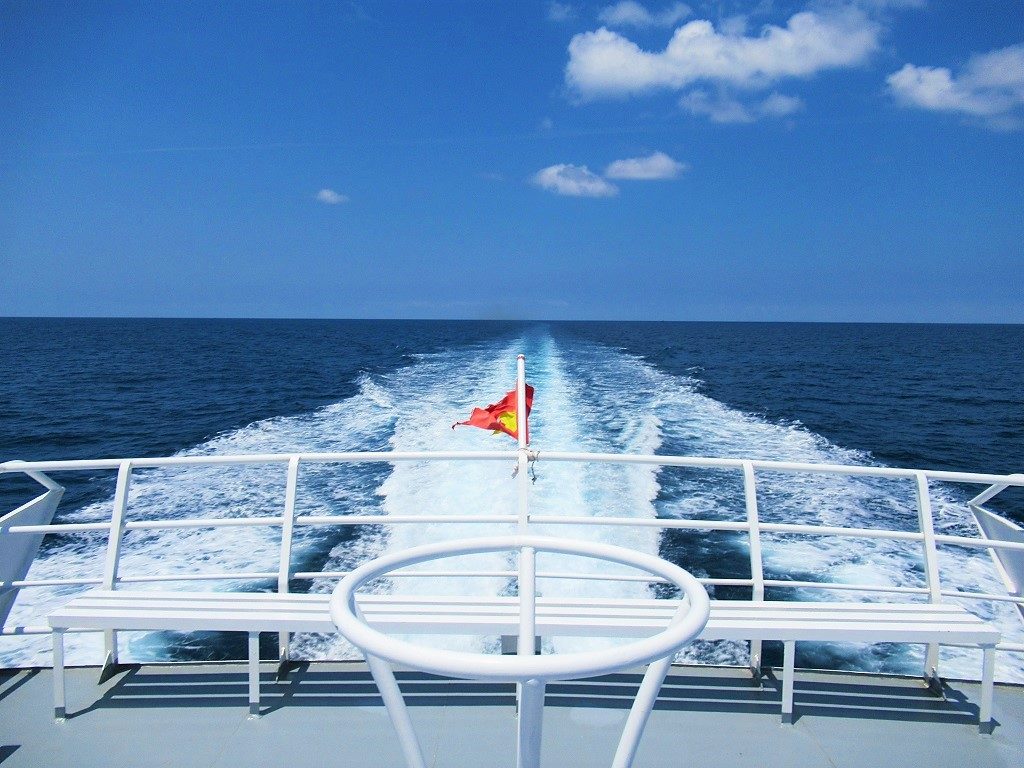
Phu Quy Island can only be reached by boat from Phan Thiet: but first you must get a permit
*IMPORTANT: As of September 2020, foreign travellers no longer need a permit to visit Phu Quy Island. However, I have left the details of the process to obtain the permit on this page below, just in case the situation changes in the future.
Foreign travellers must have a permit in order to visit Phu Quy Island. This is partly because Phu Quy has only recently opened to foreign tourists, and partly because the island is technically a sea border: there has been considerable tension in the East Sea over disputed islands in recent years. However, it is now fairly easy to acquire the necessary documents to legally visit the island, although it does take a bit of time and money. But don’t worry: it’s a straightforward process, and it’s worth it.

- Obtaining the Permit in Phan Thiet
- Checklist to Apply for Permit
- Boarding & Disembarking the Boat
- Using the Permit on the Island
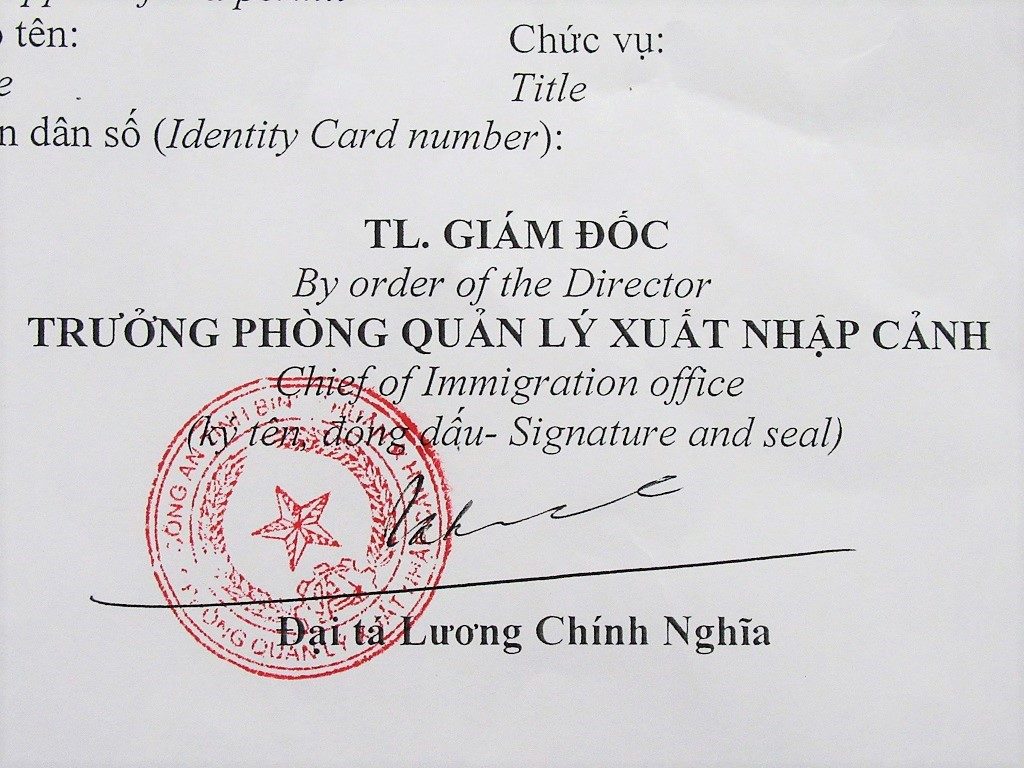
Foreign travellers to Phu Quy must obtain a permit before taking a boat to the island
Obtaining the Permit in Phan Thiet: There are two ways to apply for the permit, click below for details:
Local Government Office: This is the cheaper but slightly more convoluted method. It goes like this: Make sure you have the documents in the checklist below, and make your way to the Immigration Department (Phòng Xuất Nhập Cảnh) of the Provincial Police Station (Công An Tỉnh Bình Thuận), at 139 Mau Than Street, in Phan Thiet. Take the entrance on the left of the building, go inside and up the stairs on the left as you enter. On the first floor, go to window No.3 (Cửa Số3), where a sign in English reads ‘Receiving Documents of Foreigners’. Staff here are dressed in official green uniform and some speak a little bit of English, but it helps if you can speak some Vietnamese. Stand (or sit) in the queue and communicate that you wish to apply for a permit to visit Phu Quy Island. The staff will then ask for, take, and copy your documents, and give you a form (in Vietnamese) to fill out. You’ll also need to give the name and address of your accommodation in Phan Thiet. Then pay the fee of 250,000vnd ($10) and give your phone number or email address so they can contact you when the permit is ready to collect. It will take 2-3 working days. I’ve been to this office twice: the first time, staff were rigid, cold, and unhelpful; the second time they were young, friendly, and efficient. (It pays to dress in long pants and a shirt, rather than shorts and a T-shirt, when visiting any government office.)
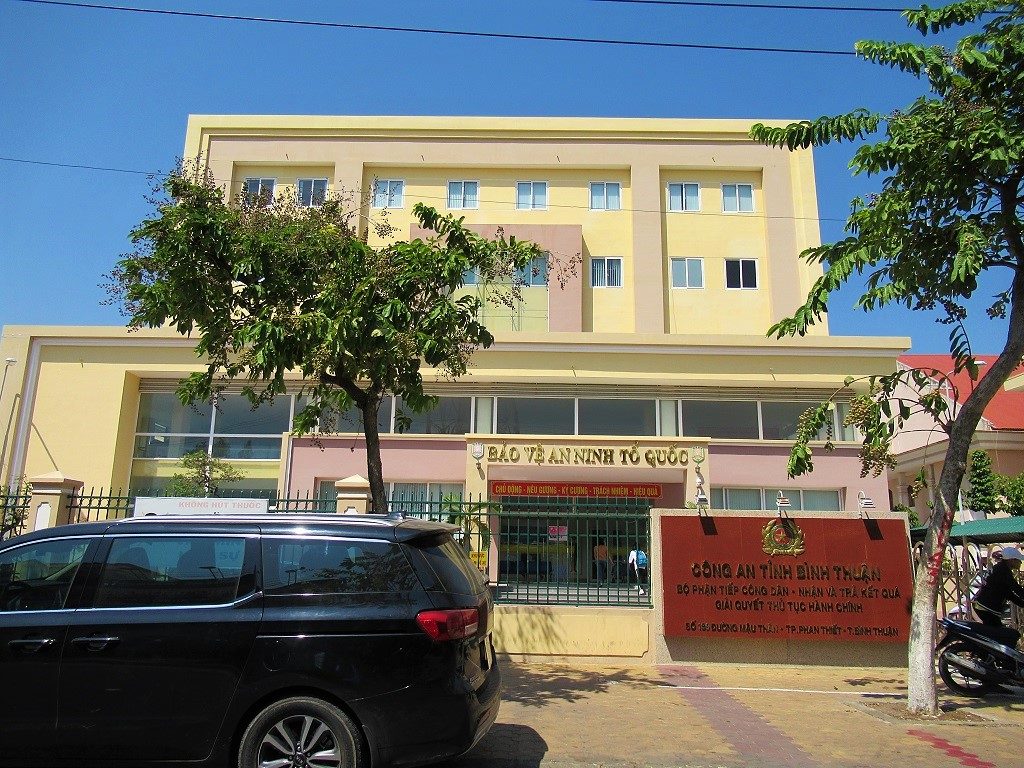
This is the Provincial Police station in Phan Thiet within which is the Immigration Department
Local Travel Agent: This is the easier, more streamline, but more expensive method. It goes like this: Make sure you have the documents in the checklist below, and make your way to one of several local travel agents in Phan Thiet (there are also travel agents in nearby Mui Ne who can arrange permits). I recommend going to Sao Mai (14 Muoi Chin Thang Tu Street; 062 3824 111) as they are efficient, well-organized, and some English is spoken. However, there are other travel agents, especially on Ton Duc Thang Street, such as Bo Cap Vang (185 Ton Duc Thang Street; 0886 234 555). Explain that you want to get a permit to visit Phu Quy Island. The staff will ask for your documents. You will also need to give the name and address of your accommodation in Phan Thiet, and state when you wish to visit the island (the permit is only valid for one week from the day you intend to arrive). You pay upfront: 600,000vnd ($25) for standard service (2-3 working days), or 840,000vnd ($35) for fast track service (24 hours). However, it’s highly likely that even the fast track service will end up taking at least 48 hours to complete. Leave your phone number or email with the staff and they will contact you when the permit is ready to collect from their office.

Several travel agents, like Sao Mai, in Phan Thiet & Mui Ne can arrange the permit for an extra fee
[Back]
Checklist to Apply for Permit:
- Valid passport
- Valid Vietnam visa or temporary residency card
- Immigration stamp of latest entry into Vietnam (in your passport)
- Copies of main passport page, visa, and immigration stamp (optional but useful)
- Cash in VND: 250,000-840,000 (depending on the application method)
- Name & address of your accommodation in Phan Thiet
- Smiles, patience, and a bit of Vietnamese language (optional but useful)
[Back]
Boarding & Disembarking the Boat: You will need to show your permit and your passport to an official (dressed in green uniform) at the port in Phan Thiet before you board the boat, and again at the port on Phu Quy. When you disembark on the island, a border control official (in green uniform) will meet you off the boat, ask to see your passport and permit, escort you to their office, and register your information. All of this should be quite easy, fast, and painless. The officials I dealt with were courteous and easy-going. However, be sure to check and recheck your permit for mistakes: if there’s any discrepancy (for example, your name is spelled incorrectly, or appears different to your passport, or the validity on your permit has expired) you will not be allowed to board the boat to the island.

Before boarding & disembarking the boat to Phu Quy Island you must show your passport & permit
[Back]
Using the Permit on the Island: Once registered at the port, you can move freely around the island. Whenever you check-in at a hotel, the reception will keep your permit and your passport. But you’ll need both in order to book return boat tickets back to Phan Thiet, or to go on any excursions to other islands, such as Hon Tranh. Needless to say: don’t lose your permit.
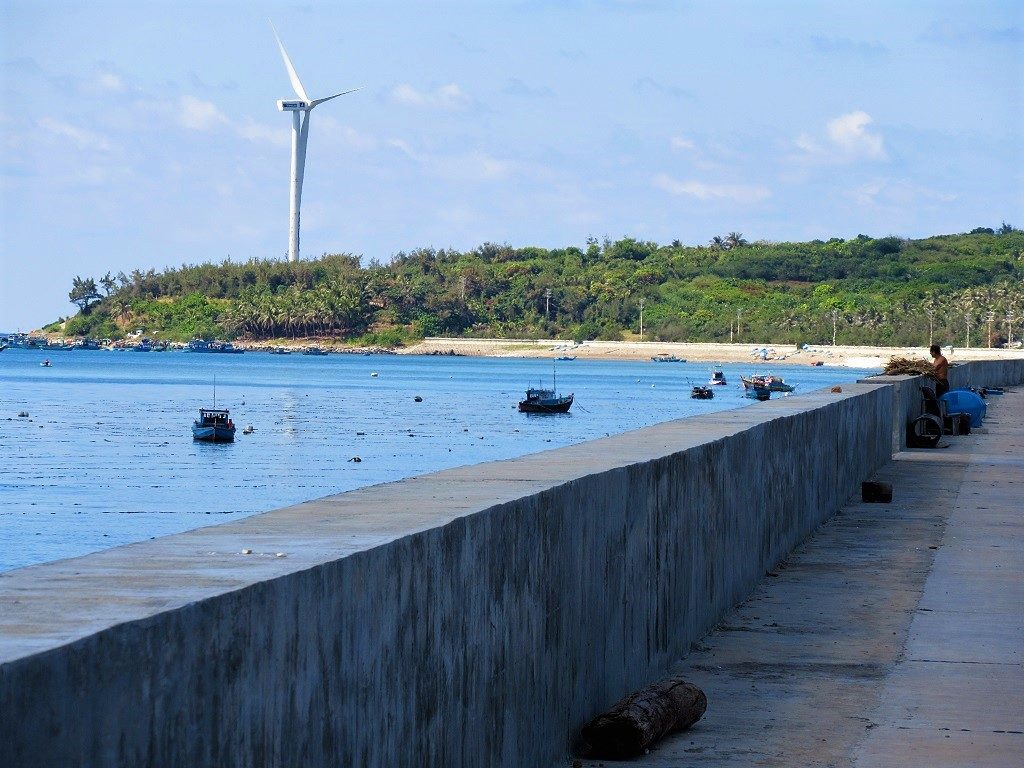
Once you are registered on the island, you can move freely but must show your permit at hotels
[Back]
GETTING TO PHAN THIET:
For the time being, all travellers to Phu Quy Island have to go via Phan Thiet. Luckily, Phan Thiet is well-connected to most cities and transport hubs in Vietnam. Rail and road connections are very good, but there’s no airport yet (it’s currently in the early stages of construction). I assume that most travellers considering a trip to Phu Quy Island will be coming from Saigon (Ho Chi Minh City), or Nha Trang further up the coast, or Dalat in the Central Highlands. Below is some information about how to get to Phan Thiet from these places by road and rail:

There are good rail & road connections to Phan Thiet from most major regional hubs
By Bus & Motorbike: There are dozens of direct sleeper buses each day linking Phan Thiet with Saigon, Nha Trang, Dalat, and many more cities besides. The level of comfort is good and tickets are inexpensive. Phan Thiet bus station is located on Tran Quy Cap Street, but many of the buses simply leave from their offices in town, especially along Ton Duc Thang Street. The journeys between Phan Thiet, Saigon, Dalat, and Nha Trang all take between 4-6 hours and cost around 200,000vnd. You can easily check bus schedules, prices, and book tickets on Baolau.com. By motorbike, the Ocean Road is a scenic way to reach Phan Thiet from Saigon. You can ride it in one day, or break the journey over two or more days. The coast road leading north of Phan Thiet to Nha Trang is fantastic. By combining the Sand Dune Highway, the Dragons’ Graveyard, and the Nui Chua Coast Road you have one of the best coastal routes anywhere in Vietnam. From Phan Thiet to Dalat there are two main routes: QL28 or QL28B – both of which meet up with QL20 to Dalat, and both of which are scenic rides.

Buses connect Phan Thiet to major cities, and there are also excellent motorbike routes to get there
[Back]
By Train: Phan Thiet train station is on a spur line (not the mainline). It’s served by an excellent daily train to/from Saigon. This is a convenient, easy, and cheap way to reach Phan Thiet. Tickets are around 160,000vnd ($7) and there’s one train a day in both directions. (Read my guide to this route here.) Alternatively, the nearest mainline station to Phan Thiet is Binh Thuan (also called Muong Man), just 15km from town. All north-south express trains stop here, linking Binh Thuan Station with other hubs, such as Nha Trang, Danang and Hanoi. You can easily search train times, routes, prices, and book tickets on Baolau.com.

Search & Book: Type your departure city & travel dates below & click ‘Search’ to find current ticket prices & availability for buses & trains to Phan Thiet:
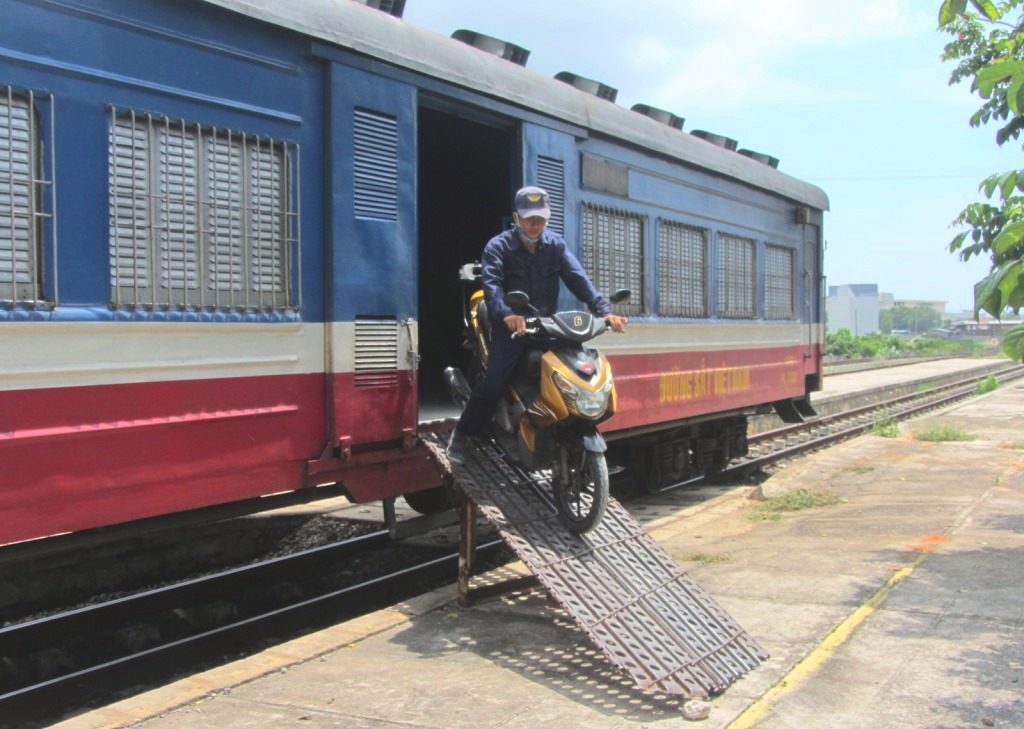
Phan Thiet has many train connection: the most convenient is the daily express to/from Saigon
[Back]
GETTING TO PHU QUY ISLAND:
By Boat: The only way to reach Phu Quy Island is by boat. There are technically three fast boat companies operating ferries to Phu Quy Island. All boats depart from Phan Thiet, on the mainland. The three ferry companies are: Superdong, Hung Phat, and Phu Quy Express. However, at the time of writing, the latter (which only recently started operations) had temporarily ceased due to technical complications. I’m informed that it should be operating again by the time you read this guide. Sailing time is 2.5-3.5 hours, depending on the boat and the weather. Note: it is possible to take your motorbike on all three ferry companies:

There are three fast boat ferry companies operating daily ferries between Phan Thiet & Phu Quy Island
At present (April 2019), Superdong is the most reliable, comfortable, and fastest of the three ferry companies sailing between Phan Thiet and Phu Quy Island. All three of the ferry companies can accommodate a dozen or more motorbikes and bicycles (see Booking Tickets for details). There are no car ferries to Phu Quy, but this is a good thing, because the peace of the island would quickly deteriorate with an influx of larger vehicles. See below for descriptions and photos of the boats:
The Superdong boats are long, low and slender, with comfortable, air-conditioned, coach-style seating on two levels, and plenty of windows. There’s deck-space out back, lots life jackets and rafts, decent, clean toilets, and some refreshments available on board. Journey time is 2.5 hours.
The Phu Quy Express is a large catamaran with two decks of air-conditioned coach seating and bunk beds (the latter are not as good as they might sound). There’s outside deck space at the back, drinks are available, and the boat is quiet, smooth and fast. Journey time is 2.5 hours. However, at the time of writing, the Phu Quy Express service was suspended due to technical difficulties. It was scheduled to recommence by the time you read this guide.

The third vessel, Hung Phat, is perhaps the most elegant: it’s a long-hulled, real ship, with an attractive pair of red and yellow-starred funnels at the back. Unfortunately, it’s the least comfortable and pleasant of the three. There are two levels of cramped wooden seats and tightly packed bunks – half of which are way below deck, near the engine room. There’s air-con and fans and a large top deck, but in general conditions are claustrophobic and the smell of ‘seasickness’ lingers in the cabins. This would be fine if the tickets were significantly cheaper, but as the difference in price is only marginal and journey time is 3.5 to 4 hours, I’d suggest choosing either Superdong or Phu Quy Express over Hung Phat.
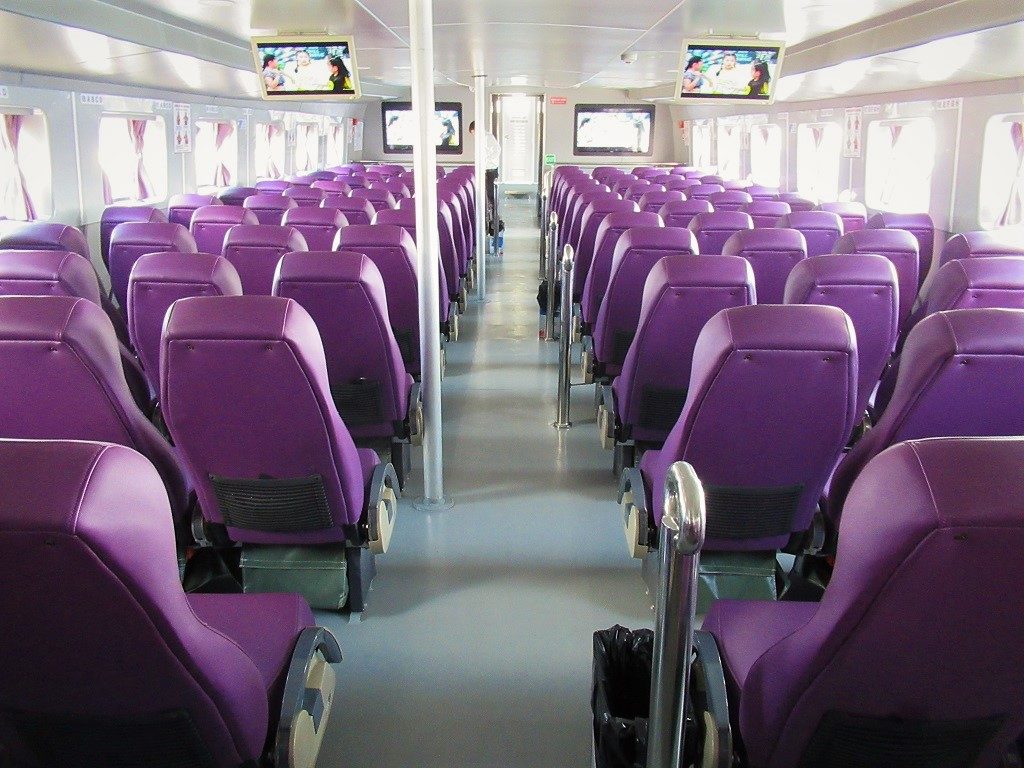
Superdong & Phu Quy Express boats have comfortable, air-con, coach-style seating

Hung Phat is an attractive vessel but takes at least an hour longer than Superdong & Phu Quy Express

The seating & bunk beds in the Hung Phat cabins are quite cramped & uncomfortable
[Back]
The Ports:
Below is a description and photos of both ports:
Phan Thiet Port [MAP] is on the east bank at the mouth of the Ca Ty River. It’s a great position, overlooking the hundreds-strong local fishing fleet as they come and go between the open sea and the safety of the walled harbour. You can enter the port from the north, at the end of Pham Van Dong Street along the riverfront embankment, or from the east, next to the Port Cafe on Vo Thi Sau Street, where the boat company offices are. At the latter, there’s a small outside waiting area, but most passengers simply order a coffee from the Port Cafe and take a seat in their leafy grounds near where the boats dock (the coffee’s pretty good, too). If you’re bringing your motorbike, you can use either entrance. The port itself is a wide, sprawling mass of exposed concrete, with a couple of picturesque old tubs rusting by the pier. Get here early, sip a coffee at the cafe, and watch your boat being loaded with supplies bound for Phu Quy Island, before it’s time for your embarkation.
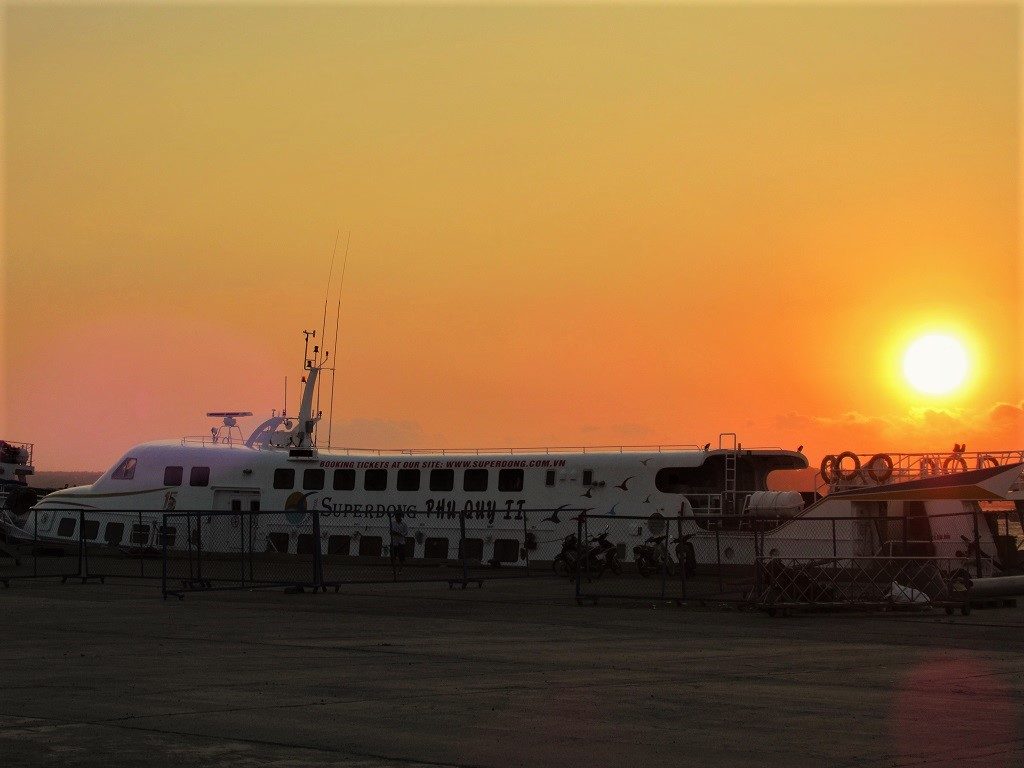
Phan Thiet Port is a large expanse of concrete at the mouth of the Ca Ty River: there’s a good port cafe
[Back]
Phu Quy Port [MAP] is located in Tam Thanh commune, near the southern tip of the island. The large, walled harbour is in a pretty location, between Hon Tranh Islet and Trieu Duong Bay, on the main island. At least a hundred large, covered fishing boats fill the harbour, and a couple of small freighters. The port is a wide, open patch of concrete that leads to a row of casuarina trees, where the boat company offices are, and a few drinks stalls. Behind the trees on the left are a couple of government buildings. One of these is the Biên Phong (border control office), where you’ll need to register with the island authorities (see Getting the Permit for details). There’s only one entrance/exit to the port: to the north, on Ngo Quyen Street.
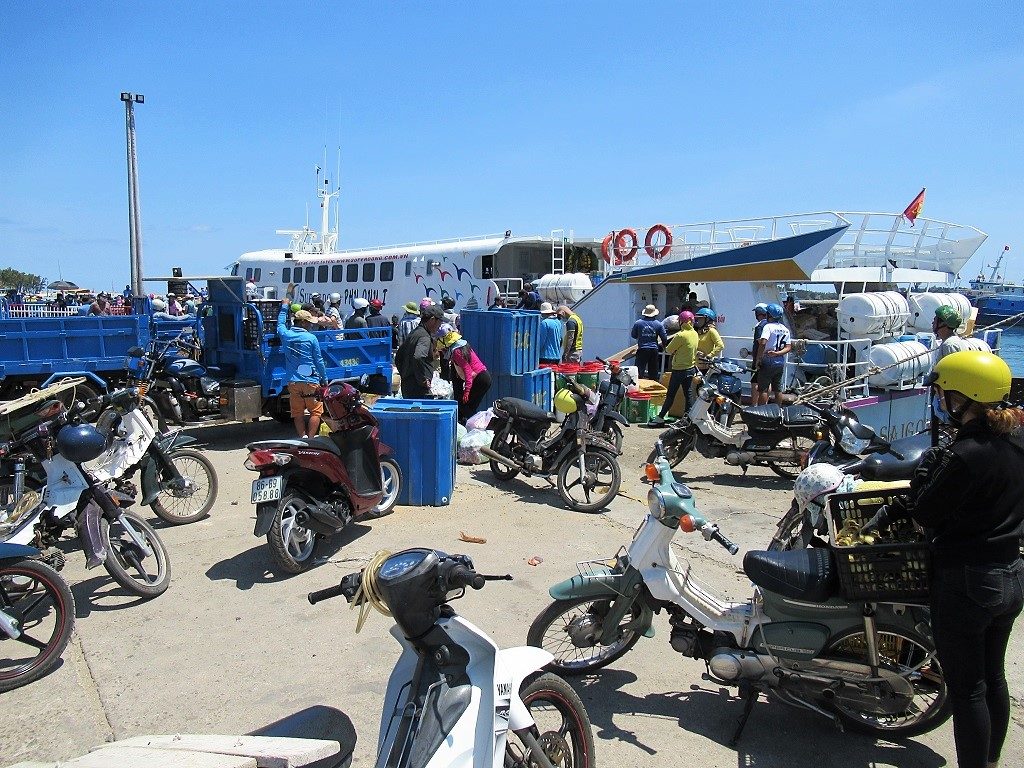
Phu Quy Port is in the south of the island: it gets busy when the boats arrive & it’s hot & exposed
[Back]
Booking Tickets:
Below is all the information for booking tickets (for passengers and motorbikes) on the boats between Phan Thiet and Phu Quy Island:
General Information: Booking tickets for any of the three boat services between Phan Thiet and Phu Quy Island is fairly easy. It’s wise to book at least one day in advance, and absolutely necessary if you’re travelling between Friday and Sunday or on a public holiday. The same goes for booking motorbikes on the boats. Booking in person is the easiest, best, and most convenient way to get tickets (over the phone and online is difficult or impossible, due to the fact that your permit must be presented). In order to book a ticket on any of the boats you must have your passport with a valid visa or residency card. When boarding the boat in Phan Thiet, you must show your passport to an official dressed in green uniform. Then, on arrival in Phu Quy, another official in green will meet you off the boat and take you to the border control office to register your passport.


As long as you have your permit, booking tickets on any of the boats is quite straightforward
[Back]
Motorbikes: To book a space for your motorbike, you need to give the license plate number and, technically at least, have the blue/green ownership card (but I was never asked to show mine). For motorbikes, the ticket payment (150,000vnd) is paid at the ticket office, but then a handling fee is charged at the ports in both Phan Thiet and Phu Quy (80,000/70,000vnd respectively).

You can book a space on the boat for your motorbike, but you must arrive at the port about an hour early
[Back]
Phan Thiet Ticket Offices: All three ferry operators have ticket offices in Phan Thiet. In addition to the addresses given below, both Superdong and Phu Quy Express have ticket booths at the port entrance on Vo Thi Sau Street, opposite the Port Cafe [MAP]:
• Superdong: 535 Tran Hung Dao Street [MAP] | tel: 0252 3 817 337 | website: www.superdong.com.vn
• Phu Quy Express: 183 Ton Duc Thang Street [MAP] | tel: 0252 3 962 727 | website: www.phuquyexpress.vn
• Hung Phat: 195 Pham Van Dong Street [MAP] | tel: 0915 380 919 | website: www.facebook.com/hungphat26
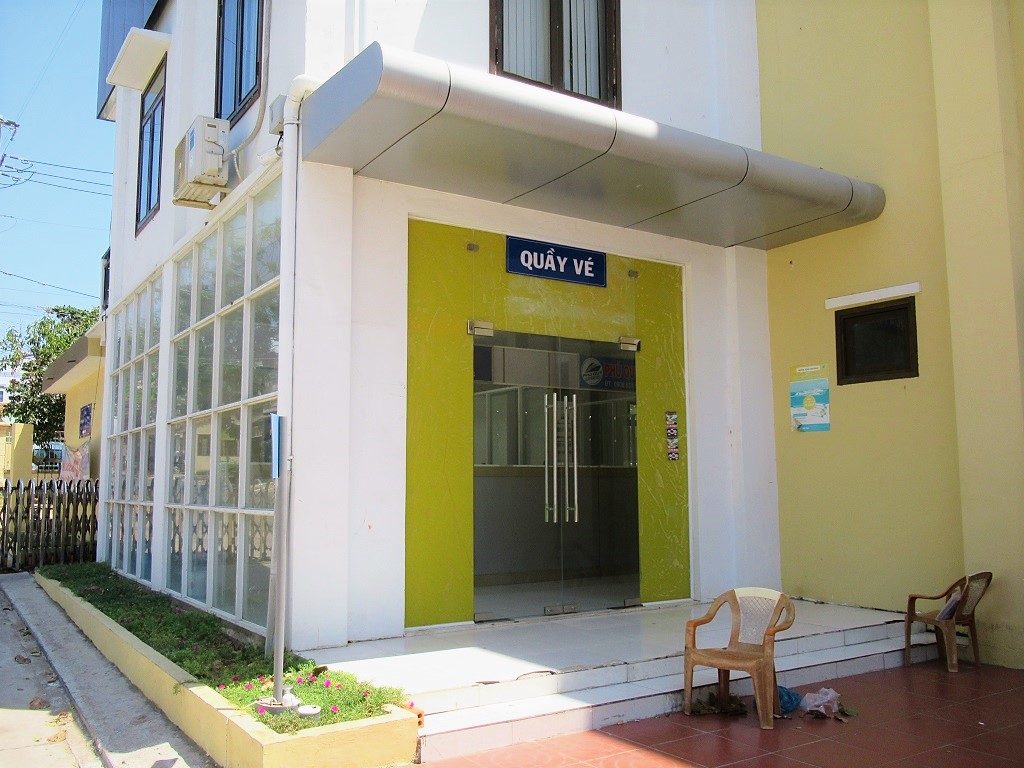
There are tickets offices at the port in Phan Thiet & each company has an office in the city
[Back]
Phu Quy Ticket Offices: On Phu Quy Island, all three ferry companies have offices in Tam Thanh commune, near the port in the southwest of the island. But they also all have ticket counters in the terminal at Phu Quy Port [MAP]:
• Superdong: 11 Ngo Quyen Street [MAP] | tel: 0252 3 765 999 | website: www.superdong.com.vn
• Phu Quy Express: 64 Vo Van Kiet Street [MAP] | tel: 0252 650 6789 | website: www.phuquyexpress.vn
• Hung Phat: 207-209 Vo Van Kiet Street [MAP] | tel: 0933 434 818 | website: www.facebook.com/hungphat26

There are ticket offices for all boat companies at Phu Quy Port & in Tam Thanh commune
[Back]
Schedules, Times & Prices:
Each of the three ferry companies issues a new schedule every month. But sailing times can change depending on the season, time of week, weather, and demand. Therefore, the times given below should be treated only as a general indication: they are not set in stone. Indeed, it’s difficult to draw-up an accurate schedule, because the times change almost every day. But, in general, you can guarantee at least one sailing a day in both directions with at least one of the three ferry companies. For current schedules, check the boat companies’ websites, or call, or drop into their offices in Phan Thiet or Phu Quy to get a print-out (see Booking Tickets for details). Always double-check the time the day before departure:
*Key: SD=Superdong; PQE=Phu Quy Express; HP=Hung Phat
PHAN THIET → PHU QUY
Departures: SD: between 7am-10am daily; extra sailing Fri-Sun | PQE: one morning or afternoon sailing every two days | HP: between 12pm-2pm daily*
Duration: SD & PQE: 2.5 hours | HP: 3.5 hours
Passenger Ticket: SD: 350,000vnd (seat) | PQE: 350,000vnd (seat or bunk-bed) | HP: 250,000/350,000vnđ (seat/bunk-bed). Discounts for seniors, children, disabled
Motorbike Ticket: SD, PQE & HP: 150,000vnd (ticket), plus 80,000vnd (handling in Phan Thiet), plus 70,000vnd (handling in Phu Quy) = Total: 350,000vnd per bike
Websites: SD: www.superdong.com.vn | PQE: www.phuquyexpress.vn | HP: www.facebook.com/hungphat26
*All times are subject to change; check websites, call, or ask at the office for current schedule
PHU QUY → PHAN THIET
Departures: SD: between 7am-10am daily; extra sailing Fri-Sun | PQE: one morning or afternoon sailing every two days | HP: between 7am-8am daily*
Duration: SD & PQE: 2.5 hours | HP: 3.5 hours
Passenger Ticket: SD: 350,000vnd (seat) | PQE: 350,000vnd (seat or bunk-bed) | HP: 250,000/350,000vnđ (seat/bunk-bed). Discounts for seniors, children, disabled
Motorbike Ticket: SD, PQE & HP: 150,000vnd (ticket), plus 80,000vnd (handling in Phan Thiet), plus 70,000vnd (handling in Phu Quy) = Total: 350,000vnd per bike
Websites: SD: www.superdong.com.vn | PQE: www.puquyexpress.vn | HP: www.facebook.com/hungphat26
*All times are subject to change; check websites, call, or ask at the office for current schedule
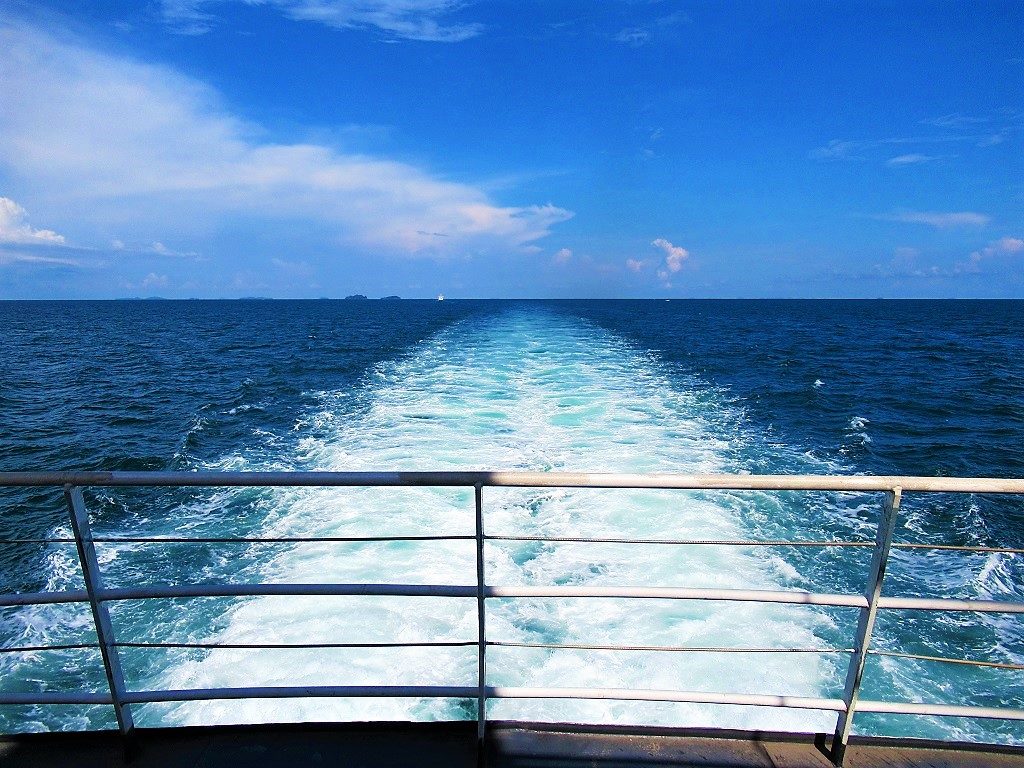
Schedules & times are subject to change, but in general you can guarantee at least one sailing each day
[Back]
GETTING AROUND PHU QUY ISLAND:
Getting around Phu Quy Island is relatively easy: the distances are short, the road network pretty good, and the terrain mostly flat:

Phu Quy Island is perfect for motorbikes or bicycles, but walking is also very rewarding
By Motorbike, Bicycle & on Foot: With its extensive network of good, quiet, paved lanes, Phu Quy is ideal for exploring by motorbike or bicycle. The coast road circumnavigates the entire island, with some spectacular vistas, and the inland roads are very lush. Motorbikes can be rented from most of the good mini-hotels and guest houses recommended above. The standard rate is 100,000-150,000vnd per day. Unfortunately, there were no bicycles for rent when I visited, but I hope this will change soon, because cycling would be a marvellous way to see the island. You can, of course, bring your own bicycle or motorbike with you on the boat to the island (see Getting to Phu Quy Island for details). There’s little chance of running out of gas, but if you need to fill up, there are several small gas stations on the island, which I’ve marked on my map.
Because the terrain is generally flat or gently undulating, and the distances are short (the island is only around 8km long and 5km wide), walking around the island is a real possibility. The roads are quiet and there are pathways through the brush, as well as good hikes up to several viewing points (see Hiking & Viewpoints for details).

You can bring your own motorbike to the island or rent one for around 100,000vnd per day
[Back]
By Boat: There is only one significant outlying island: Hon Tranh. Only a few hundred metres from the southern tip of Phu Quy Island, Hon Tranh has a great beach and can be reached by hired boat (250,000vnd per person; inquire at your hotel). Other than that, there’s good coral around some of the rocky outcrops in the surrounding ocean, which can also be visited by hire boat through your hotel. (See Hon Tranh Islet for details).
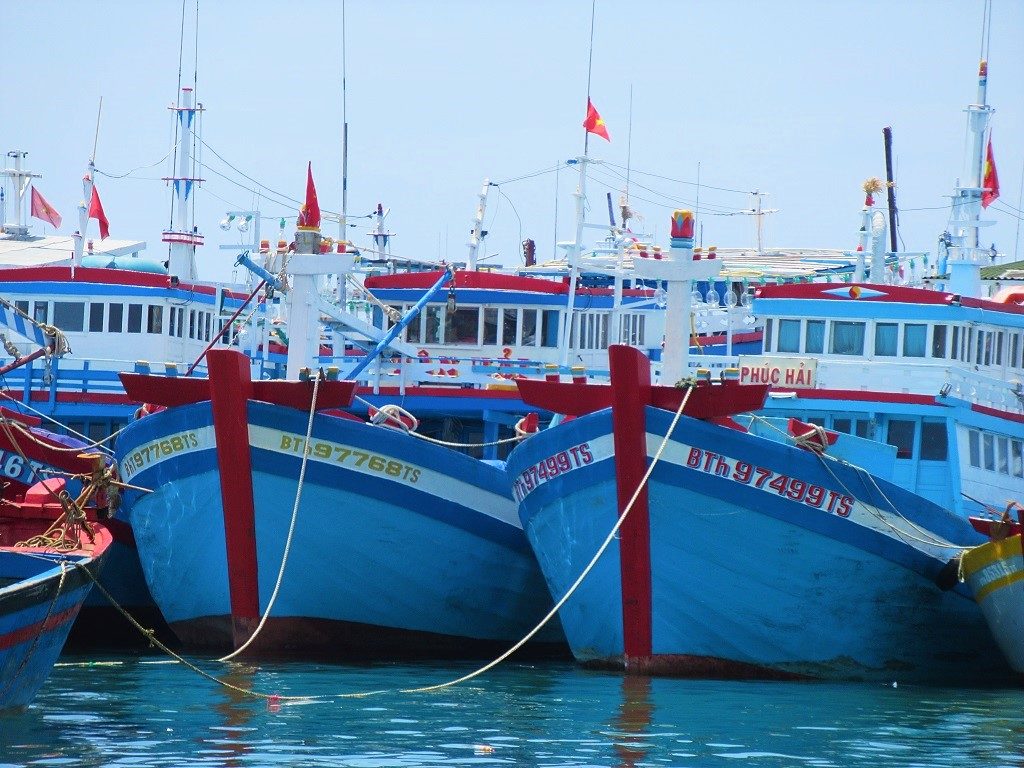
It’s possible to hire a boat to take you to Hon Tranh Islet & out to snorkel the reefs: inquire at your hotel
Weather:
Despite being an island out in the East Sea – exposed to the winds and waves – Phu Quy has a pretty good climate. The best time to visit is from December through April, when seas are generally calm, skies clear, evenings cool, and days very warm and sunny. When I first visited, in March, conditions were perfect. From May to November, Phu Quy lies in the path of tropical storms from the east, particularly around September and October. However, the wind is great for kite-surfing, which looks set to be a draw-crowd for the island in the coming years. During the bad weather, the sea can get very rough indeed, and the island feels exposed and fragile (boats are often cancelled in these months). But Phu Quy’s coastline has been secured and shored up in recent years, thanks to the construction of huge embankments, breakers, and harbour walls.
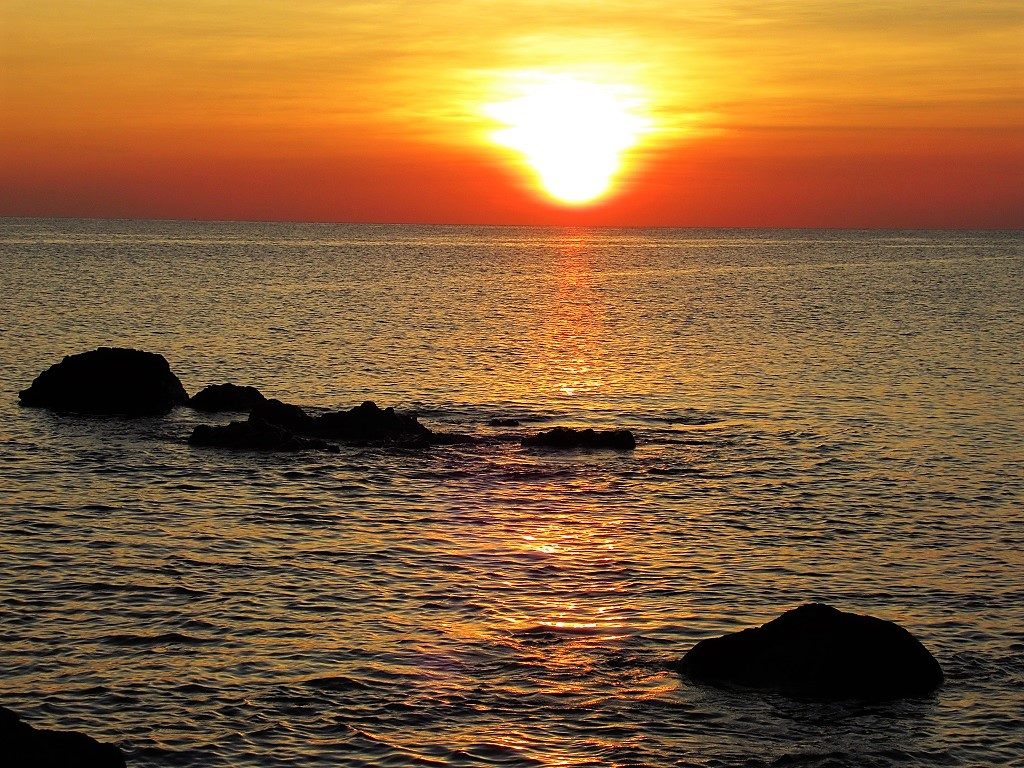
Visiting during the months January-April should mean the island is warm, dry & the sea calm
Disclosure: I never receive payment for anything I write: my content is always free and independent. I’ve written this guide because I want to: I like this island and I want my readers to know about it. For more details, see my Disclosure & Disclaimer statements here
[Back Top]

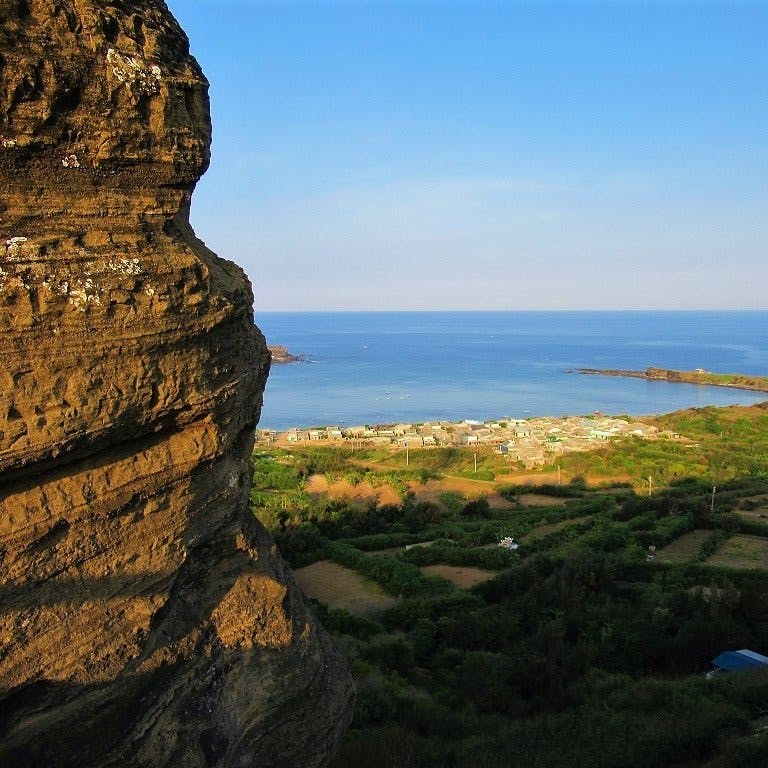
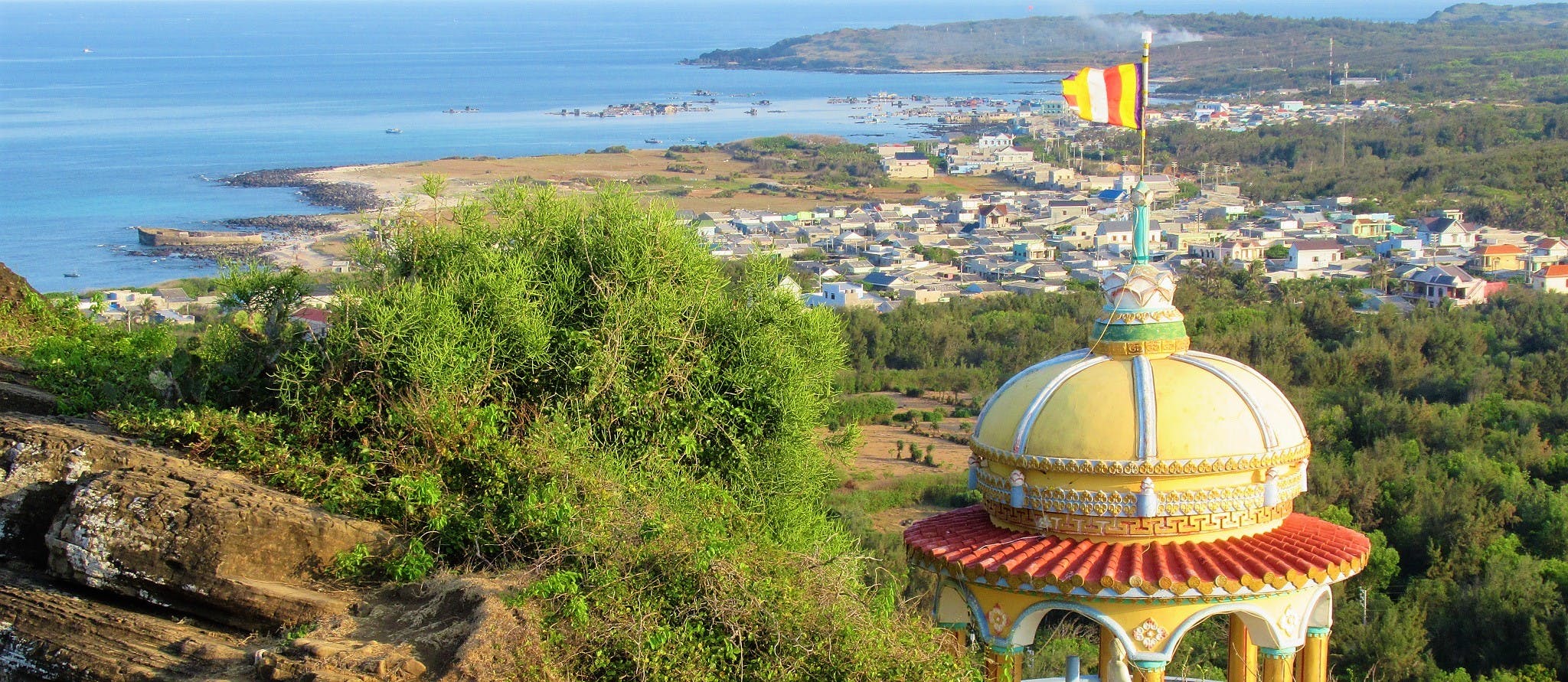
Hi!
Heading to Phu Quy for 3 nights. Did you notice a morning fish market where the fisherman offload/sell their catch or any other compelling areas to photograph “fishing life”.
Thks
Hi Mark,
Most of the villages on the coast have small fish markets in the early mornings – it’s a very small island, so just get up early and ride around the coast road and you’ll find what you’re looking for.
Best,
Tom
thanks for this wonderful post. have found it very useful!
Thanks, Vincent. I’m glad you enjoyed it.
Best,
Tom
Thank you very much for the valuable information. May I ask you how to survive being a vegetarian on the island? As I can see in your post wherein a lot of seafood available everywhere.
Thanks and regards.
Hi Arun,
It should be OK. Just look for signs or ask for ‘cơm chay’ – vegetarian food. Also, ‘ăn chay’ means vegetarian.
Best,
Tom
Thanks Tom.
Best
Thanks very much for this post. I couldn’t find much about Phu Quy so found this really helpful.
I am embarrassed to ask this question but is there good internet on the island? I am planning to go there around the time I expect to have a job interview over zoom so need to know if there is reliable internet.
Thanks!
Hi Catherine,
Generally, internet is pretty good on the island. I do a lot of work online and rarely have problems with connections anywhere in Vietnam.
Best,
Tom
Thanks very much Tom – that’s really helpful and reassuring!
We just got back from Phu Quy (15-17 Nov) and liked it very much. We found it very pristine and not touristy at all with lovely people. The more we enjoyed our dinner at Ivy‘s https://www.facebook.com/profile.php?id=100082908323443
The lovely owner speaks English and we managed to order really good vegetarian food. I can really recommend this place.
Thanks, Melanie.
Tom
An update on the Phu Quy Island.
I just took a trip from 2th-4th February 2022, foreigner requires a confirmed temporary stay letter from their ward before going on the boat to the island plus a negative quick covid test within 72 hours plus passport, your TR card is not enough, after arrival on the island, you need to register at the wharf and show the passport and Vietnam entry date stamp, all this may change in the future, going back to Phan THiet now don’t require a negaive covid test.
On the island, foreigners are not allow to go to the small Hon Tranh Island due to various reason.
The boat ride on the Superdog is rather rough and choppy, the Phu Quy Express is slower but more pleasant for the stomache.
Hi Chi,
Thank you for the updates. I imagine the extra paper work is mostly due to the pandemic. Hopefully it will be easier for foreigners to visit the island later in 2022, if things get better.
Thanks again,
Tom
Hi Tom
Do you know if Phu Quy already opened up for tourist on a tourist visa? I have some time left because of extended stay in VN till june 30 and love to go there if possible. I can’t find any up to date information myself.
Hi Bob,
I don’t know for certain, but you should be able to find out my contacting the the travel agents I list in this section of the guide.
Tom
Yes – foreign tourists are allowed back if they have obtained a permit (I have just returned from the island, also having met another foreign tourist there).
Hi Kai,
That’s good new, thanks for the update.
Tom
Hi Tom!
Really good article, so helpfull! Thanks for that. We are planning to go to Phu Quy somewhere next week but had one smalle question about the permit.
In the article you said that you have to give the adress of where you are staying in Phan Thiet to the immigration office. Do you know if it is okay to apply for a permit for Phu Quy, then go to Mui Ne and wait for it while in Mui Ne? So instead of giving them an adress in Phan Thiet, giving them an adress in Mui Ne?
We would arrive on sunday 22/12/2020, and considering waiting for the permit, we would like to spend christmas in Mui Ne..
Thanks a lot!
Wannes&Ellen
Hi Wannes & Ellen,
Yes, as far as I know you can give an address in Mui Ne instead of Phan Thiet, but I can’t guarantee it. Also, someone recently emailed me to say they were unable to apply at the immigration office, so had to do it through the travel agent instead.
I hope this helps,
Tom
Thanks a lot!
I guess we’ll just pop in to the immigration office monday morning and see how it turns out, in the worst case we’ll just have to rely on a travel agent. Would you like us to keep you updated in case that it should not be possible anymore to get the permit yourself?
Kind regards!
Wannes
Hi Wannes,
Yes, that’s a good idea. And yes please do let me know how it goes.
Good luck,
Tom
This looks right up my alley. I’m seriously thinking of going this weekend. But I’m wondering if it will be challenging traveling during the holiday. I’m based in Saigon and am able to travel to Phan Thiet on Saturday but am guessing arranging a permit would be impossible during the weekend/holiday. Is there any way to arrange a permit from Saigon? Thanks for your help. If I make it or not, thanks for this post and all its details. This is on my Vietnam to-do list for sure!
Hi Justine,
I’m afraid it would almost certainly be impossible to get the permit over a weekend, let alone a holiday weekend 🙁 But plan to go another time instead. You really need at least a few days: 1-2 days to get to Phan Thiet and get the permit; and 2 days to explore the island.
Tom